IMPACT
The official magazine of the College of Engineering, Architecture and Technology
REMARKABLE RENOVATION
ENGINEERING SOUTH REOPENS AFTER MUCH-NEEDED RESTORATION OF CEAT LANDMARK



Advance your education today 405-744-5146 | ceatonline.okstate.edu ONLINE ENGINEERING EDUCATION 100% Online Programs Also O ering Undergraduate and Graduate Online Courses • Fire Protection and Safety Engineering Technology (B.S.) • Electrical Engineering (M.S.) • Electrical Engineering (M.E.) • Engineering and Technology Management (M.S.) • Engineering Technology-Fire Safety and Explosion Protection (M.S.) • Fire and Emergency Management Administration (M.S. and Ph.D.) • Industrial Engineering and Management (M.S.) • Mechatronics and Robotics (M.S.) • Architecture • Construction Management Technology • Electrical and Computer Engineering • Electrical Engineering Technology • Engineering Sciences • Fire and Emergency Management • General Engineering • Industrial Engineering and Management • Material Sciences and Engineering • Mechanical Engineering Technology ONLINE LEARNING College of Engineering, Architecture and Technology
36 On the Cover CEAT celebrates reopening of Engineering South after extensive renovation on historic building. (Cover photo by Phil Shockley)
12
Needing a Bigger Boat CEAT professor conducting shark bite research with help from Oklahoma Aquarium and Australian company.
24
Saying Goodbye
Dr. Paul Tikalsky is stepping down as CEAT Dean after more than a decade at the helm.
44 An Impactful Anniversary
Ten years after announcement, Dolese gift keeps on giving to CEAT.
58
High-Profile Visit OSU welcomes Secretary of Energy to Stillwater, CEAT receives government grant.


3
74
DEAN, COLLEGE OF ENGINEERING, ARCHITECTURE AND TECHNOLOGY
Paul Tikalsky, Ph.D., P.E., F.ASCE, F.ACI, EACR
MARKETING MANAGER
Kristi Wheeler
EDITOR
Jordan Bishop
LEAD WRITER
Je Hopper
WRITERS
Mack Burke, Brenna Davis Long, Dakota Keith, Grant Ramirez, Bailey Sisk, Mak Vandru , Kristi Wheeler and Alyssa Williams
ART DIRECTOR
Dave Malec
LEAD DESIGN
Cody Giles
CONTRIBUTING DESIGN
Ben Champlin
PHOTOGRAPHY
Hannah Davis, Je Hopper, Dakota Keith, Gary Lawson, Phil Shockley, Kristi Wheeler and Alyssa Williams
IMPACT is a publication of the Oklahoma State University College of Engineering, Architecture and Technology and is designed to provide information on college activities and accomplishments while fostering communication among the CEAT family and friends. CEAT.OKSTATE.EDU
The o ce of publication for IMPACT is 307 Whitehurst, Stillwater, OK 74078-1024. ©2023, IMPACT. All rights reserved.
Oklahoma State University, as an equal opportunity employer, complies with all applicable federal and state laws regarding non-discrimination and a rmative action. OSU is committed to a policy of equal opportunity for all individuals and does not discriminate based on race, religion, age, sex, color, national origin, marital status, sexual orientation, gender identity/expression, disability, or veteran status with regard to employment, educational programs and activities, and/or admissions. For more information, the director of equal opportunity/Title IX coordinator is located at 401 General Academic Building and can be reached at 405744-1156 or by visiting https://eeo.okstate.edu.

This publication, issued by Oklahoma State University as authorized by the College of Engineering, Architecture and Technology, was printed by Modern Litho, at a cost of $11,297.37/4M/August 2023/#9867.

Plus …
Dean’s Letter
Winners
Printing Concrete
CAREER Awards
Top
of
Donors
4 Scholarship
18 Arena’s Impact on Aerospace 32
Structures 48
63
Honors 64 Hall
Fame 70
CEAT Leadership
IN THIS ISSUE
12 36 24
OSU CEAT 1
58

Visit OSUgiving.com YOU CAN CHANGE THE WORLD AT OSU! Your philanthropy helps the College of Engineering, Architecture and Technology educate and produce the next generation of thinkers and problem solvers. They will create solutions to the challenges that a ect our communities, nation and world. READY TO MAKE A GLOBAL IMPACT? ORANGE IS THE ANSWER.
From the Dean
Greetings!
Welcome to a new year of IMPACT.
We have many exceptional things happening here in the college and I’m excited to be a part of it!
This year, we launch the newly remodeled Engineering South, housing the schools of Electrical and Computer Engineering and Mechanical and Aerospace Engineering. It will also be home to the new Zink Center for Competitive Innovation, designed to prepare and transform our students into ethical, next-generation leaders, whose grit, innovation and competitive spirit will make the world a better place for everyone.
Engineering South isn’t the only grand opening you will read about! We are also launching the nation’s very first vehicular-mounted, 3D concrete printed building, designed and printed by Dr. Tyler Ley. You’ll read about world-class research our faculty and students are engaged in such as shark bite resistant materials, beehives and decreasing greenhouse gas emissions.
Our faculty are engaged in the cutting edge of energy, aerospace, computing, sustainable building technologies and our nation’s future. They are building on the landgrant university mission to provide educational opportunities to every community.
It has been an honor and a privilege to serve as the dean of the College of Engineering, Architecture and Technology for over a decade. In the last 11 years, we have seen a transformation occur with the help of donors, university leadership, faculty and sta rethinking the strategic direction of the college.



The college has seen record freshman retention rates, degrees, 4-year completion rates and increased research expenditures. I am proud to have raised more than $250 million to support world-class learning facilities and programs, scholarships, endowed chairs, industry research partnerships and K-12 STEM education programs.

In the last 11 years, 62% of the current faculty in the college were hired, 22 of our graduates have been accepted for graduate study at Cambridge University, six have been named Goldwater Scholars, CEAT has awarded record numbers of degrees, and more of those students are completing degrees in four years than ever before. The studentoperated CEAT Career Fair has drawn over 220 companies. Our Extension units continue to engage in all 77 counties of Oklahoma, 50 states and all seven continents.
I am honored to have led the college through these accomplishments, but I could not have done it without you.
It is time now for me to step down and turn the reins over to someone else. It has been a privilege serving the college and the university, a time in my life that I will always reflect on as being pivotal moments for me in my career.
I will continue to serve as a faculty member in civil and environmental engineering for two years, and then will return to my roots in Wisconsin where my wife and I will live on the coastline of Lake Michigan.
One thing I know for certain, we will continue to be leaders in the nation. We will continue to solve industry and world challenges. We will continue to be leaders and innovators in education, research and Extension.
I hope you enjoy this edition of IMPACT.
GO POKES!
Paul Tikalsky Dean, College of Engineering, Architecture and Technology Oklahoma State University
PHOTO
PHIL SHOCKLEY
OSU CEAT 3
In Their Own Words
From CEAT’s 2023 W.W. Allen Scholars
Earning a scholarship can change your entire college career, but it is a competitive process.
In Oklahoma State University’s College of Engineering, Architecture and Technology, the W.W. Allen Scholars Program o ers engineering students over $135,000 in scholarship and enrichment, industry networking, study abroad, mentorship, an annual scholarship of $7,500, plus full tuition and housing for a master’s degree at the University of Cambridge.
2023 W.W. Allen Scholars
The W.W. Allen Boys and Girls Club Scholars Program awards an incoming freshman between $19,000-$55,000 per year for up to four years of study toward a bachelor’s degree in engineering. This includes an OSU tuition waiver between $4,000-$40,000 and an annual CEAT scholarship of $15,000. Additionally, each scholar will participate in funded enrichment, travel and networking opportunities. Each year, only one W.W. Allen Boys and Girls Club Scholar is selected.
Here is what our 2023 Allen Scholars had to say.
SHERIDAN SHERRER
NORMAN NORTH HIGH SCHOOL
MAJOR: INDUSTRIAL ENGINEERING AND MANAGEMENT
Math has always been my strength because it is like a logic puzzle waiting to be solved. My skill of organizing data appeared when I created the SPUD (Philanthropy at Norman North) records committee. My organizational skills helped us to surpass records in money raised ($257,000) and service hours performed. I also really enjoy working with all di erent types of people. I think a degree in industrial engineering will allow me to use my natural skills in math, data analysis, organization and leadership to make a di erence in my community. It will perfectly combine my love of math with my ability to work with people.
One of my favorite things about industrial engineering is that it is about creating more e ciency for people. I want to create a way for all people to find shortcuts to make life easier and better. Once I realized I was interested in industrial engineering, I interviewed a lady who had graduated

PHOTOS PROVIDED 4 IMPACT 2023
with an industrial engineering degree. She talked about how one of her biggest projects was organizing tools at a factory in a way that they took up less space and didn’t get lost. She made it clear to me that to be an industrial engineer, you have to think outside the box, which is something I love to do. I also really want to make a di erence for people even if it is something as small as organizing tools.
I think one of the most important things I can take advantage of is the opportunity to meet people from all over the world who speak and work di erently. I plan to continue to make a di erence in the communities I am in. Leadership, philanthropy and community service matter deeply to me. Diversity creates a better group; di erent gifts and ways of looking at things bring success. Details and double checking are a strength of mine, but I am also good at working in a team and making it the best that it can be. I can learn from watching and working with others to learn from their strengths.
I want to participate in research while at Oklahoma State University. I believe that learning through experimentation creates an understanding of a subject that others may miss. This fact has created in me a drive to not just accept what my teachers tell me, but to figure out for myself how what they are teaching will shape my future. I think research would help me to better understand and apply the concepts I am learning in class to the real world.
Leaving my mark on the world is my goal. I want to positively impact the greatest number of human beings using my mathematical gifts, global thinking style and high level of education in which I was blessed. Intelligence does not make a di erence if we keep it to ourselves. We must work in a team with clear communication and measurable goals to make a di erence.
A high-level education from OSU and then Cambridge would put me in a place where I could get a job in a company that a ects numerous people. An industrial engineering degree gives me many options to help others. I can do something small like organize distribution of goods, or I can do something big like draw out the theme park lines for Disney. Being around gifted students and connected professors will help me excel in making a bigger di erence in the world.
In 25 years, my company and I will have organized many systems that will have made an impact on numerous businesses. At that point in my career, I will be successful enough to focus on the next generation of young leaders.
As a member of Leadership Oklahoma, I got to see firsthand the
need for young professionals like me to stay and make a mark on our state. I love Oklahoma and I plan to make a di erence for people all around our state. I also plan to be able to give back to the place that made my success possible, Oklahoma State.
“Leaving my mark on the world is my goal. I want to positively impact the greatest number of human beings using my mathematical gifts, global thinking style and high level of education in which I was blessed. Intelligence does not make a di erence if we keep it to ourselves.”
SHERIDAN SHERRER
OSU CEAT 5
DAYTON MCCALL
BARTLESVILLE HIGH SCHOOL
MAJOR: INDUSTRIAL ENGINEERING AND MANAGEMENT
3…2…1…Blast O ! Suddenly, you’re hurled at a speed of 60 miles per hour, and it’s pitch black. Where are you? You’re at the best ride in Disney World, the “Rock ‘n’ Roller Coaster” which triggered my initial interest in engineering.
I was 12 when I first rode the coaster, and my initial focus was the thrill that the ride provided. As an adrenaline junkie, I loved being shot into the dark and immediately going into an upsidedown flip followed by a barrel roll. Ending with insane deceleration always left me exhilarated and wanting more. I’ve always been curious about how things work, and after a few rides, I started to wonder about how the roller coaster functioned.
I mentioned this to my dad, and hal eartedly listening, he replied, “It’s all physics, but did you know the engineers designed not only the ride but also the line to get to the ride and the overall flow of people throughout the park?”
I replied, “If engineers designed the lines, why are we waiting so long? There must be a better way.”
He responded, “Maybe there is, and given your impatience, you can be the one who figures it out.”
It was the first time I had given thought to being an engineer. Maybe I could design roller coasters or, even better, get people to the ride more quickly.
During school, I discovered I had an aptitude and strange enjoyment for advanced mathematics. I knew I wanted a career that utilized math, and taking an engineering and design class reinforced my interest. My interest in this field was further reinforced by my internship as a sustainability engineer at ABB Inc. in Bartlesville, Oklahoma. Through my internship, I learned small improvements in design and production can make a big di erence in large-scale manufacturing. The experience was fascinating because I

6 IMPACT 2023
observed how engineering could not only reduce production time but also manufacturing waste. What started as a simple question in line for the Rock ‘n’ Roller Coaster has expanded into a desire to pursue a degree in industrial engineering where I can focus on process improvement. I’m interested in reducing uncertainty and improving e ciency within processes and systems, helping eliminate waste, conserve water usage and possibly reduce wait times.
My plan for my time at OSU is to obtain an education while gaining exposure to new ideas and experiences. First, and foremost, I am attending college to obtain a degree, so learning as much as I can is extremely important to me. I plan to supplement classroom learning by obtaining relevant real-world experience through course projects and participation in undergraduate research. I am excited to learn and conduct hands-on research in the lab myself and participate in more formalized undergraduate research opportunities or programs.
An additional goal I have set for myself is to pursue an Honors College degree. Participation in the Honors College will allow me to work on my verbal and written communication skills, as well as participate in conversations that challenge my current way of thinking. Achieving my goal of graduating with an Honors College degree will enrich my overall learning experience.
Continuing my education by obtaining a master’s degree in liberal arts will expose me to new and di erent ways of thinking. Most engineering students are inclined toward math and science and approach issues from a logical and linear way. Liberal arts will expose me to students from di erent backgrounds, immersing me in an environment of diversity of thought and increasing my awareness of ideas beyond an engineering perspective.
I recognize the importance of being a continuous learner. In addition to a
master’s degree, I plan to continue my education outside the classroom by participating in training, seminars and pursuing professional certifications. Involvement in these activities will ensure my knowledge base remains relevant. Furthermore, consistent exposure will keep my mind agile and receptive to new ideas. In my career, I plan to be a leader. The knowledge I gain from studying liberal arts will strengthen my leadership capabilities by building empathy, understanding and the ability to communicate with others. Understanding that my solution is not always the only right solution and developing an appreciation for ideas that di er from my own will make me a stronger and more well-rounded leader.
I truly believe learning is a lifelong process and through advanced study and continuing to pursue educational opportunities, I can become the best version of myself.
The best leaders are visionaries with expertise in their field who can inspire, empathize and appreciate diversity of thought. Combining a Bachelor of Engineering degree and a Master of Philosophy degree will allow me to graduate with both technical skills and a stronger appreciation for di erent perspectives and ideas. Within 25 years of graduation, I plan to utilize these skills to create and lead an Oklahomabased sustainable engineering firm focused on reduction of industrial waste and conservation of water.
“Understanding that my solution is not always the only right solution and developing an appreciation for ideas that di er from my own will make me a stronger and more well-rounded leader. I truly believe learning is a lifelong process and through advanced study and continuing to pursue educational opportunities, I can become the best version of myself.”
DAYTON MCCALL
OSU CEAT 7
2023 W.W. Allen Boys and Girls Club Scholar
MALLORY REED DURANT HIGH SCHOOL

MAJOR: MECHANICAL ENGINEERING
When looking for an opportunity to give back to my community, the Boys and Girls Club was a natural draw. I have been fortunate to grow up in a community with a revitalized Boys and Girls Club and got to witness many friends benefit from its programs including the after-school program, summer activities and sport programs. Having seen the positive impact the Boys and Girls Club had on my friends and my community as a whole, I wanted to help continue that legacy.
At my local Boys and Girls Club, I have been an active volunteer during the 2022-23 school year. During my time as a volunteer, I helped kids in the after-school program reach their full potential through encouragement and demonstrating the characteristics of a model citizen. I also served as a mentor to any kids who needed extra help with schoolwork, encouraging them to reach their full potential to become productive, responsible citizens through hard work, determination and goal setting.
The Boys and Girls Club opened my eyes to a new perspective on the lives of others. Growing up, I had great parents who believed I could succeed and always encouraged me to be the best version of myself that I could be. While I knew not everyone was as lucky as me to have people who believed in their aspirations, I did not fully grasp how much the lack of support can a ect someone. There were many kids at the club that didn’t have a good support system at home. Every time I would complement a kid’s drawing or congratulate them on memorizing their times tables, I could see the way their faces lit up. In these moments, I realized how much of an impact my kindness and encouragement have on these kids’ lives. In those moments I am these kids’ support system, just like my parents were my support system. Because of the Boys and
8 IMPACT 2023
Girls Club, I’ve come to truly understand the impact an unsupportive home life has on kids. But more importantly, I’ve learned that I have the ability to help give these kids the support they need to become the best version of themselves, which, in turn, helps the entire community.
As a kid, the subject I found to interest me the most was mathematics. The concept of math instantly clicked inside my brain and, as a natural problem solver, I saw math as more of a fun puzzle waiting to be solved than schoolwork. As I got older and started thinking more seriously about potential career paths, I came across the wide field of engineering. At first glance, it honestly didn’t sound very interesting to me. I couldn’t see myself being fulfilled with a career in engineering. It wasn’t until my sister went to college to study chemical engineering that my eyes were opened to the true nature of engineering. She told me about di erent projects and experiments she did during her freshman year, and I realized there was much more to engineering than solving equations all day. Engineering requires creativity and critical thinking to solve problems and help those around
us in a very real, tangible way. Once I understood the impact that engineering has on all the advances around me, I knew it was everything I was looking for in a career.
At OSU, I plan to use the unique and specialized opportunities available to help further my education, while also seeking to expand my horizons past my comfort zone. One way I plan to accomplish this is to take advantage of the multitude of resources at OSU, such as the ENDEAVOR lab, to gain experience in researching and exposure to the latest technology. Understanding and participating in research will help me understand the process and contribute to advancements in the field. I want to utilize all of these opportunities OSU o ers so I can be a driving force toward the advancement and success of future engineering projects.
After graduating from OSU with my bachelor’s degree in engineering, I plan to complete a master’s degree in orthotics and prosthetics and acquire the certification to become a prosthetist. After graduating with my master’s degree, I plan to seek employment with a medical device company where
I can work as a prosthetist, but also contribute to groundbreaking research on the technological side of prosthetics. As I gain more experience and move up in the company, I plan to become a leader on the research team. With that success, I want to mentor and inspire others in their career paths, specifically those populations who are underrepresented in engineering. I want to encourage women and Native Americans, in particular, who possess the necessary skills and abilities to consider engineering as a viable option for them. And, for those with the drive and passion for engineering, I want to help mentor them in their career path. With my engineering education combined with my experience, I can contribute to the prosthetic field in a significant way that moves the advancement of the technology forward, while also advancing the company and my coworkers. I will strive to achieve all of these goals in order to help those in our community in need of cuttingedge prosthetics, but also to help mentor the engineers that come behind me, especially women and Native American engineers.
“Engineering requires creativity and critical thinking to solve problems and help those around us in a very real, tangible way. Once I understood the impact that engineering has on all the advances around me, I knew it was everything I was looking for in a career.”
MALLORY REED
OSU CEAT 9
Impact Defense
OSU and Tinker Air Force Base sign an immediate, impactful partnership agreement

Oklahoma State University is going into the wild blue yonder.
OSU and Tinker Air Force Base have signed a cooperative research and development agreement (CRADA), which will develop technology that directly impacts the readiness of the United States Air Force.

The agreement will allow students, faculty and sta at OSU to work together with engineers and technicians at Tinker Air Force Base to research, develop and employ technology that will provide a faster, safer, higher quality and more cost-e ective means of maintaining and upgrading existing and new aircraft.
“This partnership will allow research that will help improve maintenance operations in the depot to better advance the readiness of our Air Force,” said Maj. Gen. Je rey King, commander of the Oklahoma City Air Logistics Complex at Tinker Air Force Base. “These aircraft provide no support sitting in the depot. The faster we can accomplish maintenance on each aircraft, the faster we can get them back in operation for our men and women serving around the world.”
As part of a larger educational partnership agreement, this CRADA addresses an immediate need of Tinker Air Force Base and will provide students and faculty in the OSU College of Engineering, Architecture and Technology the opportunity to make a direct impact on the nation’s armed forces. Specifically, this research opportunity will facilitate technology insertion and process improvement for removing the many and various aircraft and engine fasteners, an essential step in depot operations.
“This agreement gives us a real-world, impactful way to exercise our research expertise in a way
that benefits society almost immediately,” said Dr. Kenneth Sewell, vice president for research at OSU. “This puts a real-world problem in the hands of our students and provides them with experiential research training that they wouldn’t experience under normal circumstances.”
The research conducted under this CRADA will supplement each participating student’s educational experience and create a more knowledgeable, experienced graduate that is more prepared to enter the workforce and address the growing engineering needs of the state of Oklahoma and the nation.
“Our graduate and undergraduate students benefit from understanding the engineering challenges facing the Air Force in sustaining aircraft and engines,” said Dr. Kurt Rouser, assistant professor in the School of Mechanical and Aerospace Engineering, serving as the University Technical Point of Contact for the CRADA. “This opportunity will enhance a pipeline of talent uniquely prepared for the aerospace maintenance, repair and overhaul industry that has a national hub situated at the crossroads here in Oklahoma.”
While addressing a very specific, immediate need, the CRADA also provides a foundation for the partnership between OSU, Tinker Air Force Base and the United States Air Force to build upon — a partnership that the leaders at OSU believe is their obligation.
“We, as a university, see it as our role to contribute, not only to our local community and our state, but to our nation, as part of our land-grant mission,” Sewell said.
STORY JEFF HOPPER | PHOTOS GARY LAWSON AND KRISTI WHEELER
OSU CEAT 11
Members from Oklahoma State University and Tinker Air Force Base, including Dr. Kurt Rouser (standing far left), Maj. Gen. Je rey King (seated left), Dr. Paul Tikalsky (standing center) and Dr. Kenneth Sewell (seated right), were on hand for the signing of a cooperative research development agreement between the United States Air Force and OSU’s College of Engineering, Architecture and Technology.
OSU-Tulsa researchers not afraid to test the jaws of sharks
RESEARCH BITES RESEARCH BITES
Oklahoma likely isn’t the first answer if someone were asked where shark bite research is conducted.
However, Dr. Jim Smay, the head of the School of Materials Science and Engineering at Oklahoma State University-Tulsa, is doing just that, with the help of the Oklahoma Aquarium and Ironskinn, a company based in Australia and New Zealand, producing shark bite resistant garments for water sports enthusiasts and commercial divers.
CREATING AN IRON SKIN
Swimming safely with sharks is a problem that is hundreds of years old, however the most recognized and often used shark bite mitigation measure was only devised in the 1960s
and ’70s, a chainmail suit worn over a wetsuit.
This medieval invention does help mitigate the e ects of shark bites, but is extremely heavy, expensive and cumbersome for the wearer.
As an avid water sports enthusiast, John Sundnes was spearfishing o the coast of California and while surrounded by the remnants of speared fish, he worried the remains might attract sharks. He began thinking how his suit would withstand a shark attack, and wondered if a better solution was available. After searching patent databases, he soon realized that advancements past chainmail were almost non-existent. Thus began the creation of Ironskinn.
“I never thought much about shark bite deterrents or convincing
STORY AND PHOTOS JEFF HOPPER 12 IMPACT 2023
a shark not to bite,” said Sundnes, the executive director of Ironskinn. “Instead, it seemed prudent to study the physics of a shark bite and find a solution to mitigate the damage a shark bite can inflict.”
This approach led Sundnes and his team to begin developing a lighter, more mobile and more cost-e ective solution with the help of materials scientists, professional divers and water sports experts.
After tireless research and development, Ironskinn released a high-strength, alloy plated suit that commercial divers could wear and was nearly a quarter of the weight of a chainmail suit while in the ocean, provided more mobility and cost less to produce. This system not only helped mitigate the e ects of a shark bite, but o ered a safer dive environment if something were to malfunction in their buoyancy compensating devices.
“If you’re diving and something goes wrong with your buoyancy device,
a chainmail suit would continue to weigh you down and is di cult to get out of,” Sundnes said. “Our suit is so much lighter that a diver can wear a weight belt and if something goes wrong, they can get rid of the weight belt and make it back to the surface safely.”
The company also developed a soft armor system that uses specific high strength materials in specific configurations. This suit o ers the same mitigation solution for shark bites as the armor plate suit but can be created with positive or near neutral buoyancy and can be used in virtually any ocean sport.
RIGHT ENVIRONMENT
During research and development, the Ironskinn team discovered that 64% of shark attacks across the globe can be attributed to three species of sharks, the great white, tiger and bull sharks, according to the International Shark Attack File.
What better way to determine the e cacy of a product than to put it in the jaws of a species most attributed to shark attacks? However, finding a controlled, replicable environment to conduct testing was no easy task. There are very few aquariums in the world that house any of these three species of sharks.
Oddly enough, the Oklahoma Aquarium in Jenks happens to boast the world’s largest population of bull sharks and is the only such exhibit in the Western Hemisphere. The Oklahoma attraction houses 10 of the “most dangerous sharks known to man,” a moniker granted due to their ability to

OSU CEAT 13
A material sample is put to the test using a great white shark tooth.
DID YOU KNOW?
The Oklahoma Aquarium in Jenks boasts the world’s largest population of bull sharks and is the only such exhibit in the Western Hemisphere.
• (918) 296-3474
survive in both fresh and saltwater and they have the strongest bite force of any shark species.
“Our aquarium has a 100,000 gallon, o -exhibit holding space, which allows our sta to raise these sharks from pups to exhibit size,” said John Money, the deputy director of the Oklahoma Aquarium. “Once they have reached an adequate size, we transfer them to our half million-gallon display tank.”
This collection of bull sharks provided the perfect opportunity to test these mitigating garments in a more controlled environment that would be less intrusive to both testers and sharks.
JAWS OF TESTING
The Oklahoma Aquarium would be an ideal environment for testing, however Sundnes and the Ironskinn team wanted verifiable numbers they could use for future development and to help create a standardized criteria for any shark-bite resistant materials.
Coincidentally, the OSU-Tulsa campus is home to the School of Materials Science and Engineering, which is perfectly qualified to provide the expertise necessary to conduct these experiments and procure the data
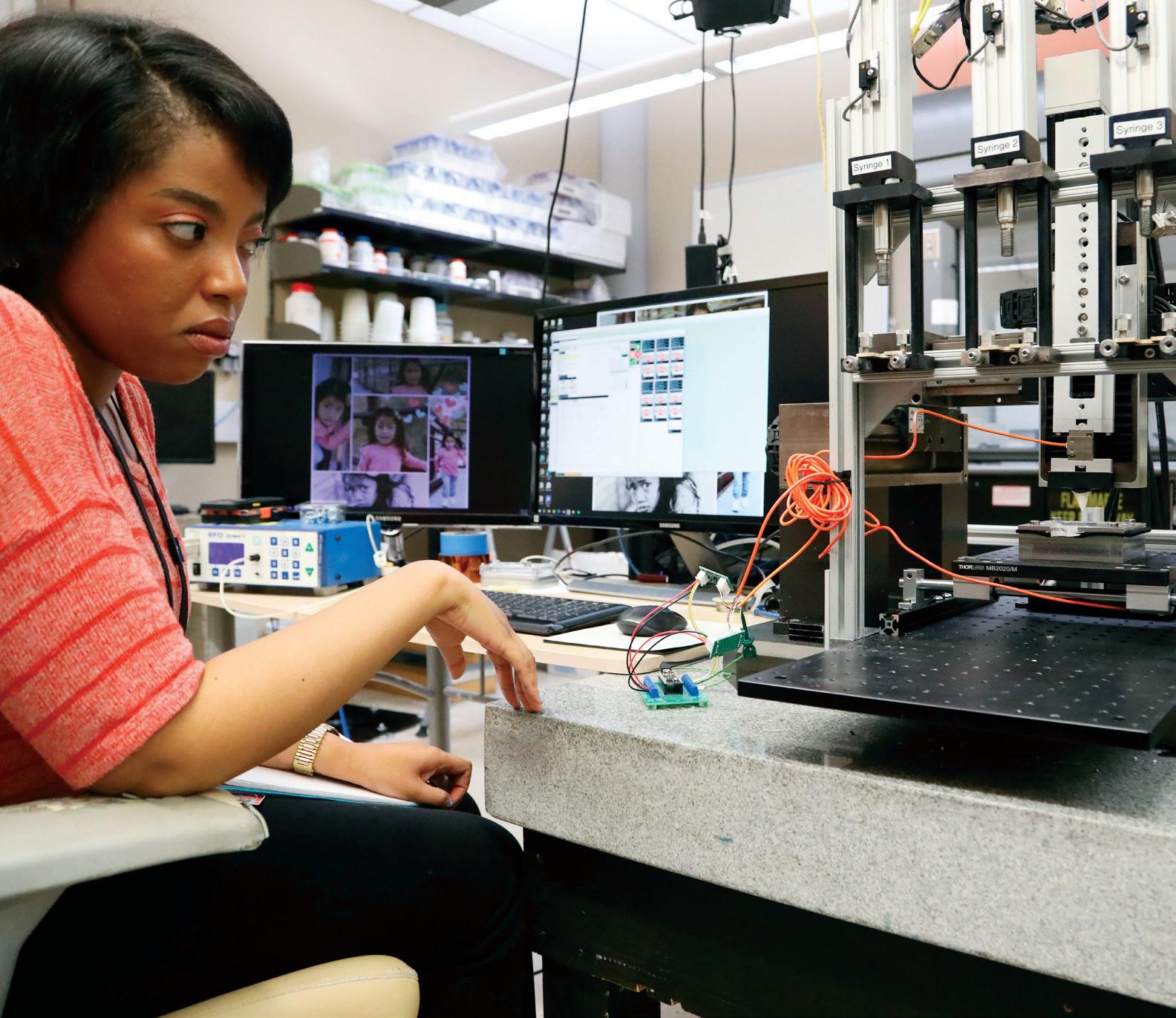
necessary to verify the e cacy of the Ironskinn products.
Smay was tasked with creating experiments that would provide replicable results and prudent data for not only Ironskinn, but the scientific community. The engineering team, consisting primarily of Smay and Ashley Pennyman, a master’s student in materials science, devised an experiment that would secure a piece of feed, in this case salmon, and a mesh sock that contained pressure sensing instrumentation to a plastic board that was then covered with the protective material. This part of the apparatus would be used to document the normal bite forces.
The second part of the apparatus was a boom equipped with steel cable that also had a tension sensor used to document line tension during a bite. The tension force measured would be
equivalent to the lateral or tearing forces experienced during the thrashing motion after an initial bite occurs. While there is pre-existing research on the compressive bite forces from sharks, this research appears to be one of the first e orts to measure lateral forces exhibited in shark bites, from violent shaking often exhibited.
“We felt that this setup would adequately document the forces we intended on measuring,” Smay said. “We were measuring upwards of 100 pounds of line tension during a thrashing motion.”
After several trials, Smay determined that while the experiments encouraged a bite, it was hard to accurately determine several variables, namely the number of teeth involved in a bite, and the location in the mouth
• 300 Aquarium Dr, Jenks, OK • www.okaquarium.org
• SUN-SAT: 10AM-6PM
14 IMPACT 2023
Master’s student Ashley Pennyman explains how the one-of-a-kind test apparatus operates.
it occurred. Both variables are key in correlating forces measured with the type of bite.
“No two bites are the same,” Smay said. “These factors are nearly impossible to determine even after posttest inspection. It was this variability that led to the development of a lab test.”
The OSU-Tulsa team began researching, designing and building a one-of-a-kind test apparatus that could mimic the normal forces or bite force, as well as the lateral or tearing forces. The resulting testing apparatus uses a fixed tooth, from any species, that is pushed into a test bed, consisting of a controlled substrate covered by the test material,

with an exact amount of force. After the initial downward force is achieved, the apparatus then moves in a sawing motion to replicate the tearing or lateral forces, again with an exact amount of force used.
The development of the in-lab test allows for all variables to be precisely controlled and thus produce data that is easily replicated. While this test was developed with a bull shark in mind, the lab test also allows for the testing of any tooth from any species to better understand di erences in bites depending on species.
“We believe that this lab test can provide a standardized test for anyone in this market space,” Smay said. “A standardized test can provide a benchmark for any company that develops shark bite mitigating material to meet.”
PROTECTING THE FUTURE
The future of shark bite resistant materials yields obvious benefits for anyone that works or enjoys the water. However, this research, its findings and the subsequent advancement in safer materials also provides an enormous benefit to shark populations around the globe.
“When we are in the ocean, we are in the shark’s habitat, not vice versa,” Sundnes said. “Healthy oceans require healthy shark populations and sadly the more bad incidents we have with sharks, the more negative responses we’ll see, like culling or indiscriminate netting practices.”
The entire research team approached this challenge with a multipronged goal: mitigate the e ects of shark bites for human beings, which would provide a safer environment for sharks as well.
“Dr. Smay’s team at OSU and the Oklahoma Aquarium team, led by John Money, have been nothing short of outstanding to work with,” Sundnes said. “We are very fortunate to work with world class shark experts that know precisely how to work with these animals without harming them in any way, as well as materials scientists that are ideally suited to review materials and bite physics.
“Thanks in large part to these teams, society now has access to garments that can transform our access to ocean sports and activities and are only good news for sharks.”
Dr. Jim Smay checks the test apparatus before beginning a test run using a great white shark tooth.
“When we are in the ocean, we are in the shark’s habitat, not vice versa. Healthy oceans require healthy shark populations and sadly the more bad incidents we have with sharks, the more negative responses we’ll see, like culling or indiscriminate netting practices.”
JOHN SUNDNES, SPORTS ENTHUSIAST
OSU CEAT 15
Buzz Worthy
New bee sanctuary provides space for insects to thrive
From their intricate social structure and astonis hing navigation abilities to their indispensable role as pollinators, bees are the unsung heroes that quietly work to sustain our ecosystems.
For College of Engineering, Architecture and Technology research professor Dr. Imraan Faruque, they could provide a wealth of information as it pertains to the rapidly growing area of robotics.
In 2019, Oklahoma State University researchers set up an experimental camera apparatus that would allow them to measure large groups of bees.
“We have both a wide-area, lower-speed system that covers a wider area and it gives us that sort of less detailed measurement,” said Faruque, an assistant professor of mechanical and aerospace engineering. “Then, we have the high-speed system that usually is looking at a handful of insects rather than dozens of insects and that’s what’s allowing us to zoom in on those detailed areas.”
After just five years of studying these tiny creatures, Faruque has made significant developments in understanding bee communication patterns. For example, Faruque and his graduate assistant, Saiful Islam, made an insightful discovery of the e ciency of bee reaction times.
These researchers developed a new experiment where honeybees chased a motorized hive entrance. The reaction time between bees became increasingly more uniform when they were in a group as opposed to being alone. One theoretical explanation is the change helps them maintain swarm cohesion, and that possibility has started a new discussion in the research community.
Faruque’s research has evolved beyond swarm measurements and has begun focusing on individual bees at a higher speed.
“That is what gives you a key into their neural function, beyond the sort of input-output relationship,” Faruque said. “It’s the di erence between seeing a vehicle navigate and inferring what the driver did with their controls vs. actually seeing those controls.”
But why is this research so important? How does studying bees contribute to robotics in engineering?
By understanding and emulating the coordination and communication abilities of bees, researchers can enhance a robot’s capabilities for search and rescue missions or environmental monitoring.
For instance, drones can communicate with each other by exchanging information about their locations, obstacles, or targets without human intervention by using advanced algorithms. However, developing those advanced algorithms and a deeper understanding of the physics and mechanics behind swarming techniques are unique challenges that Faruque and his team must overcome.
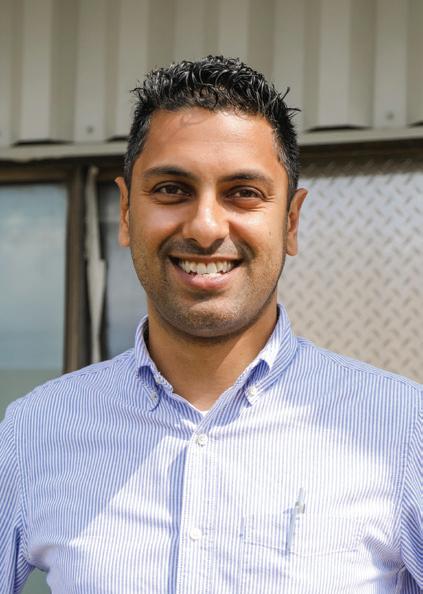
“Going from experiments backward is what we call system identification,” Faruque said. “It’s where you have the inputs and outputs, but you don’t know what the physics are, or you don’t know what the function is that relates them, and you need to figure out what that is.”
While studying bee swarming is helping to develop unmanned robotics, there is a secondary impact of this research project at OSU. Faruque has partnered with OSU Facilities Management to create a bee sanctuary in the new campus pocket prairie. Not only will this allow researchers to study bees outside of confinement, but it will also directly impact our local and worldwide environments.
Bees play one of the most important roles in our agriculture and food-sourcing pollination. The process of transferring pollen from male flower parts to female flower parts leads to fertilization
STORY & PHOTOS ALYSSA WILLIAMS
Dr. Imraan Faruque
16 IMPACT 2023
and the production of fruits, vegetables and seeds. Approximately 75% of the world’s leading food crops depend on pollinators like bees. The loss of bees would result in fewer flowers being pollinated and, consequently, fewer fruits and seeds being produced, leading to a decline in overall food production.
In communities with low bee populations, farmers have been forced into the fields to individually pollinate every flower with a paintbrush. Faruque said.
“It’s to the point where some crops need to be manually pollinated, which means there is a person out there with a tiny brush that is going from flower to flower hand brushing.” he said. “We have talked about doing this with a drone, but the primary focus would be to see if we can recover that honeybee pollination capability. That’s why we are starting to look at native pollinator gardens.”
The loss of bees would have a severe impact on our food sources, leading to decreased crop yields,

reduced food diversity and potential ecological imbalances. Protecting and preserving bee populations is crucial, which is exactly what this OSU engineering team is attempting to achieve with this new bee sanctuary. This sanctuary will be blooming with flowers and provide the perfect home for a brand-new colony of bees.
Since 1962, the bee population has been steadily declining with the potential to go extinct. The loss of bees would mean a loss in all that they provide. E orts to restore bee colonies are paramount to the survival of these amazing marvels of the insect world and to the various impacts they have on our lives.
“Honeybees are the backbone of our pollination strategy,” Faruque said, “And just looking at how they are choosing to forage in the new sanctuary will help to inform that societal food insecurity issue.”
OSU CEAT 17
APPROXIMATELY 75% OF THE WORLD’S LEADING FOOD CROPS DEPEND ON POLLINATORS LIKE BEES.
GETTING OUT OF THE CLASSROOM
AEROSPACE PROFESSOR ARENA HAS BUILT A CAREER ON INTERACTIVE EXPERIENCES
Dr. Andy Arena is always looking to give students a unique, hands-on opportunity to hone their skills.
A researcher and educator in aerospace engineering, Arena has contributed to education, research and industry collaboration throughout his time at Oklahoma State University.
With a career spanning over a decade, he has revolutionized the way students approach aerospace design and has inspired a new generation of engineers.

Arena began his education journey at the University of Arizona, where he received his bachelor’s degree in
aerospace engineering in 1987. He then got his Ph.D. and Master of Science in aerospace engineering at the University of Notre Dame in 1990 and 1992, respectively.
Arena’s research caught the eye of Dr. Larry Hoberock, emeritus head of the School of Mechanical and Aerospace Engineering at OSU, who subsequently hired Arena as an assistant professor in 1993.
Initially assigned to teach aircraft guidance and control, Arena recognized a chance for students to put their skills into action. Hoberock invited Arena to sit in on a capstone course for engineering, where the students were
instructed to write a paper study of a preliminary design. However, this didn’t give students the opportunity to truly apply what they had learned in the classroom.
“He said, ‘Larry, I would like to make this much more hands-on.’ I said, ‘Fine, let me know how I can help,’” Hoberock said.
Arena recognized the need for a more tangible experience, so he opened the door for his students.
“There weren’t a lot of universities doing hands-on work for students,” Arena said. “Capstone design classes were mostly theory. Trying to design an airliner on paper, like a next-generation
18 IMPACT 2023 STORY MAK VANDRUFF | PHOTOS GARY LAWSON AND PHIL SHOCKLEY

“Nobody’s ever going to remember any research that I did, or any paper that I wrote or anything like that. But, if I made an impact in the life of some young student, they’re going to pass that on. They’re going to pass on something we taught them to someone else, and that’ll live forever.”
OSU CEAT 19
DR. ANDY ARENA, RESEARCHER AND EDUCATOR IN AEROSPACE ENGINEERING
airliner, is just so superficial. And so, we started building airplanes to give students the opportunity and to make better engineers.”
This pushed Arena to motivate students to compete in the Design/ Build/Fly Competition hosted by the American Institute of Aeronautics and Astronautics (AIAA). OSU competed in this competition for several years with Arena assisting the students. More than half the times OSU competed, it won first place. The students were in the top three if they weren’t in first.
Arena’s emphasis on practical application and problem-solving skills paid o , as his students not only excelled in the competition but also gained invaluable real-world experience in aerospace engineering. Although they were winning, Arena didn’t feel the students were being challenged enough.
He tried to convince the AIAA to make the event more competitive, but they declined. So, there was nothing else for him to do but create his own competition.

Arena financed a section of land from the state of Oklahoma to build runways and hangars for his new event, which was aptly named Speedfest. The original Design/Build/Fly competition wasn’t available for high school students, but Speedfest opened that door with the India-Class, which means high schoolers must receive an invitation to compete.
Today, the event draws hundreds of attendees each year, who witness the capabilities of these remotely controlled aircraft, flying at speeds of up to 250 miles per hour.
Dr. Dorinda Risenhoover, one of Arena’s colleagues, said that teachers across the state are thankful to Arena for giving students an opportunity to practice applied STEM.
“Through Andy’s leadership as the NASA OKSG Space Grant Director, over 100,000 students and 5,000 educators have been impacted through India Class Speedfest, educator professional development, NASA OKSG pre-service and in-service educator mentorships, internships at Johnson Space Center, and large-scale STEM engagement events,” Risenhoover said. “The impact created by his leadership has
20 IMPACT 2023
led educators all over the state to feel empowered as STEM thinkers and doers so that they can, in turn, empower their students as future participatory stakeholders of STEM.”
Beyond his work in aerospace education, Arena has also made contributions to the field through his involvement with the NASA Oklahoma Space Grant Consortium, of which he is currently the director. Arena has brought in over $9 million in research funding, which has enabled him to pursue his research endeavors: working on unmanned aircraft.
Arena’s research and education strategies have attracted more faculty to the aerospace department according to Hoberock, who said OSU is now one of the leading universities for aerospace engineering.
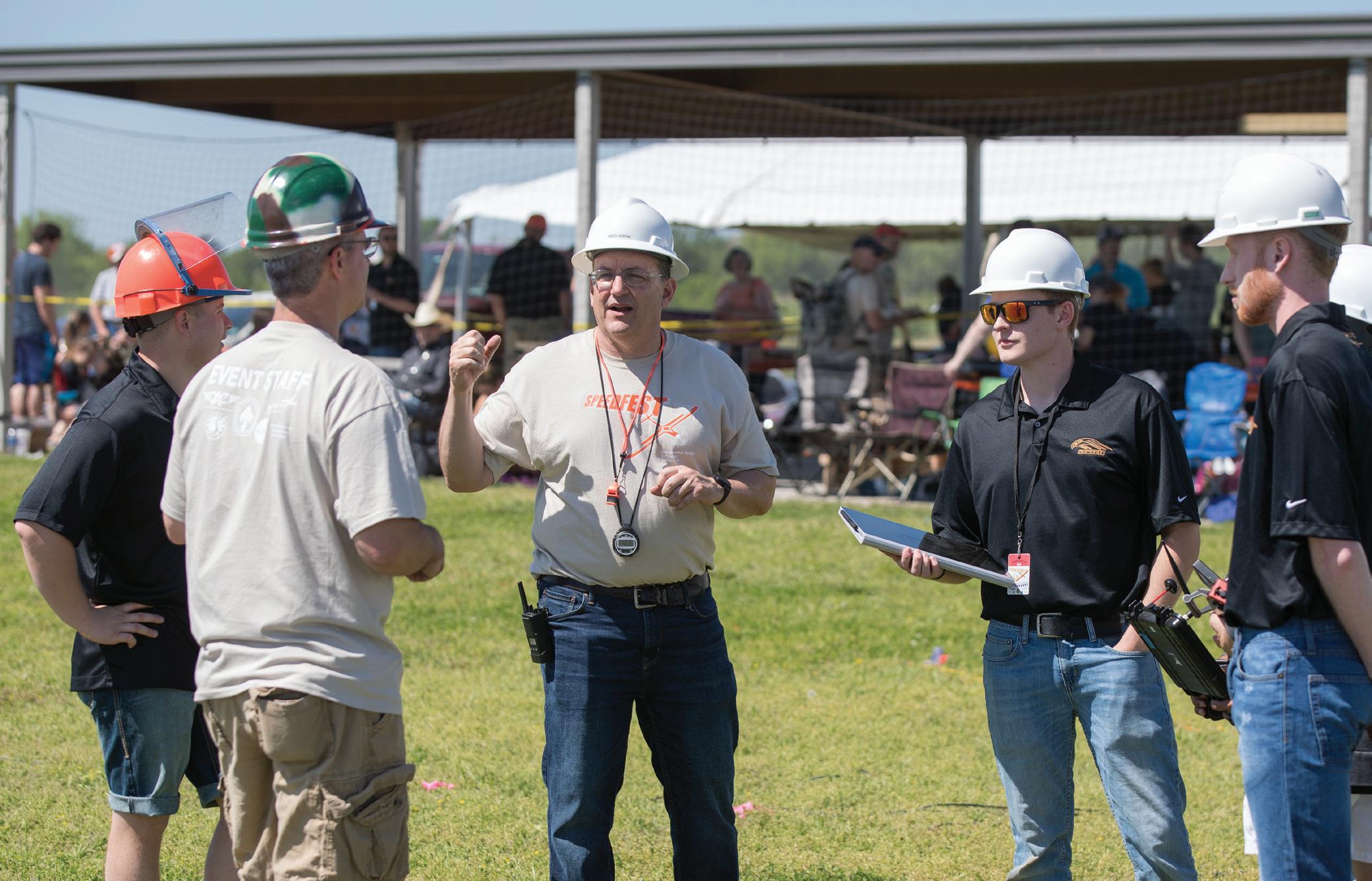
Dr. Joe Conner, a former student of Arena and a current colleague, said Arena is a kind yet firm teacher.
“Another one of his philosophies is that everything works on paper. When you have to make it a realization, that’s when the reality hits,” Conner said.
Conner said that nothing changed for him when he moved from being one of Arena’s students to his colleague. He said that Arena’s expectations for his students and his colleagues are almost the same as Arena expects everyone to put in their best work, because he will work just as hard.
“He is not a micromanager, he’s a macro manager,” Conner said.
Another of Arena’s philosophies is to practice hands-on STEM rather than theoretical STEM. Conner said Arena wants all of his projects to be applicable in the real world, outside of climatecontrolled rooms and the perfect research setting.
When Arena began his education journey around 30 years ago, he directed OSU into becoming one of the first
universities to stray away from purely on-paper STEM.
“I would say that we are one of the pioneers in hands-on STEM,” Arena said.
Arena’s passion for teaching extends past the university setting and into other levels of education, like high school. His desire to spread the love of aerospace to the next generation gave high schoolers more opportunities and it’s what those students will do with their newfound aerospace knowledge that truly inspires him.
“Nobody’s ever going to remember any research that I did, or any paper that I wrote or anything like that,” Arena said. “But, if I made an impact in the life of some young student, they’re going to pass that on. They’re going to pass on something we taught them to someone else, and that’ll live forever. So, that’s why it’s great to hear their stories about the impact we make in their lives.”
Dr. Andy Arena (center) championed the idea of Speedfest as a way to showcase the abilities of students, both college and high school, using an aircraft design, build and fly competition. The annual event continues to grow and draws hundreds of students each year.
OSU CEAT 21
Raising the Stakes
Architecture students learn about sustainable design in comprehensive studio

Oklahoma State University’s School of Architecture
“RAISED” the bar by promoting sustainability and preparing students professionally through the 2022 Comprehensive Studio.
The 2022 Comprehensive Studio received financial support from the Renewable and Innovative Sustainable Energy (RAISE) initiative, which is o ered by the School of Electrical and Computer Engineering (ECE) through support from the Martin Family Foundation.
The RAISE grants awarded architecture students for designing sustainable buildings for their studio projects. Dr. Khaled Mansy and professor Keith Pei er, along with
colleagues Dr. Tom Spector and John Phillips, worked with students through the process and evaluated their work.
Mansy, professor of architectural engineering, saw the opportunity for RAISE grants to support the Comprehensive Studio, a learning experience that blends building performance and architecture together through collaboration.
Through project-based learning, senior architecture and architectural engineering students work together to focus on systems integration. They start designing at a higher complexity than previous studios by determining appropriate sizes and components for the structural and mechanical systems before incorporating them with their
other aesthetic and functional goals for the project.
The spring 2022 studio students created designs for a prototypical classroom facility for Science, Technology, Engineering, Arts and Mathematics (STEAM) Engine OKC. This nonprofit organization was created by Morgan Robberson Jones, a 2012 graduate of the School of Architecture. The organization intends to teach children ages 8-13 by building on traditional education with 21st century skills emphasizing STEAM disciplines. The studio students were instructed to design a building that would help enrich the students’ education in these areas.
Comprehensive Studio also prepares students professionally by
STORY BAILEY SISK | PHOTO KRISTI WHEELER
Architecture student Nathan Sha er attends a reception during the RAISE tour to show his design to
22 IMPACT 2023
fellow Martin Family Foundation trustee Skip Cunningham.
making them aware of current trends and predicted changes in their career fields.
According to a 2021 study by the Lawrence Livermore National Laboratory, residential and commercial buildings consume around 40% of the energy and 74% of the electricity in the United States. This reality led the American Institute of Architects to collaborate with Architecture 2030, a nonprofit organization, to set energy use intensity (EUI) target values per building type to reduce energy consumption significantly by 2030.
While following these practices isn’t mandatory in professional practice, Mansy set the performance goal of meeting the 2022 target EUI in the Comprehensive Design studio. For the faculty in the School of Architecture, designing to reduce energy consumption is a necessary aspect of e ective design.
“We want to make sure we understand what’s happening in the profession and future transformations,” Mansy said. “One way to do so is to use targets established by the profession for the energy industry. We want students to understand these practices and start to think about how they can design buildings to try to meet them; that takes a certain expertise and awareness.”
The RAISE initiative was supported by the Martin Family Foundation and sponsored by ECE and the Comprehensive Design Studio. RAISE funds were used to reward students whose projects exceeded the measurable goals set for sustainability and building performance. The awards totaled $4,500 and were given in four categories: Most E cient Building, Highest Energy Savings by Design, Closest to Net Zero Energy and Best Use of Daylight.
RAISE recipient Brandon Davis designed his building’s heating, ventilation and air conditioning (HVAC) systems to be e cient and educational. His structure featured an exposed HVAC system that was colorcoded so students could associate colors with di erent things like water lines and supply ducts. He also included a glass wall in the mechanical
chases of the building so students could see how the building systems interacted between floors.
“For me, the project was interesting because I like the connection to sustainability, and nature in itself is important to me,” Davis said. “It was pretty seamless to consider the impact on the environment whenever we were designing the building. The RAISE Award was also an extra motivation.”
Third-place recipient in the best use of daylight category, Gustavo Villegas, worked hands-on with Mansy to create an optimal condition for the project. He looked at ways to reduce heating and cooling loads, take advantage of the position of the sun and bring more daylight into the space.
“I think the most important thing I took away from the project was to set a goal for sustainability very early on in the design process so that it can influence all of the decisions that come after,” Villegas said.
Pei er, assistant professor of architecture, and his teaching assistant, Whitney Waitsman, created posters with drawings, renderings and performance data of the student design proposals, as well as information on the studio and RAISE award categories. The posters were exhibited in Oklahoma City and Tulsa to raise public awareness.
“In the School of Architecture, we want to share our students’ work with a broader audience. We understand the significance of design in reducing energy consumption, but not everyone in Oklahoma does. We want to find ways to make this information accessible and help people understand the incredible potential for performance-based design.”
Collaboration, presenting to the public and receiving hands-on experience are only a few examples of how the Comprehensive Studio prepares students for the professional world.
“I think that it’s just nice to show the community that we are thinking about it,” Davis said. “These cool designs have really high sustainability aspects to them to make our future better. Students are learning to consider the world, not just a building as an object.”
RAISE AWARDS
(TO THOSE WHOSE PROJECTS EXCEEDED MEASURABLE GOALS )
MOST EFFICIENT
FIRST PLACE: ZANE WYATT
SECOND PLACE: ALEKAN POWELL
THIRD PLACE: DOREEN ADESOLA
HIGHEST ENERGY SAVINGS
FIRST PLACE: THADD WENGER
SECOND PLACE: ETHAN WALKER
THIRD PLACE: DANAH ALBLOOSHI, AUBREY TROWER
CLOSEST TO NET ZERO
FIRST PLACE: ETHAN WALKER
SECOND PLACE: RACHEL MONTGOMERY
THIRD PLACE: BRANDON DAVIS
BEST USE OF DAYLIGHT
FIRST PLACE: MATT YEAROUT
SECOND PLACE: BLAKE FOGG
THIRD PLACE: DANAH ALBLOOSHI, GUSTAVO VILLEGAS, BROOKE WENTZ
OSU CEAT 23

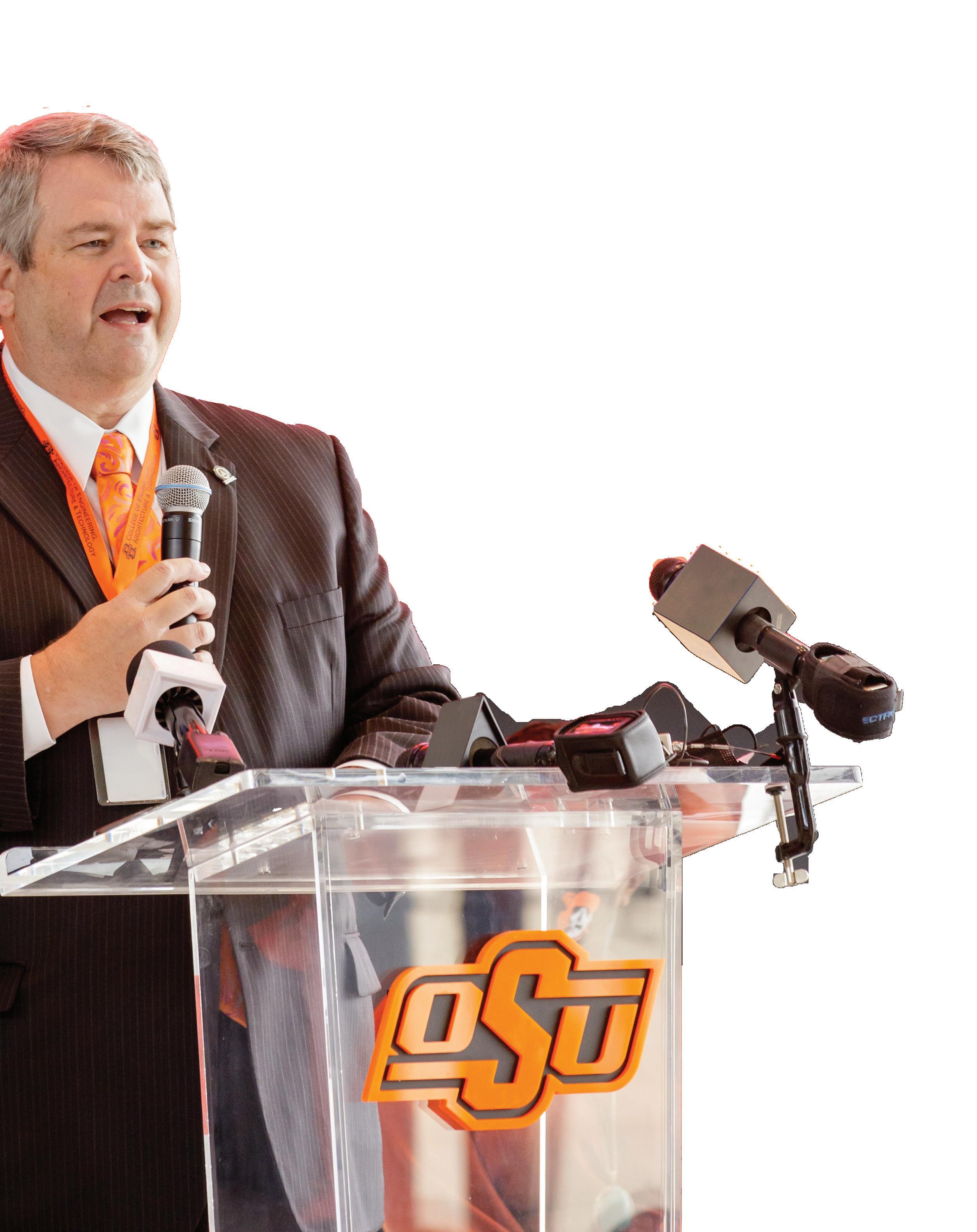
24 IMPACT 2023
Fall 2023 marks 11 years since Dean Paul Tikalsky took over leadership for the College of Engineering, Architecture and Technology.
Since then, the college and its people have seen transformational growth in all areas: enrollment; scholarships; infrastructure; industry partnerships; faculty hires; student enrollment and retention; outreach and engagement; and instruction and research.
After more than a decade of accomplishments, Dr. Tikalsky decided it’s time for him to step down as dean and allow for new leadership to step in.
The decision was his, as he realized 11 years is a long time to serve as dean. A dean’s typical term length lasts three to five years. When the new Oklahoma State University administration started, he said it was only right to give President Kayse Shrum a chance to select her own leaders.
Tikalsky spent more than 4,000 days leading, coaching and mentoring over 4,000 students and raising money to help them graduate. Among his several achievements, Tikalsky was responsible for raising more than $250 million to support world-class learning facilities and programs, scholarships, endowed chairs, industry research partnerships and K-12 STEM programs.
“When I started, I knew that we needed to move into the 21st century and our facilities were not what our peers looked like,” Tikalsky said. “The addition of ENDEAVOR, EXCELSIOR, the Bert Cooper Lab, and the Harold R. Mace Meeting and Learning Center as well as the renovations of Engineering North and South, Parker Hall and the Student Excellence Center, all these things have changed our lab and research environment to one that is much more aligned with the future and innovation. And now, the Zink Center for Competitive Innovation will make an impact on that as well.
“From a facilities standpoint, we are at a very di erent place now than we were 11 years ago. This helps us recruit faculty, sta and students, which is not only great for 21st century recruiting and education, but also helps us to retain them.”
Retention rates for students have increased by over 90%. Graduation rates have also increased by 26%.
This is in part because of the retention initiatives set in place. Programs such as the Pre-CEAT Program, the Summer Bridge Program, the Parker Hall Living Learning Program, CEAT’s PEATES Program, CEAT tutoring and the CEAT Diversity, Equity and Inclusion Program were all initiated with the intention of retaining students and giving them the maximum opportunity to excel to their fullest potential.
Student enrollment continues to increase, due in part to the number of scholarships that CEAT can give. On average, over $3 million in scholarships a year is provided to CEAT students.
“We are not only looking at high achieving students to award scholarships to, but we also look at economically challenged students, underrepresented students and students who are in financial need, but still students who have the potential to be tomorrow’s leaders,” Tikalsky said.
The constantly increasing demand for engineers has also challenged CEAT to place an even greater emphasis on recruiting than it already has. Recently, CEAT was awarded a $5 million Department of Defense grant focused on STEM education for K-12 students and faculty members across the state.
“We’re trying to find the talent in every town, large and small, in Oklahoma and beyond,” Tikalsky said. “We need to grab that talent, no matter its circumstances, and give it the ability to innovate and change the world.”
“The ultimate goal of my tenure is to position OSU CEAT to recruit and hire a highly qualified candidate to take over as the next full-time dean so that I can return to my retirement. We all owe a debt of gratitude to Dean Tikalsky for his work for the faculty, sta and students in CEAT.”
OSU CEAT 25 STORY KRISTI WHEELER | PHOTOS GARY LAWSON, PHIL SHOCKLEY AND KRISTI WHEELER
DR. JOHN VEENSTRA, INTERIM DEAN OF CEAT
This past summer, CEAT o ered 35 STEM camps to 2,000 K-12 students across 13 cities in Oklahoma, record numbers for the college.
In addition to setting recruitment and retention records, Tikalsky opened many faculty positions to support the student increase. Since 2012, over 125 new faculty have been hired, making two-thirds of the entire faculty in CEAT under the age of 40, some being clinical and some being research oriented.
“These things have changed the culture in the college,” Tikalsky said. “As we looked at the strategic planning,
we had industry and advisory boards and CEOs and VPs help us see what they needed from us.”
In addition to academics and research, CEAT’s Extension units have seen tremendous growth over the last 11 years, serving more than 150,000 individuals across the nation per year.
Tikalsky said the more he learned about leadership, the more he understood that it is supposed to change because it is healthy for faculty and students.
“I am excited to see what the new administration has in store,” Tikalsky said. “I think the administration here
has defined a strategy they want to move forward with. This is a new direction for the university. I think they’re spending time and e ort on that (strategic planning). All these things are how a leader chooses what avenues to move after.”
As Tikalsky steps down, Dr. John Veenstra, Professor Emeritus of Civil and Environmental Engineering (CIVE), will act as interim dean.
During his long tenure at OSU, Veenstra served as a professor of CIVE, the department head of CIVE, and the department head of Biosystems and Agricultural Engineering in the Division of Agricultural Sciences and Natural Resources.


Before his retirement in 2021, Veenstra was an active member of various college and university committees including serving as chair of the OSU Faculty Council and of the Oklahoma State Regents for Higher Education Faculty Advisory Council. Veenstra’s areas of expertise include water and wastewater treatment, air pollution treatment and groundwater treatment, and is a registered professional engineer in Oklahoma and Iowa.
“Few opportunities could draw me out of retirement, but the ability to work with the college leaders, faculty, sta and students to grow going forward was one that I couldn’t pass up,” Veenstra said. “I hope to
Dean Paul Tikalsky, Dr. Norb Delatte (department head for CIVE) and Pistol Pete, along with CIVE students attend the ribbon cutting ceremony for Civil and Environmental Engineering’s new home on the second floor of Engineering North.
26 IMPACT 2023
Former OSU president Burns Hargis, Julie Tikalsky, Pistol Pete and Dean Tikalsky stand in the Tikalsky Family Commons during the ENDEAVOR Grand Opening.
leave CEAT a better place as the new dean assumes their responsibilities.”
Veenstra said his plan is to continue CEAT’s positive momentum established during Tikalsky’s tenure.
“With the grand reopening of Engineering South, this will complete the exceptional academic infrastructure modernization of the college overseen by Dean Tikalsky, which is second to none,” Veenstra said. “The various units inside CEAT will move to further implement OSU’s strategic plan and will work to continue and expand our interactions with the other colleges. It is important to CEAT and OSU that we establish lines of communication — both across our own college and with the other colleges — so that we are positioned to take advantage of research and extension opportunities that we find. Together, we can make a di erence. In the instruction arena, we will continue to engage, inspire and prepare CEAT students to innovate solutions to all ranges of problems in their chosen fields.
“The ultimate goal of my tenure is to position OSU CEAT to recruit and hire a highly qualified candidate to take over as the next full-time dean so that I can return to my retirement. We all owe a debt of gratitude to Dean Tikalsky for his work for the faculty, sta and students in CEAT.”
As Tikalsky steps down, he will return to his tenured faculty position in CIVE as he, Veenstra and Dr. Jeanette Mendez, OSU provost and senior vice president of academic a airs, will work together on a comprehensive and thoughtful transition plan and begin a national search for a new dean.
Tikalsky grew up in Wisconsin, which is where he and his wife, Julie, will go after he decides he’s ready to retire. The couple bought some land on the coastline of Lake Michigan, where they plan to build a home and spend time.
“I heard on NPR someone talking about this concept of wonder,” Tikalsky said. “If you stare at the leaf of a tiny flower and if you put it under a microscope, or just under a magnifying glass, you just see how complex it is. And this gives you an idea of wonder, gives you a rush, right? And so, you think about that every day. And I think that’s true. I think that’s exactly the way I see the world every day as a dean.”
TAKING A LOOK BACK
NEW CEAT FACILITIES IN TIKALSKY’S TENURE:
Bert Cooper Structures and Materials Lab
Harold R. Mace Meeting and Learning Center
ENDEAVOR
EXCELSIOR
Zink Center for Competetive Innovation
RENOVATIONS UNDER TIKALSKY:
Engineering North
Engineering South
Parker Hall
Student Excellence Center
BY THE NUMBERS:
11 : Years Tikalsky was dean
26% : Rate graduation has increased under Tikalsky
90% : Retention rate of CEAT students in that time
$250M : Amount Tikalsky was responsible for raising to support world-class learning facilities and programs, scholarships, endowed chairs, industry research partnerships and K-12 STEM programs
OSU CEAT 27
CEAT by the Numbers
319
Native American

786
33 new female freshmen students enrolled in fall 2022
female faculty members

$46M 35
in awards received for research & over 420 proposals submitted

STEM camps o ered in 13 di erent cities with over 2,000 students enrolled across OK in summer 2023
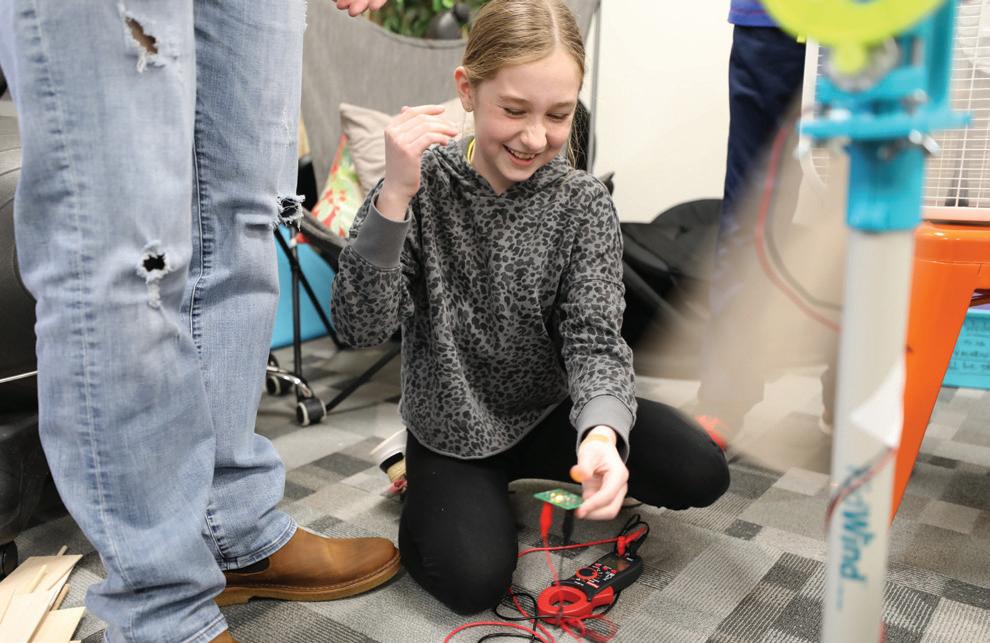

Over
113 & Hispanic freshmen students enrolled in fall 2022 28 IMPACT 2023
5
173K
individuals served by CEAT’s 7 Extension units across the nation
165
graduate degrees granted for 2022-2023


Over with

778
undergraduate degrees granted for 2022-2023
3,710
students enrolled for the fall 2022 semester.

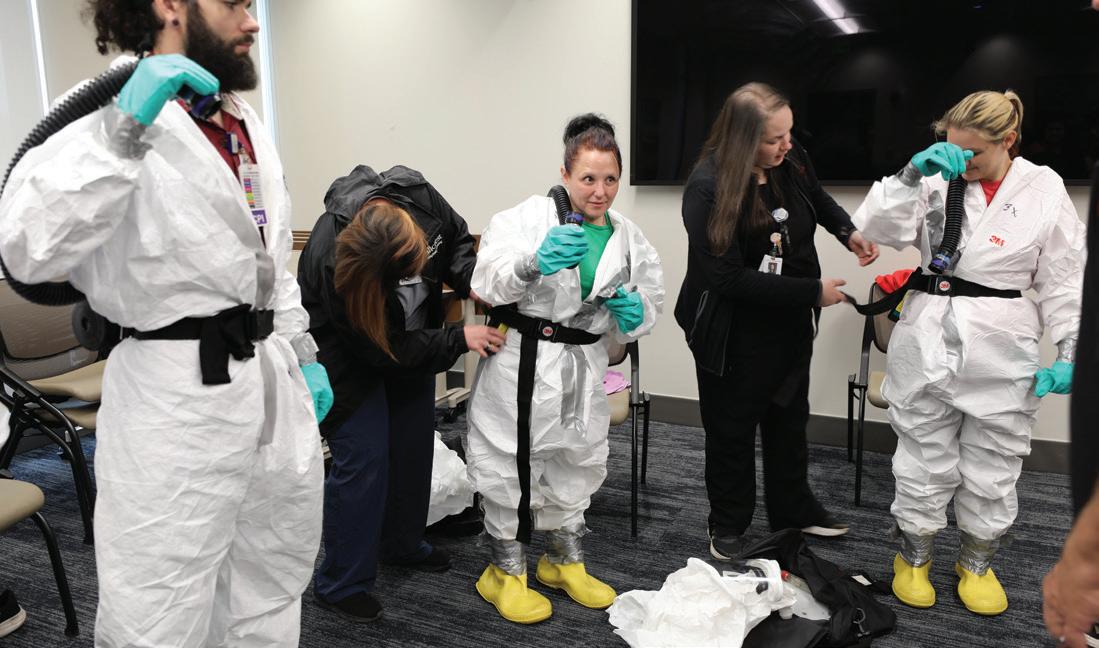
semester credit hours earned
Over OSU CEAT 29
NSF CAREER Award Winners
61,259

The Environmental Puzzle
CEAT researcher focuses on the global e ect on the environment
Our environment is a giant, ever-changing puzzle that requires complex solutions to equally complex problems, and it will require many di erent people to solve it.
Dr. Mary Foltz, an assistant professor in the School of Civil and Environmental Engineering at Oklahoma State University, is one of those people working to solve the many problems that threaten our environment and its sustainability.

“My goal is to challenge and change perspectives and minds as it pertains to our environment and sustainability,” Foltz said. “If I can change one student’s mind, then they might choose to pursue a field in environmental sustainability and change 10 more minds.”
Foltz joined the College of Engineering, Architecture and Technology in the fall of 2021 to investigate several core areas of research including greenhouse gas emissions, agricultural nutrient cycling and nature-inspired solutions to environmental issues.
Foltz chooses to focus on a global approach to these areas, and how potential solutions to problems a ect other areas of the environment. Her team is investigating how naturally occurring processes, such as denitrification and CO2 sequestration, can be used to solve environmental challenges without upsetting the delicate balance of the surrounding environment.
“The environment built itself and evolved in a way that can be self-sustained, and it would make sense to apply some of these natural tools to try to
reestablish balance,” Foltz said. “However, it can be challenging to find the right tool, especially when you have to balance so many variables such as the environmental cost, monetary cost and the social cost.”
Foltz is investigating the optimal environmental conditions for these natural processes and determining if those conditions can be achieved without incurring unacceptable costs, whether financial or environmental.
A key challenge to her investigation is the changing environmental conditions that are present today, which pose barriers for these processes to occur. Higher levels of CO2 and more abundant manmade chemicals provide additional challenges to overcome, beyond “normal” environmental conditions.
The answers to these challenges require new methods and new approaches to solve them. Foltz recognized the shift in environmental science and believes her role as an educator and researcher provides her with the perfect environment to inform change.
“I just wanted to do something good, and I loved the environment,” Foltz said. “I took a job teaching high school science and I loved it, but I missed the research aspect of science. I wanted to learn more and be able to pass that knowledge on to my students. I think this position is the best of both worlds.”
Foltz hopes that her work will help give everyone a new perspective on the growing challenges our environment faces, and perhaps look to natural processes that could provide the best solutions.
“I hope that’s what my impact is,” Foltz said. “Making sure folks know about this and care about this will a ect change. We need to get everyone on board to work for change.”
STORY JEFF HOPPER | PHOTO PHIL SHOCKLEY
OSU CEAT 31
Dr. Mary Foltz
Rock Solid
Multidisciplinary vision results in nation’s first vehicle-mounted 3D printed concrete structure
Have you ever wondered how a 3D printed concrete building is built? It all started with outgoing Dean Paul Tikalsky’s vision to start teaching multidisciplinary senior design classes at Oklahoma State University.
He knew that having students from di erent disciplines and diverse backgrounds working together as a team to solve problems was important and mirrored real world industry challenges.
He also knew Dr. Tyler Ley was an ideal fit for this task.
Ley, a professor in civil and environmental engineering (CIVE) with a research focus on concrete, was a little intimidated by teaching students in disciplines other than CIVE. He had collaborated in research with di erent disciplines, but he had never taught a class of interdisciplinary students.
“I supported Dean Tikalsky’s vision, and I wanted to help him however I could,” Ley said. “He shared some stories back from when he was a young faculty member, when he had to teach multidisciplinary senior design classes, and it sounded really fun! He told me a story about how they made a submarine that worked! This inspired me.”
POURING A FOUNDATION
At the time, Ley wasn’t happy with how 3D printed concrete was progressing in the industry.
He didn’t feel like it was practical. The mixes they use are quite di erent than the conventional concrete mixtures and replace the rock in the mix with only sand. Additionally, conventional 3D printed mixes are more expensive and less sustainable than traditional concrete mixtures.

STORY AND PHOTOS KRISTI WHEELER
Dr. Tyler Ley and his team 3D print the first layer of concrete using the BAM 3D printer.
32 IMPACT 2023
To add to that, the 3D printing equipment currently used is complicated and needs specialized people to use it. The structures created also do not contain reinforcing. The reinforcing bars must be added later. Ley saw these challenges as a chance to use his multidisciplinary senior design class to focus on all aspects of 3D printing concrete. This means taking an innovative approach to all aspects of 3D printing and building the right team.
“Usually, I would just focus on the concrete mix itself, because that’s what I do, I’m a concrete guy,” Ley said. “But I know about construction. I have done construction and I understand the practical side of that. I decided that this is a perfect opportunity to bring a true interdisciplinary team together to focus on the machine, the structures, the mix, everything. This would include students with di erent backgrounds working to solve some of these big problems.”

Ley taught his first class with Jeanne Homer, an associate professor who has since retired from the School of Architecture. In that class, Homer had her students design a one-story home that could be 3D printed. It was designed to imagine how light would enter the building, how to heat and cool it e ciently, how to make it weather resistant to the environment, and a space that the owners would enjoy.
“At this time, we were using gantry systems to 3D print concrete,” Ley said. “A gantry system is similar to how plastic 3D printers operate. We quickly saw that there were going to be some problems. Gantry systems are cumbersome to set up and move around. The system would have to be as big as the building you are printing.
“If you wanted to do a multi-story building, you would have to have a tall gantry system to do that with. The tubes to feed the nozzle had to be small and this impacted the type of concrete that you could use, and the biggest issue is that it was not possible to add reinforcing bars to the concrete as you printed. We knew we needed to do some things very di erently.”
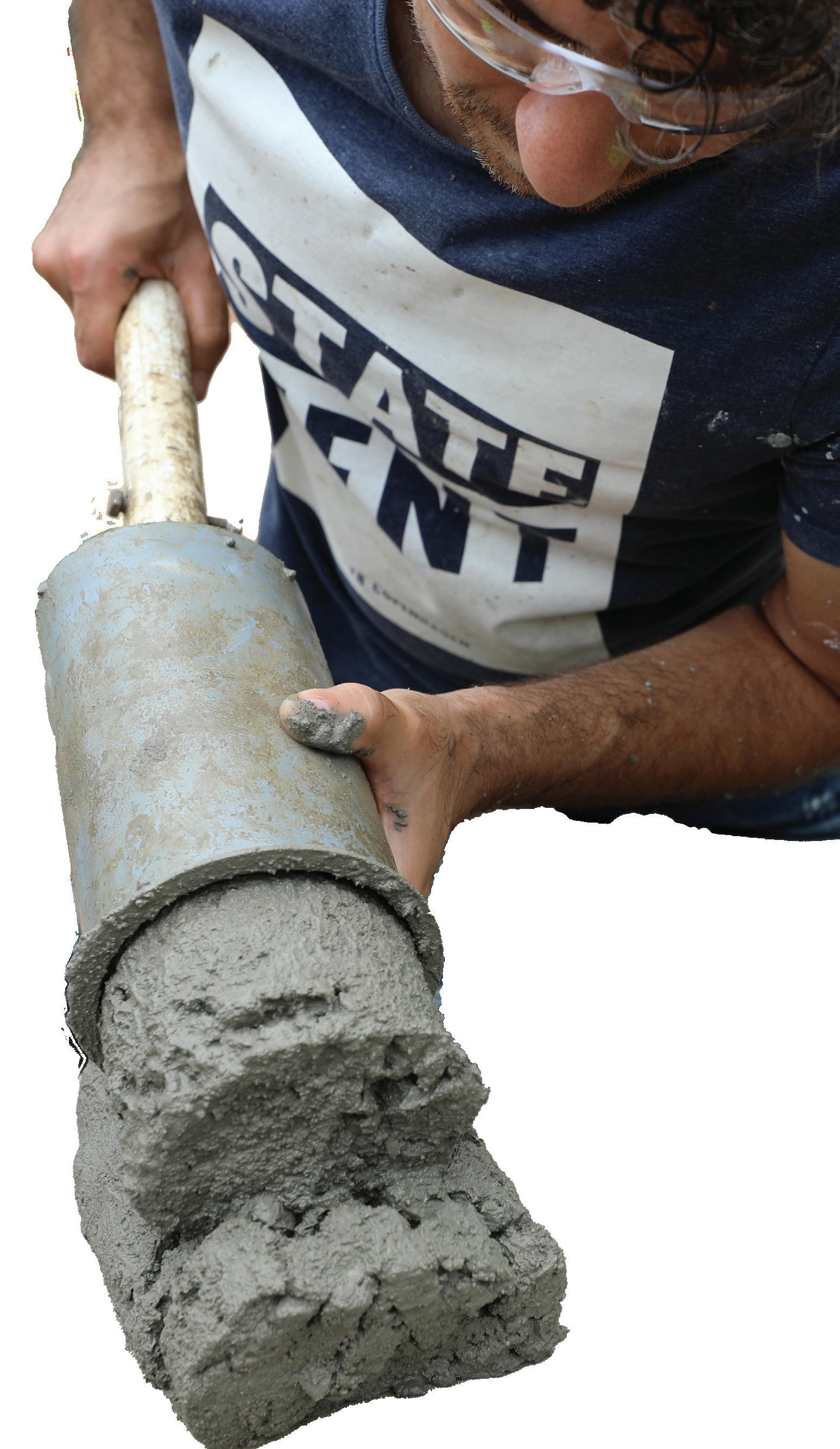
OSU CEAT 33
Masoud Forsat tests the concrete being used for the 3D printed structure.
Ley then started to co-teach with Jim Beckstrom, a professor of practice with extensive field experience in the energy sector who has retired from the School of Mechanical and Aerospace Engineering. Together, Ley and Beckstrom determined that they wanted to create a system that printed from the ground: a vehicular system. This led the team to use a forklift that was manually driven to create the first 3D printed concrete wall using a forklift.
The OSU system is named a BAM 3D printer. BAM stands for Box-Auger Method, which describes some of the key parts of the developed technology. There are distinct advantages to the OSU developed 3D printer. The printer is designed to be used on most construction vehicles. This means that existing contractors likely have a piece of equipment that can already use the technology with a human driver.
The printer uses large aggregates, and the mix can be ordered from a local concrete company and delivered to the site with typical concrete trucks. The printer can print around already tied rebar. This means that a crew can tie the reinforcing for the concrete and provide any electrical and plumbing utilities and the BAM 3D printer can place the concrete around it. The printer also smooths the concrete as it is being placed, which creates a finished surface as it leaves the machine.
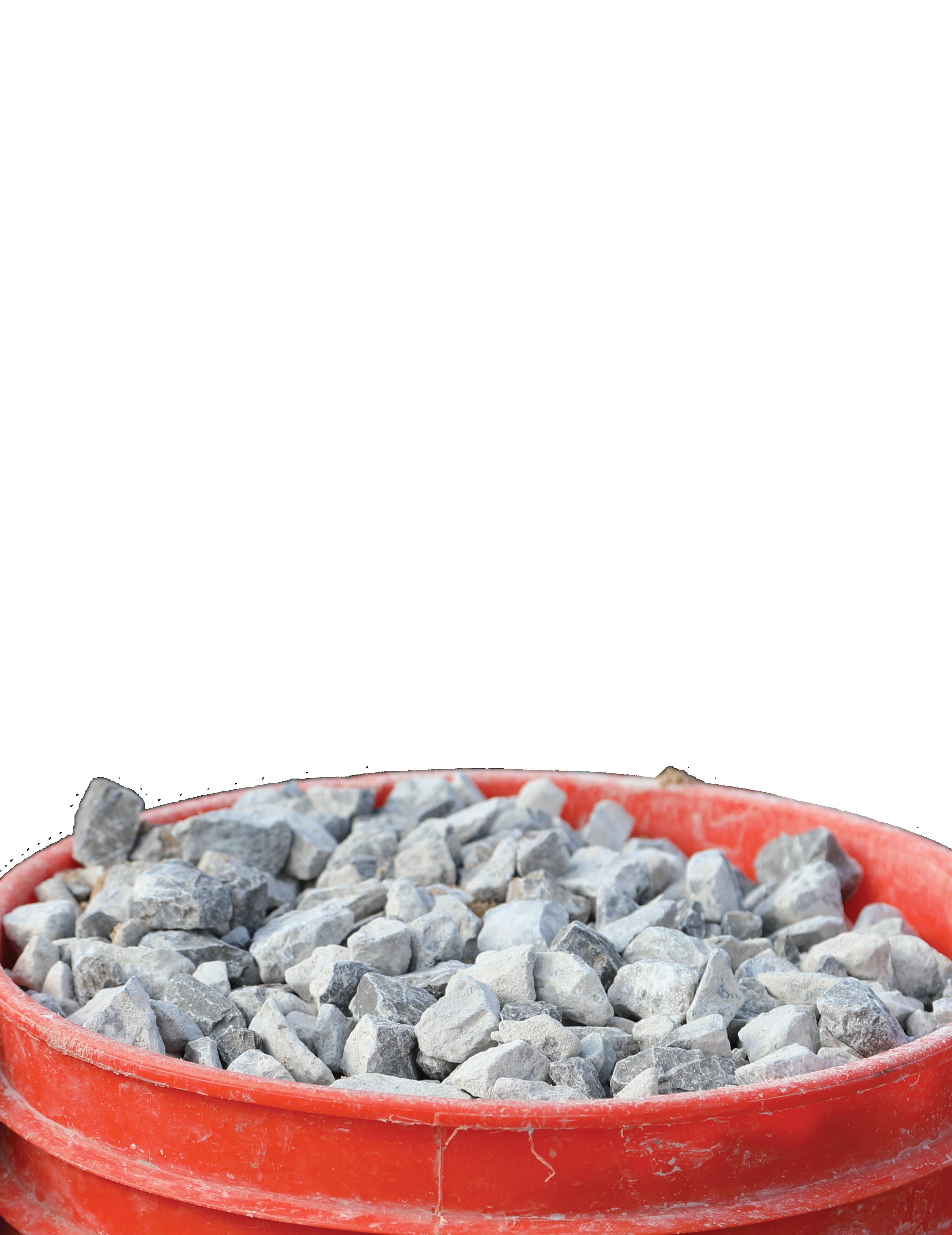
“I was so proud of the students,” Ley said. “I was so proud of what they were able to accomplish, and that they were able to figure it out! From there, the students just built on and improved that system, to the system that we are using now. It’s cleaner, it’s more automated, and it’s more precise. It’s been so much fun to work with these students and watch them slowly keep building and improving.”
LET’S PRINT A BUILDING
Drs. Mary Foltz and Jaime Schussler joined the CIVE faculty at OSU in fall 2021 and fall 2022, respectively. Both have large field components to their research which involve taking samples and measurements.
Foltz’s research focuses on greenhouse gas emissions, agricultural nutrient cycling, passive treatment systems for biogeochemical water
treatment and nature-inspired solutions to environmental issues. Schussler’s research focuses on stormwater management, specializing in erosion and sediment control.
“OSU has a lot of amazing facilities, but they really didn’t have a facility for Jaime and Mary to store their field equipment for their research,” Ley said. “One day, Jaime and Mary were talking with a group of people in the department about the possibility of me printing a 3D printed concrete building for them. Just so happens, I was walking by right at that exact moment. I looked up and said “Yes!” I thought that this would be amazing! We immediately started collaborating on what needed to be done to make this happen.”
Foltz and Schussler used part of their startup package from the university to invest in this project. Ley contacted two companies — Dolese and MegaSpray — to see if they would
“One day, Jaime and Mary were talking with a group of people in the department about the possibility of me printing a 3D printed concrete building for them. Just so happens, I was walking by right at that exact moment. I looked up and said “YES!”
34 IMPACT 2023
DR. TYLER LEY, PROFESSOR IN CIVIL AND ENVIRONMENTAL ENGINEERING (CIVE)
be willing to provide funding for the project. Both companies were extremely supportive. Dolese has been an ardent supporter of OSU, CEAT and Ley’s research. MegaSpray has also been a longtime supporter of Ley and has provided substantial funding to OSU for past projects.
“It’s truly been a group e ort,” Ley said. “It’s been a lot of weekly meetings and a lot of people out there doing the work. Mary and Jaime have been out cutting down trees to make room for the building. I’m reusing a concrete slab that I poured about a decade ago for a previous research project. We are reusing and recycling a lot of di erent things to minimize cost. Beckstrom continues to help us despite being retired from OSU. He’s brought a ton of knowledge and energy to this project. It’s been a true collaboration.”
Beckstrom’ s involvement in printing 3D structures with concrete started when he was the director of interdisciplinary in CEAT. Beckstrom, as professor in practice, with Ley and other professors “framed” the senior
projects and mentored the work of the students for several semesters.
In the summer of 2020, Beckstrom redesigned and fabricated the concrete delivery system, enabling it to be powered and deployed by a skid steer. In the following two semesters, Beckstrom and Ley instructed and mentored student teams who tested various mixes, consolidation configurations, and positioning systems. Beckstrom retired from instruction and continued as a volunteer starting in June 2021, focusing on the mechanical delivery/ placement system, positioning, and skid steer interface.
“The ability to produce codecompliant concrete walls without form work, using globally available equipment such as skid-steers, makes this technology amazingly scalable,” Beckstrom said. “It is exciting to be part of the OSU enabled technology.”

Masoud Forsat, Ley’s Ph.D. student, is doing his dissertation on the BAM 3D printer. He has been instrumental in improving the mix design and the printer and has been involved with this project for more than a year.
This will be OSU’s first 3D printed concrete facility and the first BAM 3D printed concrete structure in the world. The structure will meet all building codes and it is much more economical and easier to print compared to other 3D print technologies as everything is done from the ground. It’s vastly di erent than gantry systems that are used to print concrete structures.
PLANS FOR THE FUTURE
Ley and his team are actively looking for ways to collaborate with alumni, industry partners and others to use this new generation of 3D printers to create economical, e cient, sustainable, and durable concrete structures that are fire and insect resistant.
The team is constantly improving the machine’s automation, streamlining the construction process, building more structures, and showing the world what can be done with BAM 3D printed concrete.
Please reach out to Dr. Ley if you want more information at tyler.ley@okstate.edu.
Dr. Ley’s team work on the ninth layer of the 3D printed concrete structure using the BAM 3D printer.
OSU CEAT 35
RES TOR A


36 IMPACT 2023
REOPENING OF RENOVATED ENGINEERING SOUTH BRINGS COLLEGE MAINSTAY FULL CIRCLE
When looking into the history of the College of Engineering, Architecture and Technology’s oldest building, one can’t leave out how that structure came to be.


Only eight of the 516 pre-Civil War established colleges in the United States o ered engineering degrees. Nearly all the universities of that era were liberal arts colleges and professional schools of theology, medicine and law.
However, pressure was mounting on academia to provide engineering and agriculture programming in higher education. In 1857, Justin S. Morrill, a Vermont congressman introduced the first bill to establish land-grant colleges. It was vetoed by President James Buchanan amid concerns that the classical component of education, permitted by the bill, would infringe on the already established liberal arts colleges and universities.
A modified bill, now known as the Morrill Act, was presented and passed in 1862, granting 30,000 acres of public land for each senator and representative to which each state was entitled under the 1860 census to be sold, with all monies derived from the sale of the land to be used to support at least one college. The leading subjects of those colleges would be the agricultural and mechanical arts, to promote the liberal and practical education of the industrial class of people.
After the territory of Oklahoma was established on May 2, 1890, the first territorial legislature convened in Guthrie and enacted bills to create three institutions of higher education, one of them being Oklahoma Agricultural and Mechanical College. As part of the legislative act, the institution was to provide practical instruction in multiple areas of study, including engineering. Classes began at OAMC on Dec. 14, 1891, but a lack of faculty experienced in engineering prevented
OSU CEAT 37
AND SPECIAL COLLECTIONS
STORY DAKOTA KEITH | PHOTOS KRISTI WHEELER AND OSU LIBRARIES
students from being able to study the subject.
It wasn’t until the fourth president of what is now Oklahoma State University, George Espy Morrow, employed the first engineer to the faculty that the program became a focus. In 1899, Morrow’s successor received legislative funds to construct the first engineering building to support the growing program. Construction was completed on the space in 1902.
Five years later, when Oklahoma became a state, 40% of college students attending OAMC were enrolled in engineering.
BUILDING A HOME
There have been only three buildings originally dedicated to engineering at OSU that predate Engineering South: the first Engineering Building, completed in 1902; the Civil Engineering building, completed in 1905; and the second Engineering Building, completed in 1912.
All were constructed based on the needs of a growing student body and quickly advancing technical curriculum. Between 1908 and 1912, degrees granted in engineering at OSU exceeded those in any other field. The second Engineering Building was the first to house all four branches of engineering curriculum

that had been established by OSU, which were architectural engineering, civil engineering, electrical engineering and mechanical engineering. It also provided drafting rooms, laboratories and classrooms.
In 1933, President Franklin D. Roosevelt’s New Deal was enacted. Under the Public Works Administration program, the federal government provided 45% of the funding for approved projects.
Funding for a new Engineering Building at OSU was approved through the program. In January 1939, 1,294 students were enrolled in engineering. It was the perfect time for the new
Engineering Building (Engineering South today) to open for classes. All the engineering departments, except for architecture, moved from the 1912 Engineering Building (now called Gundersen Hall).
With the new building came several pieces of equipment, one being a 200,000-pound capacity Olsen universal testing machine, which is used to measure the strength and product performance of materials such as metals, polymers, textiles, rubbers, adhesives, food and finished components.
Although Engineering South was much needed, OSU would quickly
“In pre-renovated Engineering South, there wasn’t much to get excited about. There were a lot of dark hallways and closed doors. I think once we open the doors to Engineering South this fall, ... they are going to say, ‘I want to be here.’”
38 IMPACT 2023
DR. JEFFREY YOUNG, DEPARTMENT HEAD OF ELECTRICAL AND COMPUTER ENGINEERING
learn that it would have to never grow complacent if it wanted to stay at the forefront of innovation.
KEEPING UP
By 1951, like the original Engineering Building before it, Engineering South was struggling to meet the needs of the most populous group on campus.
In 1948, the engineering branches had combined to form the Oklahoma Institute of Technology — not to be confused with OSU Institute of Technology in Okmulgee, which was called the OSU Technical Branch at the time.
The Oklahoma Institute of Technology consisted of three divisions focused on engineering instruction; engineering research, including an experiment station; and engineering and industrial extension. The Division of Engineering Instruction consisted of a School of Engineering (that now included additional branches in industrial engineering and
management, agricultural engineering, and chemical engineering), a School of Architecture and Applied Arts, a School of Technical Training and a School of Flight.
The total enrollment in the engineering division reached 3,240 students, more than 10 times the number of students enrolled only three years prior.

Due to lack of space, the School of Chemical Engineering found itself in a temporary accommodation in a Quonset hut, which was acquired from military war surplus stocks. Through 1951, the Division of Engineering was relying heavily on Engineering South to support its needs.
In the hopes of gaining some breathing room, Dean Melvin R. Lohmann strongly encouraged then university president Oliver Willham to allow him to put a basement space in Engineering South.
Willham agreed, and Lohmann increased the capacity of the building by 25%. Engineering South continued
to serve the brunt of the Division of Engineering’s needs until Engineering North was constructed in 1964.
A MUCH-NEEDED RENOVATION
Since its completion 84 years ago, Engineering South has served as a staple of CEAT.
The building o ers glimpses of CEAT’s historic past, such as the large monument to engineering honor society Sigma Tau on its northern lawn, which was placed in 1940 to commemorate the chapter that was active from 1923 to 1974; and the aerial towers that grace its roof that were used to support the W5YJ ham radio station as well as several other campus radio stations, which featured programs like the immensely popular “Farmers Hour.”
However, 70 years without a major renovation had begun to show.
“I believe the common frustration that everyone — visitors, faculty, sta and students alike — had with the prerenovated Engineering South building was the fact that the men’s and women’s restrooms were on alternating floors,”
From left: CEAT Facilities Manager Patrick Wheeler, CMS Willowbrook Director of Operations Bryan Miles, CMS Willowbrook Project Superintendent Wayne Leatherbury, Representative of the Chickasaw Nation and CEAT alumnus Neal McCaleb, Provost and Senior Vice President of OSU Jeanette Mendez and CEAT Dean Paul Tikalsky stand in front of a signed beam prior to the Engineering South topping out ceremony. The beam was placed on the Chickasaw STEM Auditorium by members of the construction company, CMS Willowbrook, who worked on the building.
OSU CEAT 39
DID YOU K NOW ? DID KNOW?
After Engineering South’s opening in 1939, a bronze tablet was set into the foyer floor of Engineering South by the U.S. Coast and Geodetic Survey indicating the buildings coordinates and elevation above sea level. This was possibly done to honor the dean of the college at that time, Philip Stone Donnell’s five years of work with the U.S. Coast and Geodetic Survey agency prior to his employment at OSU. Professor of architecture
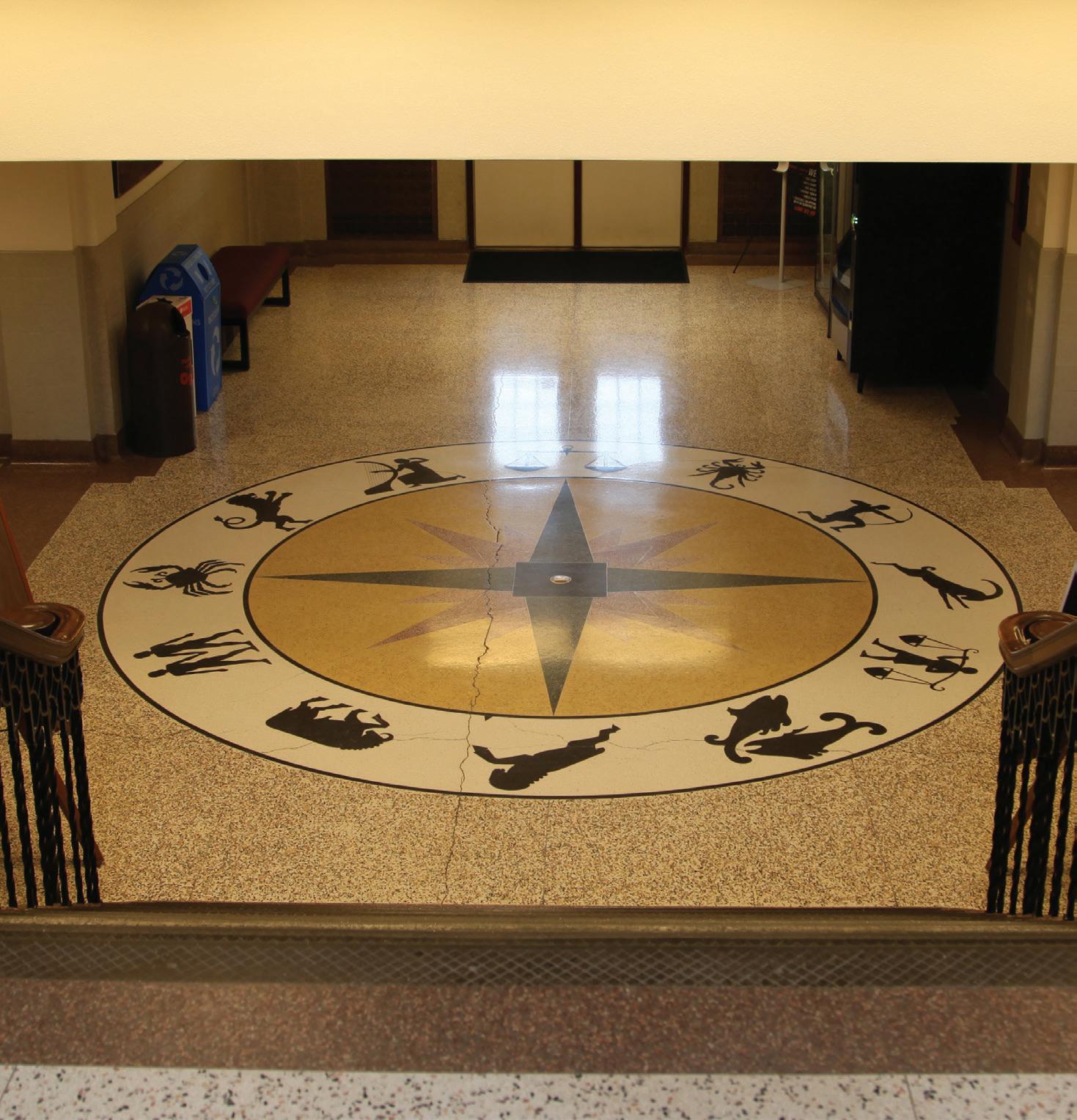
John R. Cunningham and university architect Philip Wilbur constructed a zodiac sign around the tablet.
said Dr. Je rey Young, department head of the School of Electrical and Computer Engineering. “The ventilation system was also from the early days, so there were no heating and cooling zones. The building was centrally heated and cooled on each floor, so sometimes one o ce was hot while another was cold. It was hard to make the space comfortable for most everyone.”
Dr. Sandip Harimkar, head of the School of Mechanical and Aerospace Engineering, added there was also a struggle to find suitable classrooms for larger classes. The ones in prerenovated Engineering South lacked the updated technology that was needed.
In June 2021, construction began on the structure, as it joined a plethora of CEAT’s newly renovated and constructed buildings, including its twin in Engineering North.
While the exterior facade of Engineering South remains intact, the interior of the building has been completely transformed into the innovative environment needed for CEAT faculty, sta and students to be on par with the quickly advancing world of modern engineering.
Parts of the original Engineering South will remain, though. One of those pieces being the central grand staircase, which leads individuals to the building’s second floor.
“Those stairs represent a connection to the generations of engineers who came before, those engineers who learned both the basics of engineering as well as the specific knowledge of their chosen discipline in this building,” said Dr. John Veenstra, interim CEAT dean. “How many times during their academic career did the typical engineering student climb
those stairs to get to the large lecture hall on the third floor? Then they went out into the world and used that education to accomplish amazing things that have benefited Oklahoma, the nation and the world.”
Aside from the grand staircase, and a few other original interior features such as original beaming, portions of concrete and brick wall that were smartly factored into the overall transformation of the building, not much of the original interior is left.
“In pre-renovated Engineering South, there wasn’t much to get excited about. There were a lot of dark hallways and closed doors,” Young said. “I think once we open the doors to Engineering South this fall, that when people come in to Engineering South they are going to say, ‘I want to be here.’”
40 IMPACT 2023
SPARING NO EXPENSE
In the fall of 2023, Engineering South will again open its doors to another class of future engineers, architects and technologists, but this time it will have a state-of-theart HVAC system, adequately sized elevators and universal restrooms on every floor.
Rand Elliott, a former CEAT student whose architecture firm Rand Elliott Architects is designing the project, worked with the departments to brighten the building’s concept.
It will feature more glass walls, allowing natural light from the windows to stream in, and elevated ceilings, which will make the building feel more voluminous. Each floor of the building will feature its own unique architectural customizations, designed to meet the needs of the school or department occupying that floor.
Students will find the CEAT Scholarships and Recruitment team, CEAT Career Services and CEAT Special Programs on the first floor of Engineering South. An addition on the east side of the building will house the Zink Center for Competitive Innovation.
“The Zink Center will be an open collaborative space that can be flexibly configured for informal conversations, formal group meetings or seminar presentations,” said Dr. Dan Fisher, director of the center and professor for the School of Mechanical and Aerospace Engineering.
The idea behind the Zink Center for Competitive Innovation is to allow for more face-to-face faculty mentorship opportunities for CEAT’s competitive
student teams, as well as to build a bridge of collaboration between CEAT’s engineering students and the OSU Spears School of Business’ students through the Riata Center for Innovation and Entrepreneurship.
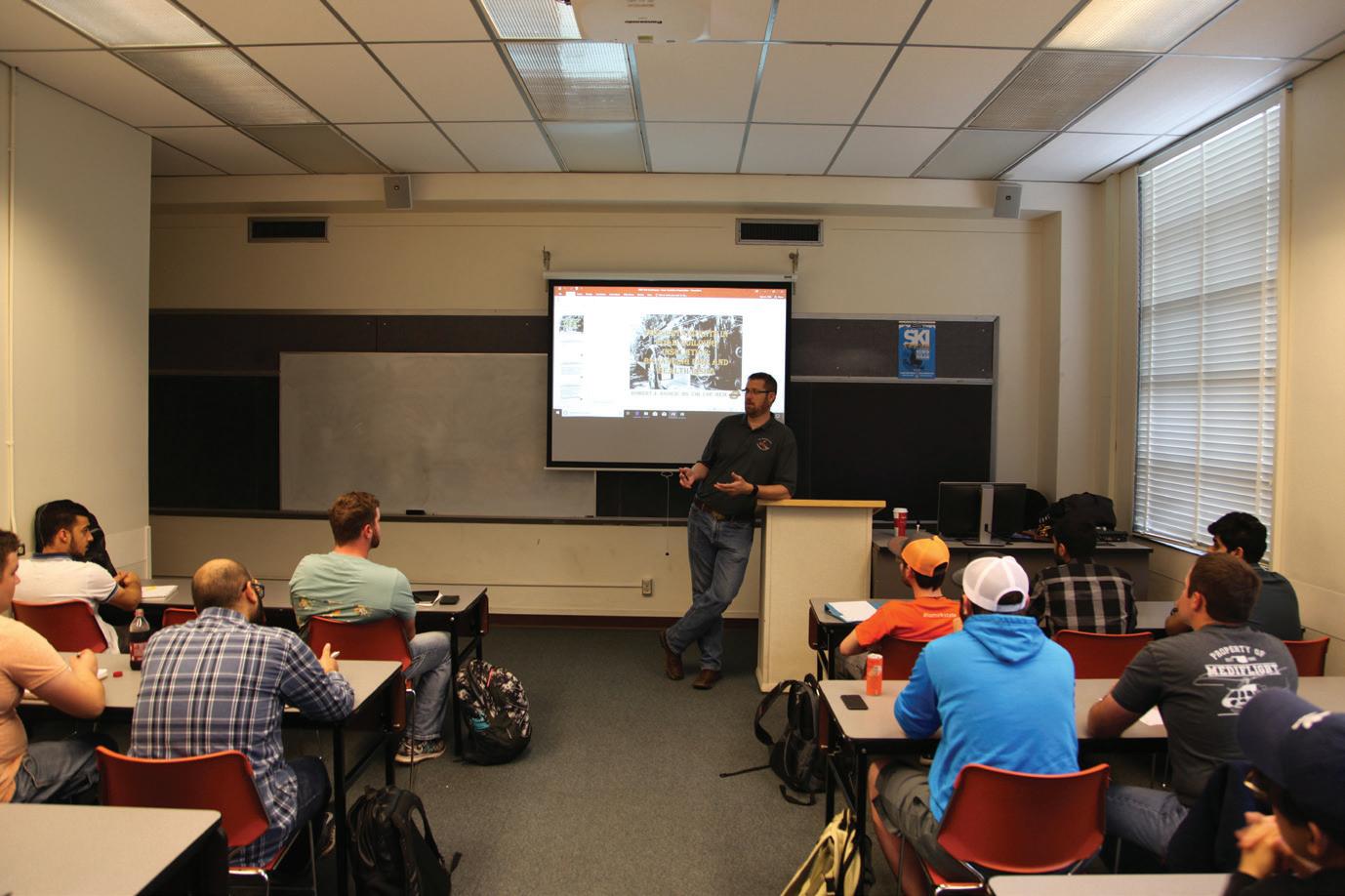
“There are some really synergistic opportunities between the Zink Center and the Riata Center,” Fisher said. “And when you get teams of innovative engineers together with forward thinking business and marketing students who really understand how to launch startup companies, the opportunities are endless.”
The east addition will also house the 207-seat Chickasaw STEM Auditorium.
The second floor sees the return of the School of Electrical and Computer Engineering to the building and the third floor will host the School of Mechanical and Aerospace Engineering. The basement former dean Lohmann constructed will house the building’s HVAC system and the fourth floor will house a student study area.
“Since we have been in the General Academic Building, we have felt somewhat disconnected from CEAT and the other schools within our college,” Harimkar said. “We are eager to move closer to the college community again, which will promote cross-departmental collaboration and enhance our ability to engage with our students.”
The multi-million dollar project has been a small price to pay for a building that has meant so much to CEAT for almost a century.
“If there is one common theme used to describe the College of Engineering, Architecture and Technology, it would
be growth,” said outgoing CEAT Dean Paul Tikalsky. “And just like the leaders of yesteryear, we will continue to support and promote that growth in our facilities, in our faculty and sta and in our student body, so that we can continue to provide an innovative, world-class education that is at the cutting edge of energy, aerospace, computing, sustainable building technologies and our nation’s future.”
LEARN MORE
If you are interested in CEAT’s mission to lead in high-tech innovation and attract the brightest students and faculty, please consider contributing to the visionary spaces being constructed in Engineering South. There are naming opportunities available, as well as a donor wall, to honor your gift or pledge.
Contact Foundation Associate Bryce Killingsworth, Dr. Jeffrey Young (Head of the School of Electrical and Computer Engineering) or Dr. Sandip Harimkar (Head of the School of Mechanical and Aerospace Engineering).
Bryce Killingsworth
Director of Development, CEAT bkillingsworth@osugiving.com
405-385-5623
Dr. Jeffrey Young
Professor and Head
School of Electrical and Computer Engineering jl.young@okstate.edu
405-744-5151
Dr. Sandip Harimkar
Professor and Head
School of Mechanical and Aerospace Engineering sandip.harimkar@okstate.edu
405-744-5830
OSU CEAT 41
Many of the classrooms prior to Engineering South’s renovations featured outdated furniture and equipment.
Centennial Celebration
CEAT Professional Development has served crucial function for nearly a century
The College of Engineering, Architecture and Technology’s Professional Development is approaching 100 years of providing customized training to workers and employers and it’s only continuing to expand.
Professional development means gaining new skills through continuing education and career training after entering the workforce.
Oklahoma State University provides customized training that can be tailored for specific organizations and is available online and in person. A few of the di erent program areas include fire prevention and loss control, highway construction materials
technology, specialized engineering topics, and Occupational Safety and Health Administration (OSHA).
“Professional Development has a 98-year history of providing applied training to defense, oil and gas, construction, health and safety, fire prevention and environmental compliance sectors,” said Jessica Stewart, director of Professional Development. “Today, we serve as a primary point of contact for those seeking hands-on training, conference and symposium opportunities and customized career development courses. Those are backed by landgrant research, teaching and Extension expertise.”
In September 2017, OSU was selected as an OSHA Training Institute (OTI) Education Center. OTI Education Centers are nonprofit organizations o ering training on OSHA standards and occupational safety and health issues.
Although the pandemic slowed growth in all training programs, the OTI Education Center is seeing growth. The 2022 OTIEC Annual Performance Appraisal shows OSU’s own growth in that area over the last year. OSU trained 435 students, representing a 6% increase from 2021 and 26% of the established goal of 1,700. This was an all-time high number of students trained for the growing center.
 STORY BAILEY SISK | PHOTO KRISTI WHEELER
STORY BAILEY SISK | PHOTO KRISTI WHEELER
42 IMPACT 2023
Stillwater Medical Center sta perform donning and do ng exercises through Professional Development’s hazwoper class.
CEAT Professional Development’s ability to specialize in industry responsive training encourages a variety of state and local government agencies, municipalities, private companies and individuals wishing to upskill for their personal career development to look to the department for their training needs.
Megan Warrington, OSHA program coordinator, said Professional Development and OTIEC courses are open to the public and industry.
“I think there’s a perception out there that we serve internally for the university,” Warrington said. “The majority of our clients are external groups and companies. We have national, and with some programs, international reach there.”
Students in each course are promised more than just lecturebased training. CEAT Professional Development training di erentiates itself by making each course as interactive as possible. Access to the university’s facilities and labs helps accomplish this goal.
“This department has really specialized in having applied training where it’s very hands-on,” Warrington said. “So, it’s not just going to be sitting in a classroom, it’s going to be the actual hands-on application of whatever that topic is. Because we do have access to some of the engineering labs and faculty have access to a lot of di erent resources there.”
Brad Jones worked in computers, the oilfield, the railroad and construction before taking an OSHA course with OSU. Before receiving the double Certified Safety and Health O cial (CSHO), Jones had seen little appreciation and implementation of safety in his previous jobs.
“I have traveled to a few states working in safety and trying to convert workers like me into safetyconscious employees,” Jones said. “It is not always easy being one of the most unliked professions, but there is a secret. I was taught to teach and inform people why things are done a
certain way. I strive to be the ‘safety’ person everyone wants, and I believe I have achieved it.”
OSU is home to the world-renowned Fire Protection and Safety Engineering Technology (FPSET) undergraduate program, which is ABET accredited and a Qualified Academic Program through the Board of Certified Safety Professionals. Three of the seven faculty members hold advanced degrees and multiple certifications. In addition to teaching academic courses in the FPST bachelor and master’s programs, they also contribute to the OTIEC through curriculum development and course instruction.
Faculty at CEAT Professional Development go above and beyond to bring people in the industry the best experience. Wendy Johnson, program coordinator, has provided students with meals, excursions and in some cases, arrangements for a place to stay. Her days can start from 7 a.m. and last until around 9:30 p.m.
“We see quite a few repeat people,” Johnson said. “We also have lots of companies that love this lab so much that they come about three times a year to bring di erent employees in for training. So not only do we see repeats of individuals, but of companies.”
The department works to grow and adapt to new changes each year. Program coordinator Bonnie KaiserGambill has worked in the department
for over four years and has assisted in several di erent programs.
“Every year I feel like we reassess,” Kaiser-Gambill said. “We try to make it better with big changes. There have been some sta shifts internally, but that also helped us grow with new people and new perspectives. Overall, we have focused on the online aspect as COVID-19 hit. Our focus is understanding meeting the needs of people and being really adaptive to people along the way.”
Expansion is the goal for CEAT Professional Development. Whether it’s sta , students or technology, the program is hoping to grow and become more industry responsive. The department has worked toward its accomplishments with a sta of less than 10.
With continuous growth in all areas, Stewart hopes that in a few years, CEAT Professional Development will use the growth to specialize in nationwide industry areas.
“We’re excited to work with companies and educational partners to assess and determine how we can serve in the advanced mobility, renewable energy and energy e ciency technology sectors,” Stewart said. “Our mission is to ensure the cutting-edge knowledge and expertise at OSU is translated into training opportunities our companies need to ensure their current and incoming employees are prepared.”
“I think there’s a perception out there that we serve internally for the university. The majority of our clients are external groups and companies. We have national, and with some programs, international reach there.”
MEGAN WARRINGTON, OSHA PROGRAM COORDINATOR
OSU CEAT 43


STORY GRANT RAMIREZ | PHOTOS PROVIDED 44 IMPACT 2023
10 YEARS AFTER ITS A OUNCEMENT, MAJOR GIFT CONTINUES TO MAKE AN IMPACT THROUGHOUT CEAT
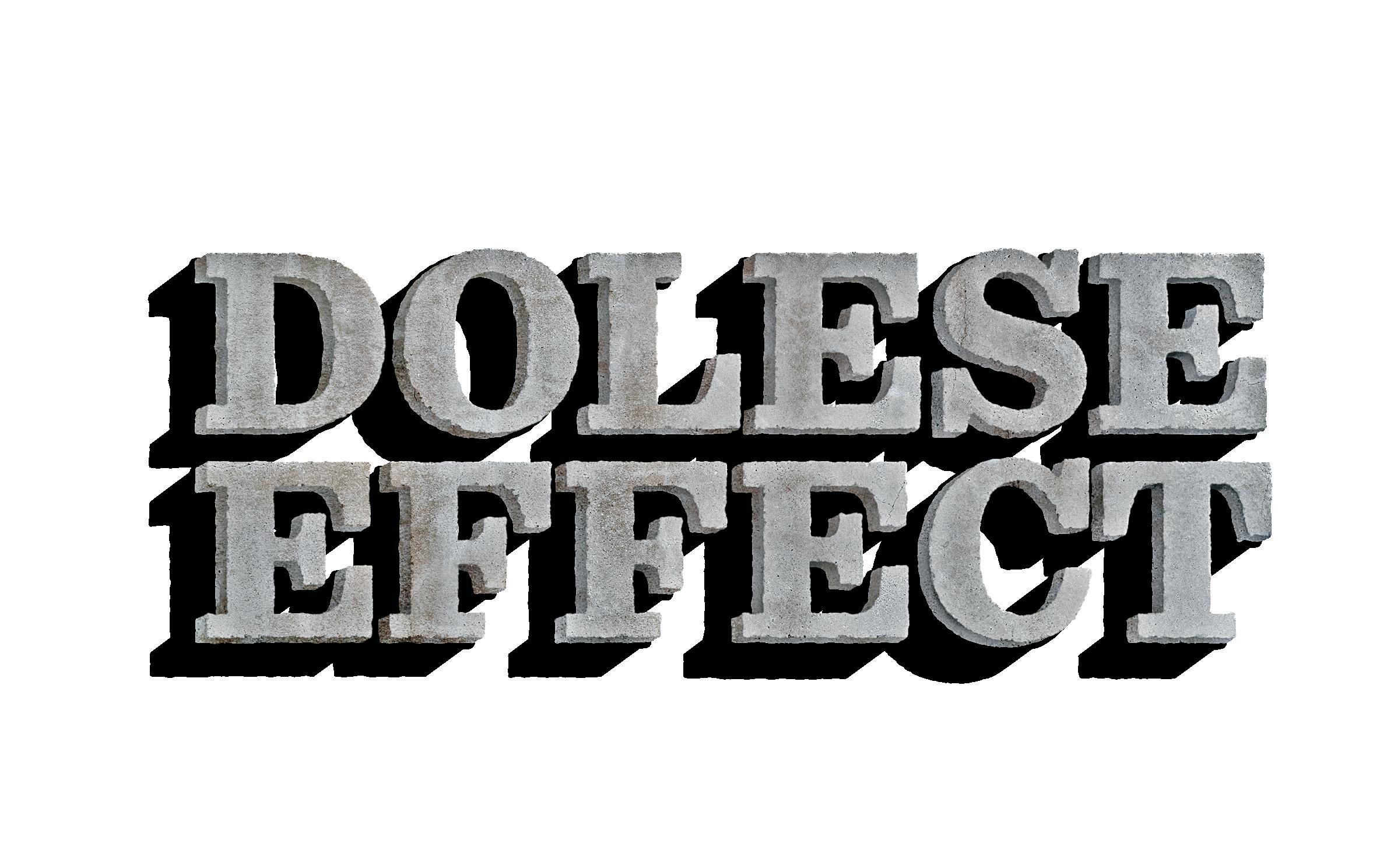
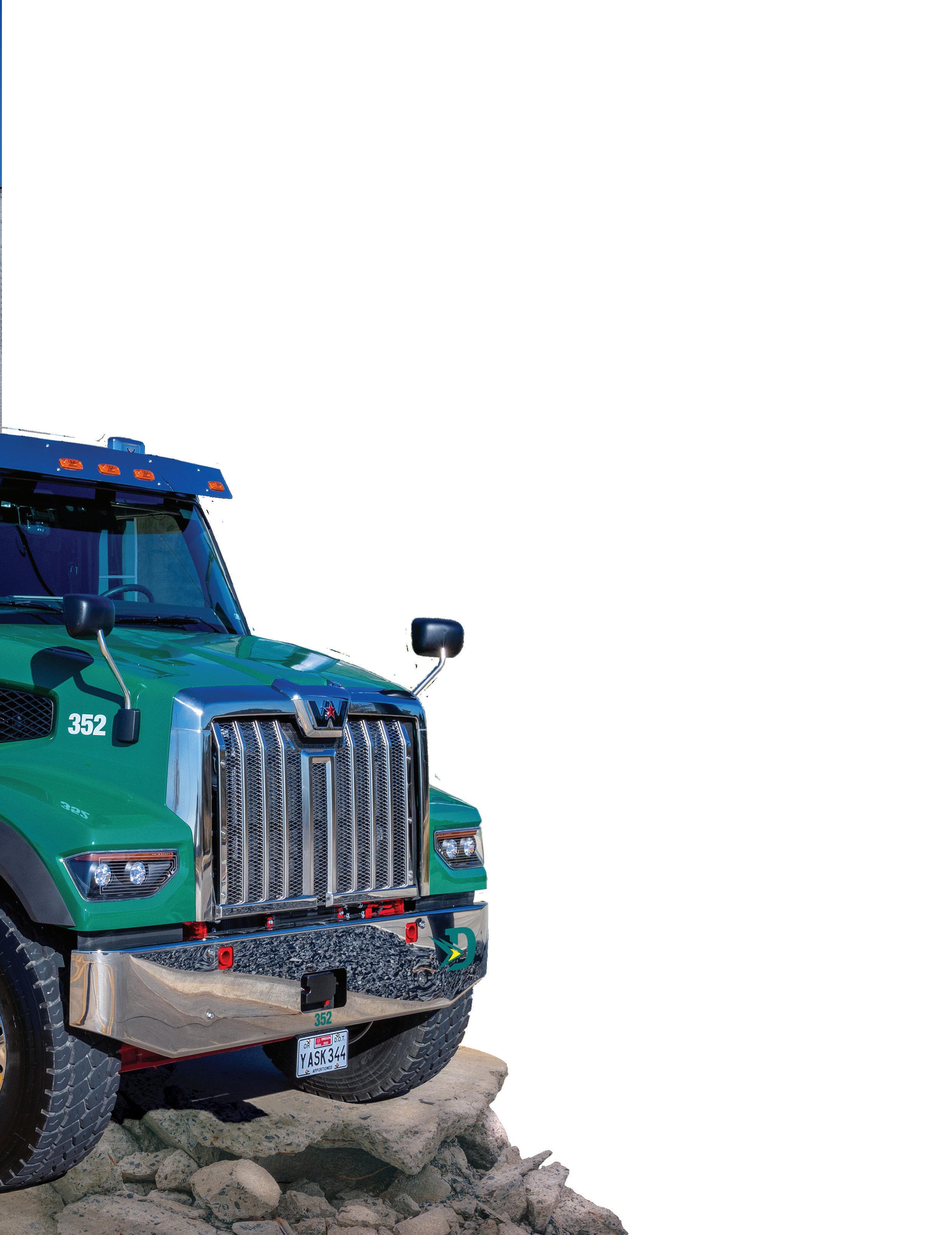

The OSU CEAT 45
“Through this gift, we’ve not only been able to create a bright future for numerous engineering students, but also ensure our company remains true to our Oklahoma community and gives back to each Dolese employee for their service to the company.”
Roger, son of co-founder Peter Dolese, led the company for 58 years until his death in 2002. Although Dolese does not employ many engineers itself, it was a profession Roger had great admiration for, which was his motivation to give to CEAT.
He hoped the gift would increase the number of engineers in the workforce. OSU has done its part to make that vision become a reality.
Scholarship support has made the most impact in how the Dolese gift supports students. It’s been a driving force behind helping more people attend OSU and ultimately walk across the graduation stage.
Since 2012, the number of undergraduate engineering degrees awarded each year has more than doubled. During that time, degree production for mechanical and aerospace engineering has increased 151%, a figure exponentially higher than the university average of 28.6%.
Industrial engineering as well as electrical and computer engineering have also seen huge boosts in degree production with 207% and 84% increases, respectively.
“The growth of our engineering programs over the past decade has been remarkable,” said Dr. Jeanette Mendez, OSU provost and senior vice president. “And the scholarships and other student programs funded by the Dolese gift have certainly played a part in that. I’m so glad we have been able to fulfill Mr. Dolese’s goal of increasing the number of engineering graduates in the state.”
Last year, over $1 million of Dolese funds went toward direct scholarships that included CEAT Scholar awards, need-based applications, national
merit scholars and other STEM scholarships. Another $152,500 was awarded as global study scholarships. Each of these awards is significant, as none was worth less than $2,500.
The CEAT Scholars program in particular, which used the Dolese funds to match other donors resulting in a combined impact of $722,935 in 2022, has seen significant growth in recent years.
Elevating the Student Experience
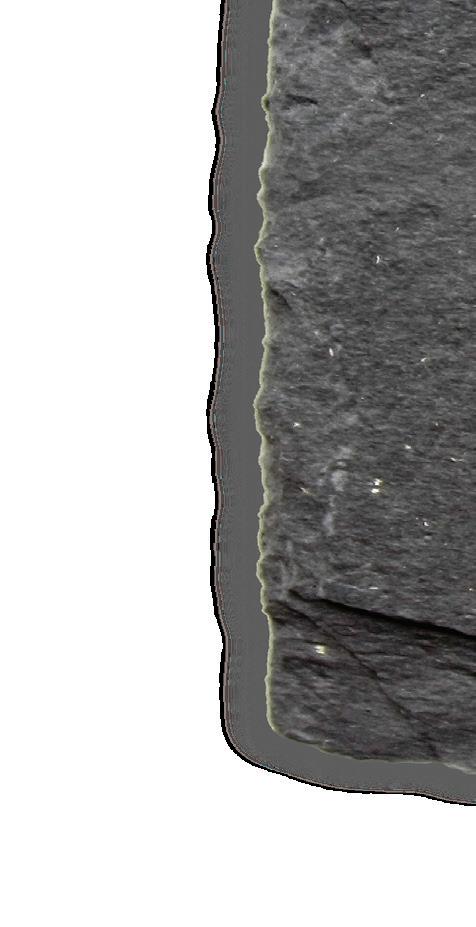

Molly Hoback is a CEAT S cholar and OSU senior studying architectural engineering. The program completely transformed her college experience, including allowing her to go on a 10-day study abroad trip to Finland last summer.
She said her time in Stillwater wouldn’t be complete without being involved.
“The CEAT Scholars program is not only a scholarship; it is a platform to enrich our college experience,” Hoback said. “It’s connected me to other motivated CEAT majors and allowed me to do so many more things that I simply would not have gone out and done on my own.”
Hoback has been impacted by the Dolese e ect in more ways than one. She is also involved with Parker Engineering, Architecture and Technology Experts and CEAT Summer Bridge, which both helped ease her — and countless other students’ — college transition.
These two programs wouldn’t have been possible without Dolese’s generosity.
PEATEs are upperclassmen mentors who live in Parker Hall, a residential hall designated for CEAT students.
Hoback is one of nine PEATEs who work to create a community feel, help residents build relationships with each other and provide general guidance.
Many CEAT Scholars also serve as CEAT Ambassadors, a group of students who work to promote the college to prospective students and guests.

46 IMPACT 2023
“Parker was a small community where we all could support each other through the struggles of college and freshman-level engineering classes,” Hoback said. “I applied to be a PEATE because they made the dorm a home for everybody my freshman year, and I really wanted to contribute and make it better.”
Summer Bridge, meanwhile, lends a helping hand to freshmen before they even start their classes. It’s a three-week preparatory program for students who plan to study a CEAT major.
Students can become accustomed to the rigors of CEAT coursework with academic review, mock exams, orientation seminars and engineering design projects. Preparation for Calculus I, specifically, is a focus.
The program is a factor in helping students navigate college, and even has the potential to help them shorten time to graduation depending on their level of math readiness.
Hoback participated in Summer Bridge as a freshman, and her experience motivated her to become a program counselor, a role she held for two years.
“Summer Bridge really set me up to succeed,” Hoback said. “The program helped me get familiar with campus, meet new friends and mentors, and get acclimated to the rigors of college. By the first day of the classes, I was still nervous, but I felt prepared.”
Developing Future Engin rs
Dolese’s role in increasing CEAT’s student success rate isn’t just limited to students in their first year. The Dolese gift allowed the college to host student-led discussion and tutoring sessions. They were so beneficial that the sessions are now university-funded.
CEAT has even benefited future generations of engineers by holding K-12 STEM summer camps.
Current OSU students work with second-eighth grade students, while young professionals and graduate students mentor ninth-12th graders to hopefully cultivate an interest in a future STEM career. The camps, which were started with Dolese funds, are now sponsored and funded by the U.S. Department of Defense.
“Not only are these programs beneficial to the attendees, but they also give our students a chance to hone their communication skills,” Tikalsky said. “They have to figure out how they can explain thermodynamics in a way that anyone can understand.”
Along with the academic impacts of Dolese’s gift, OSU research e orts have benefited, too. For more than a decade, numerous undergrad research positions and assistantships have been created.
For example, student work at the Bert Cooper Structures and Materials Laboratory has all been funded by Dolese. Fittingly, the lab’s primary focus is research related to concrete.
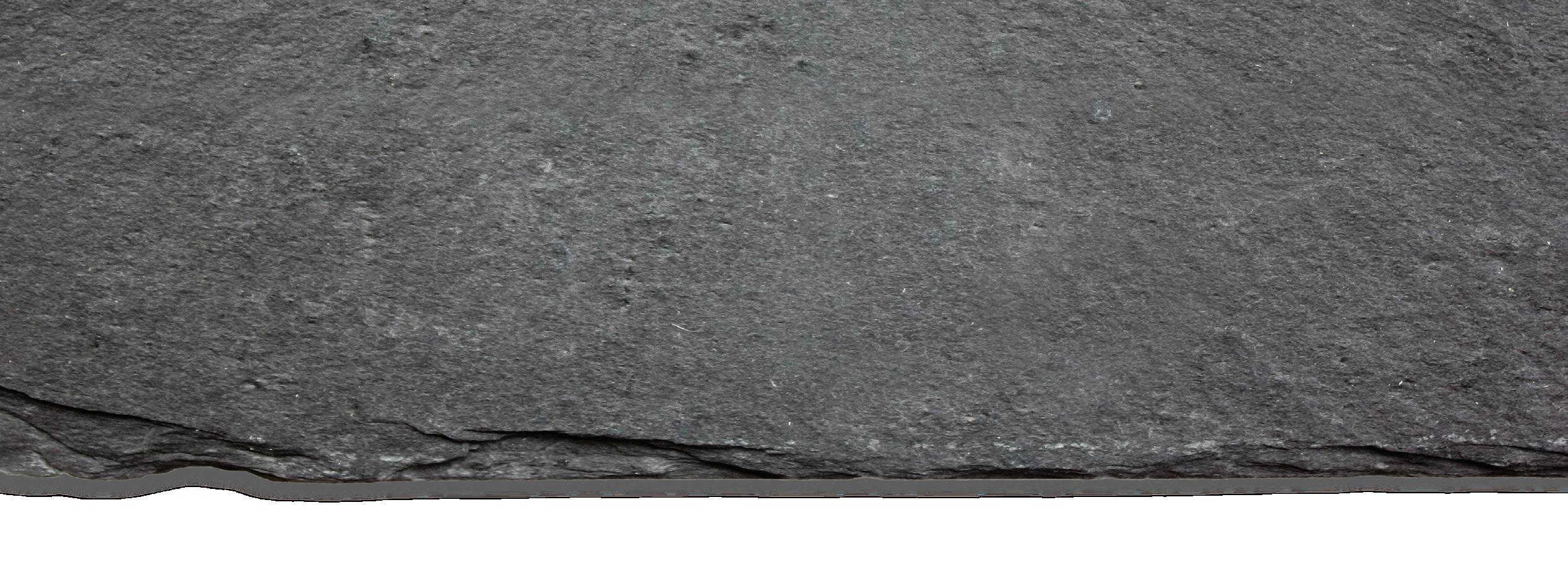
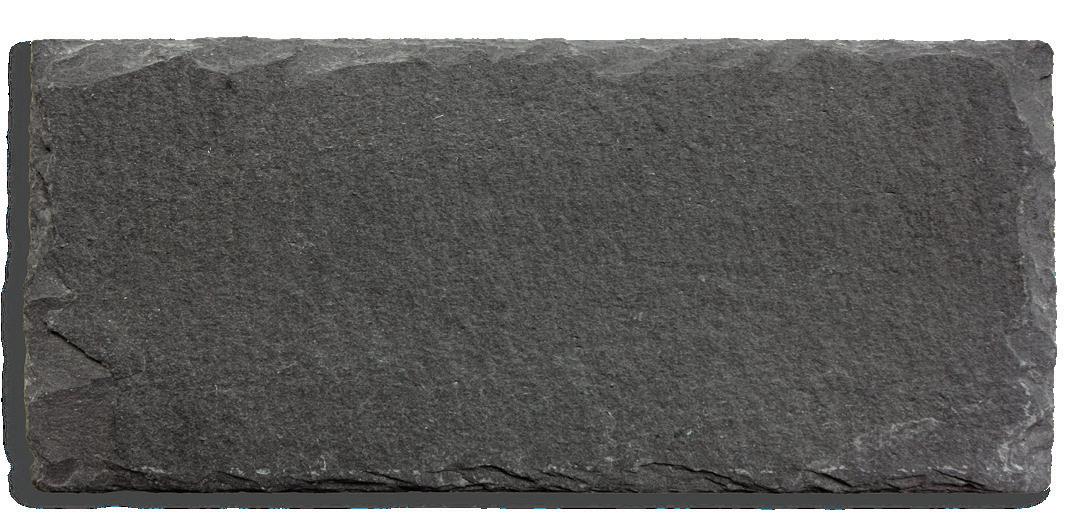
Students working at the lab, such as Josephine Lee, a senior studying civil engineering, gain a new understanding and appreciation of the industry. Lee has been involved with the lab since her freshman year.
“Concrete is such a widely used material, it is important for us to understand how to improve it,” Lee said. “The skills I’ve learned working there, along with the relationships I’ve built with other engineering students at the lab, will definitely be valuable in my future career.”

Even 11 years after the gift was made, the Dolese e ect continues to make an impact throughout CEAT. And the ripples won’t stop anytime soon.
“Engineering is everywhere — from Dolese concrete to my desk chair,” Tikalsky said. “This gift has been an instrumental part of our college’s success. Dolese continues to change lives at OSU and beyond, and its impact shouldn’t be overlooked.”
INSPIRED BY THIS STORY OF GENEROSITY?
Make a gift to benefit CEAT or find out how you can make a difference by contacting Bryce Killingsworth at bkillingsworth@OSUgiving.com or by visiting OSUgiving.com.
"Through this gift, we've not only been able to create a bright future for numerous engineering students, but also ensure our company remains true to our Oklahoma community and gives back to each Dolese employee for their service to the company."
OSU CEAT 47
MARK HELM, PRESIDENT & CEO OF DOLESE BROS. CO.
RECORD 5ETTING RESEARCH
A STORIED
5 CEAT RESEARCHERS RECEIVE NSF CAREER AWARDS

DR. AURELIE AZOUG
DR. JOHN O’HARA
DR. MARIMUTHU ANDIAPPAN
DR. NICOLETTA FALA
DR. RITESH SACHAN
The College of Engineering, Architecture and Technology at Oklahoma State University has always been home to researchers and innovators who are providing solutions to some of the world’s biggest challenges.
These researchers have garnered recognition and support from prominent entities such as the National Science Foundation (NSF). However, 2023 has seen a record five CEAT recipients of the NSF’s Faculty Early Career Development Program (CAREER) awards.
The CAREER Award offers the NSF’s most prestigious awards in support of early career faculty who can serve as academic role models in research and education and lead advances in their department or organization’s mission.
48 IMPACT 2023 STORY JEFF HOPPER | PHOTOS GARY LAWSON
Dr. Aurelie Azoug has been selected to receive an Early CAREER Award from the NSF of nearly $600,000 to conduct research in the area of dissipation mechanisms in smart elastomers.
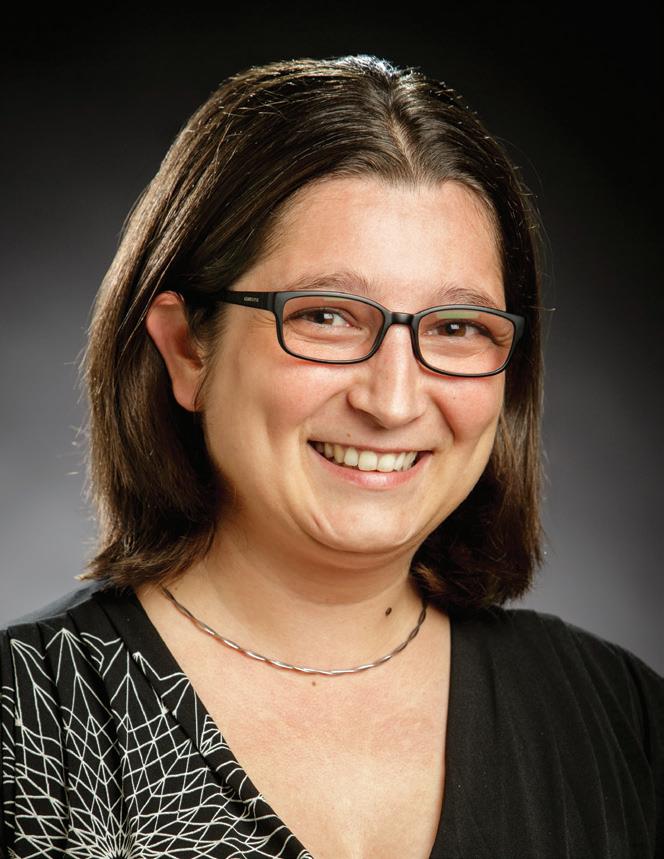
This research allows Azoug, an assistant professor in the School of Mechanical and Aerospace Engineering, to better understand the mechanisms leading to energy dissipation of smart elastomers and thus better control those mechanisms for future applications.
“This award is very validating,” Azoug said. “It’s a recognition that says, ‘Hey, you’re doing good science and we’d like to see you continue down this path and see where you can take this research.’”
These liquid crystal elastomers are constructed so that while they contain a highly organized structure, at the molecular level, they retain a soft and stretchy behavior which allows for a wider variety of applications. They are also smart, which means they react to changes in their environment, such as thermal or mechanical changes.
Research into smart elastomers is relatively new and has primarily been focused on the creation of these materials, both from a chemical and physical standpoint. There has, up to now, been little research into the properties of these materials and the secondary characteristics that may be useful to researchers and consumers.
DR. AURELIE AZOUG School
of Mechanical and Aerospace Engineering
Because of the organized structure, there is a dissipation of energy within the material when it deforms. These dissipation mechanisms could significantly improve the performance of dampers used in the reduction of vibrations or noise. If researchers better understood how these dissipations occur, they could better curtail their construction for specific purposes.
“That’s the premise of this proposal,” Azoug said. “Can we understand exactly what is happening in the material during certain environmental or mechanical changes? If so, we can then use that information to apply those characteristics when we do and do not want those dissipation mechanisms occurring.”
Azoug will also explore the methods by which these materials are physically solidified during the curing process. Currently, many elastomers are cured using UV light sources, as it is the fastest and most controllable curing method. Azoug and her team wish to explore how to optimize curing and determine whether curing parameters could play a role in deciding some of the dissipation characteristics of these materials.
She believes by understanding these behaviors at a molecular level, these smart elastomers could be used in composite materials for applications in di erent areas such as energy
harvesting, health care and soft robotics.
“A perfect example of application would be the use of these materials in the production of vibration dampening materials to be used inside a football helmet,” Azoug said. “If we can identify an elastomer that is very e cient in the dampening of shocks, we could produce a new composite material that could line the inside of a football helmet and produce a larger impact on the health of athletes at a lower cost.”
The NSF CAREER award also requires an education component for each proposal, and Azoug’s focus is one she is deeply passionate about: introducing young women from kindergarten to high school to STEM fields.
The researcher and her team plan to further develop outreach activities they are already conducting, such as an introduction to soft robotics using remarkably simple soft robots made of elastomer that students could manipulate and control through coding.
“I believe it is paramount for these young women to be exposed to these areas of science and to have female engineers and scientists teach them,” Azoug said. “I want girls to have the opportunity to see a woman be successful and have a career in engineering. I want them to know that pursuing that type of career is OK and that they can do it, too.”
OSU CEAT 49
Oklahoma State University will continue to be an innovator in next generation communications in part because of a Faculty Early CAREER Award from the NSF given to Dr. John O’Hara, an assistant professor in the School of Electrical and Computer Engineering.

O’Hara will be researching solutions to several challenges surrounding wireless backhaul for 6G wireless communication. Backhaul refers to the large bandwidth, usually fiber optic, connection that carries massive amounts of data from numerous wireless and static communication sites to a core network.
“Think of it as a large pipe that connects a lot of smaller pipes to a large collection site,” O’Hara said. “Next generation, 6G communication is likely going to have data transfer rates of up to 1 terabyte per second and we don’t have the system in place to transmit that amount of data wirelessly.”
O’Hara and his team are developing a system that will use terahertz waves as the vehicle for data transmission. Terahertz waves can carry vast amounts of data but behave much like a laser and are subsequently prone to some of the same challenges that lasers face.
Pointing is a major issue with lasers and an unknown factor when dealing with terahertz transmission. If the signal or receiver shifts a fraction of a
DR. JOHN O’HARA
School of Electrical and Computer Engineering
degree, will that cause a complete loss of signal? If so, what solutions are the most practical to employ?
The team plans to use intelligent reflective surfaces as multifunctional beam controllers. The combination of terahertz and intelligent reflectors allows for the transmission of high bandwidth wireless signals while overcoming the di culties of using terahertz waves in an uncontrolled environment.
Although it may sound like a straightforward solution, the challenges the team will face require innovative technologies and science to be developed to solve them. Wave fluctuation, environmental variables and data loss during transmission are just a few challenges that the team will encounter.
“Terahertz and next gen communication has a fairly well-defined vision,” O’Hara said. “But not a lot of demonstration to this point. This next generation of wireless communication technology is still in its infancy. It’s like a baby elephant, it may be a baby, but it’s a big baby and will require a lot of e ort to tame.”
The research team has already begun experimenting with data transmission in an outdoor environment. To date, they have been able to send data over a stretch of 182 meters and are aiming at over a kilometer for their next milestone.
The goal is to wirelessly transmit an ultra-high-definition video that is delivered via fiber optic cable to the terahertz broadcast system; receive it over a long range through atmospheric conditions; and then convert it back to fiber optic cable for viewing.
If successful, this will serve as a proof-of-concept foundation for 6G wireless communication systems, demonstrate new concepts in intelligent reflective surfaces and reveal the new science governing such systems.
“A distance of 182 meters might not seem like a lot,” O’Hara said. “But that has given us invaluable data and experience that we can use as we lengthen the distance between transmission and receiving points.”
O’Hara and his team also recognize the significant societal impact next generation communications will have, specifically in rural communities that may not have the bandwidth.
While being a respected researcher, O’Hara values the recognition of the NSF CAREER award and attributes his success to an amazing support system and a touch of serendipity.
“I call it luck,” O’Hara said. “I’ve been very fortunate to have been surrounded with immense support and great colleagues and it’s a bit serendipitous, just be at the right place at the right time and capitalize on opportunities that you’re a orded.”
50 IMPACT 2023
Dr. Marimuthu Andiappan, an assistant professor in the School of Chemical Engineering, has received an Early CAREER Award from the NSF for his research on carbon-carbon and carbonnitrogen cross-coupling reactions.

These types of reactions are prevalent in chemical and pharmaceutical industries for making conjugated polymers, agrochemicals and pharmaceuticals, such as Tylenol and ibuprofen.
However, current technology and industry processes use expensive, rare palladium-based catalysts and require high-temperature and atmospheric pressure conditions to produce the intended results. These processes also produce a large amount of waste before the product is yielded to the measure of 25 to 100 kilograms of waste for every one kilogram of product yielded.
Andiappan and his team’s focus is three-pronged: replace the expensive and rare palladium catalysts with inexpensive, Earth-abundant copper or iron-based photocatalysts. Because of new photocatalysts, the reactions would not require high heat or atmospheric pressure conditions and would rely on simple LED lights producing
DR. MARIMUTHU ANDIAPPAN School of Chemical Engineering
visible light. Finally, the use of these heterogeneous photocatalysts allows the reaction and procurement of the product to take place in a single, fluid chamber and makes the current processes used to separate the product from the catalyst unnecessary.
“The three steps in this proposal would allow us to minimize or avoid the carbon footprint of these critical processes,” Andiappan said. “Eventually, we hope that these processes will become net carbon zero processes.”
These reactions rely heavily on the use of fossil fuels and other nonrenewable energy sources to yield the important end products. However, proposed changes allows engineers to carry out these reactions using the electrical grid already in place, and they could begin to explore alternate energy sources, such as wind or solar energy.
“E orts like this proposal will allow us to develop these new technologies and processes at the requisite pace, so that we can develop a workforce that is prepared for the transition to a heavier reliance on renewable and sustainable energy sources,” Andiappan said.
The processes currently used in industry are the same processes that
have been used for decades and continue to be taught in classrooms to future engineers and scientists. As part of his award, Andiappan hopes to change that by integrating his research into the curriculum at OSU via a new elective course for students in CEAT and other interested departments across campus.
“If we were to integrate a new course focused on these new processes and technologies into our curriculum, OSU students would graduate with a more competitive and well-rounded skillset than perhaps a student from a di erent university,” Andiappan said. “That way we can supply more skilled engineers and scientists for the state of Oklahoma and the entire U.S.”
As he and his team embark on the next steps in their research, Andiappan reflected on the milestone of receiving an NSF Early CAREER award.
“It’s an amazing recognition to receive. It is an amazing feeling to have our research recognized by our peers and national agencies like the National Science Foundation,” Andiappan said. “It has provided a lot of confidence to me and my students to move forward and continue this amazing research.”
OSU CEAT 51
Dr. Nicoletta Fala, assistant professor of mechanical and aerospace engineering at OSU, has earned an Early CAREER Award from the NSF for her research on the use of virtual reality in flight simulation to advance and promote research and positive skill transfer in enhanced flight training.
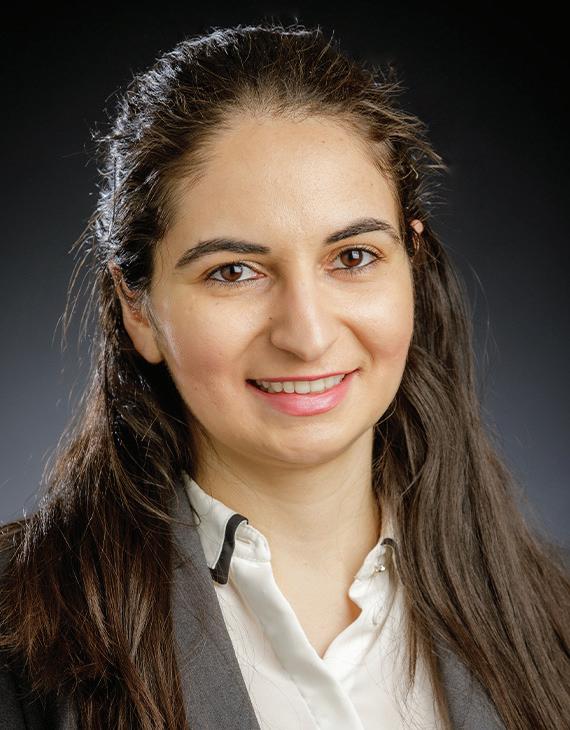
The College of Engineering, Architecture and Technology researcher believes standard flight training and research could be augmented and advanced using VR flight simulation hardware and software applications, which could have a significant impact in addressing the world’s ongoing pilot shortages.
“If we have the right virtual reality software and curriculum design, we could use that to maintain pilot proficiencies and skills, thus reducing the cost of training and obstacles to entry into flight-related research, as well as accidents occurring due to lapses in training,” Fala said.
She believes that, while not all skills can be learned via VR training, there are a plethora of crucial flight skills that could be initially introduced and trained using environments outside of actual aircraft and traditional flight simulators.
“Current in-aircraft and simulated flight training requires resources that are both expensive and need a large and
DR. NICOLETTA FALA
School of Mechanica l and Aerospace Engineering
specific footprint to operate,” Fala said. “However, if a VR training simulator is proven to be just as e ective as traditional methods of instruction, we could significantly reduce the cost to train both new and current pilots.”
Fala hypothesizes flight skills that require more visual fidelity, as opposed to movement fidelity, could be adaptable to a VR environment. She noticed during a preliminary experiment that when her research students were asked to complete a “turn around a point” maneuver — used to train students to account for wind in their control inputs when circling a stationary point — they struggled in a traditional flight simulator environment due to a lack of field of view. However, when asked to complete the same maneuver in a VR environment, the students could complete the task more easily because of VR’s ability to produce a 360-degree view for users.
While this particular task was deemed a “win” for the VR environment, Fala and her team have identified challenges that students, instructors and current pilots could face using this new simulation approach. Pilot interactions, whether with an instructor or avionics, will face challenges in a VR environment.
“In order to make this project successful, the first thing we must focus on is overcoming the challenges
we’ve identified, such as developing a way to overcome student-instructor interactions and communication in the training environment,” Fala said. “Also, many modern aircraft have digital avionics which require pilot interaction and input to operate, which can be harder to replicate in a virtual environment.”
The NSF CAREER Award will allow Fala and her team to overcome and answer those challenges and questions encountered while creating and developing a viable way for new and current pilots alike to augment their training. It will make it easier to grow the pilot population and bolster recurrent training in a more cost- and time-e cient manner.
“Receiving this award has been a goal of mine since I was a graduate student and my own advisor received a CAREER award,” Fala said. “I am passionate about all components of the project: education, research and implementation, so it seemed like it was made for me. It’s nice to have someone else who believes in your work. It’s easy to formulate an idea and believe that it is a good idea in your own silo, but to also have the recognition of your peers and others in the research area agree is very rewarding.”
52 IMPACT 2023
Dr. Ritesh Sachan has been awarded a Faculty Early CAREER Award from the NSF to conduct first-of-its-kind research around high-entropy alloy nanoparticles.
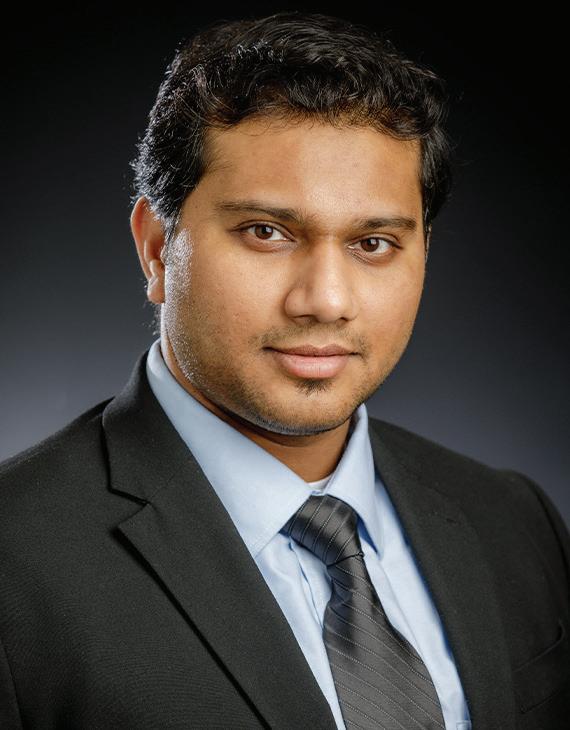
Sachan will receive more than $500,000 over the next five years to further his research proposal, “Leading to Accelerated Discoveries in HighThroughput Ultrafast Laser-Driven Processing of High Entropy Alloy Nanoparticles,” an area that is mostly undiscovered territory.
“I am honored to get this award,” said Sachan, an assistant professor in the mechanical and aerospace engineering department. “It is very prestigious and highly regarded among our academic and research peers. It creates a lot of visibility for myself and my research which allows for further funding opportunities and the opportunity for collaboration with others in the field.”
Alloys are used every day. Steel, brass and bronze are all materials primarily comprised of two or three dominant materials. Sachan’s research is focused on the formation and composition of high-entropy alloys that contain at least five di erent elements or materials in various percentages. These high-entropy alloys could be found to have the same or better characteristics than some of their pure or traditional alloy counterparts.
DR. RITESH SACHAN
School of Mechanical and Aerospace Engineering
These nanoparticles are created by firing a laser through a thin film of each composite material which causes the film to break, shrivel and eventually create nanoparticles that can be tested.
The predominant application of these materials is catalysis for energy production. These processes tend to use expensive or scarce materials, whereas this research could find a new material that is just as e ective but composed of more cost-e ective and abundant elements.
“Long-term, cost e ectiveness is the biggest benefit,” Sachan said. “Right now, the most popular catalyst is platinum, which is very expensive. However, if you can replace that with new materials made of nickel, cobalt, etc. you may still be able to yield the e ectiveness of platinum, but at a much lower cost.”
However, the product may not be the only groundbreaking aspect of Sachan’s research. While using laserdriven production methods is not a new concept, the adaptation of that method to the production of high-entropy nanoparticles will require original approaches and methodologies based on well-founded production methods.
“We are performing foundational research,” Sachan said. “New materials may not be the only product of this research, but the methods and procedures we use along the way could
be transformational to this area of research.”
Sachan will be conducting fundamental research in novel nanoparticle composition and its benefits, as well as using new methods to review and understand the microstructure of these nanoparticles. For example, he will be utilizing 4D STEM (4D scanning transmission electron microscopy) techniques coupled with machine learning to identify and understand the structural properties of these nanoparticles.
“This research is super exciting,” Sachan said. “The NSF labeled this proposal ‘high risk, high reward’ because we are the one of the first to venture into this particular area of research. It is both exciting and intimidating because of the unknowns.”
While the outcome of the research is unknown, the researcher remains unfazed by the challenges that lie ahead.
“It is exciting because we have a pathway forward,” Sachan said. “We know the steps we are going to take. Whether it is successful or not remains to be seen, but it will be an interesting journey.”
OSU CEAT 53
Like a Glove
Cowboy invents success o the field with new tool for football players
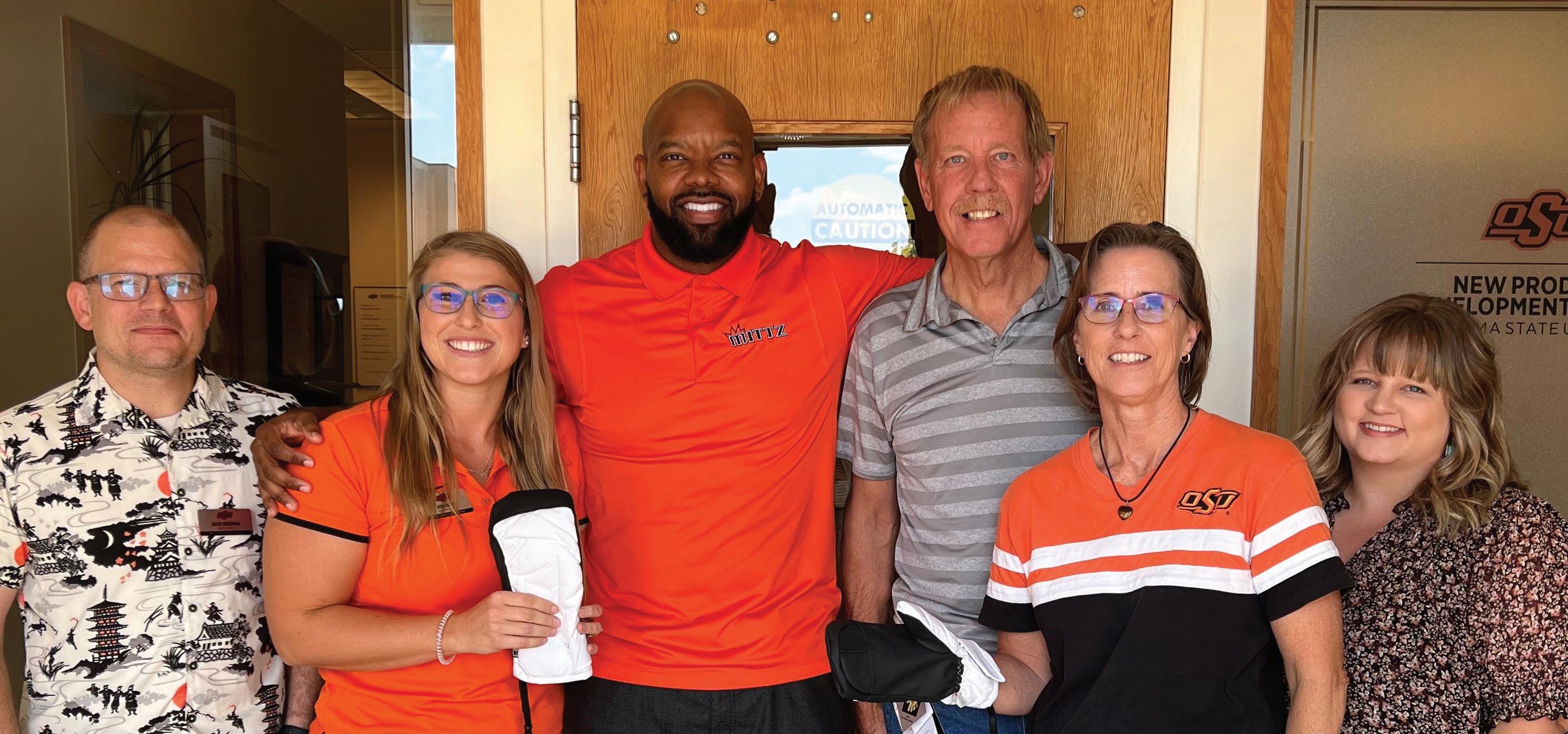
In a game of immense physical contact and competition, yards lost because of a holding penalty can mean the di erence between a win or loss.
However, thanks to a former Cowboy football player and inventor Ethan Howell, a new training tool could make some holding penalties obsolete.
He calls it Mittz, the first utility training glove for football players.
THE PROCESS
Howell, who has been involved in the game of football since childhood, first had the idea for Mittz in 2018 while watching a New Orleans Saints game.
“I was upset the Saints lost the game because a defensive player got called for holding,” Howell said. “And I wondered if there was something out there that could help with holding, but I couldn’t find anything in my initial research.”
After sitting on the idea for a couple of months, Howell decided to move forward with his brainchild and
contacted the Inventors Assistance Service (IAS) at the New Product Development Center (NPDC), an engineering Extension outreach unit in the Oklahoma State University College of Engineering, Architecture and Technology.
After Howell’s initial application the first step completed by IAS was the market analysis report and patent search phase.
“The initial research was di cult because the only item we found was a story about an NFL team that was using boxing gloves as a training tool in practice,” said Brenna Davis Long, program specialist at NPDC, who completed the market analysis and patent search. “Once we found that, we knew Mr. Howell was on to something and referred him to Tim Hartman, a patent marketing agent.”
After the initial application and research report, patent drawings were completed by IAS interns. With assistance from Hartman, Howell was then referred to Mary Lee, a patent attorney, to begin the patenting process and finalize his application.
Mittz was granted a patent in June 2021.
STORY BRENNA DAVIS LONG | PHOTOS HANNAH DAVIS AND PROVIDED
54 IMPACT 2023
Members of the New Product Development Center take a picture with Ethan Howell, the inventor of Mittz. From left: Jacob Weirman, Jodi Prouty, Howell, Robert Taylor, Jennifer Vinyard and Brenna Long.
THE PRODUCT
Mittz is a tool to help change performance behaviors that are commonly caused by unnecessary holding: grabbing and clutching.
“Mittz is specifically for o ensive lineman, defensive backs, defensive lineman and linebackers — or anyone who commonly gets called for holding in games,” Howell said. “It is a training tool to be used in practices and o season to gain muscle memory that will translate into games when players are wearing regular football gloves.”
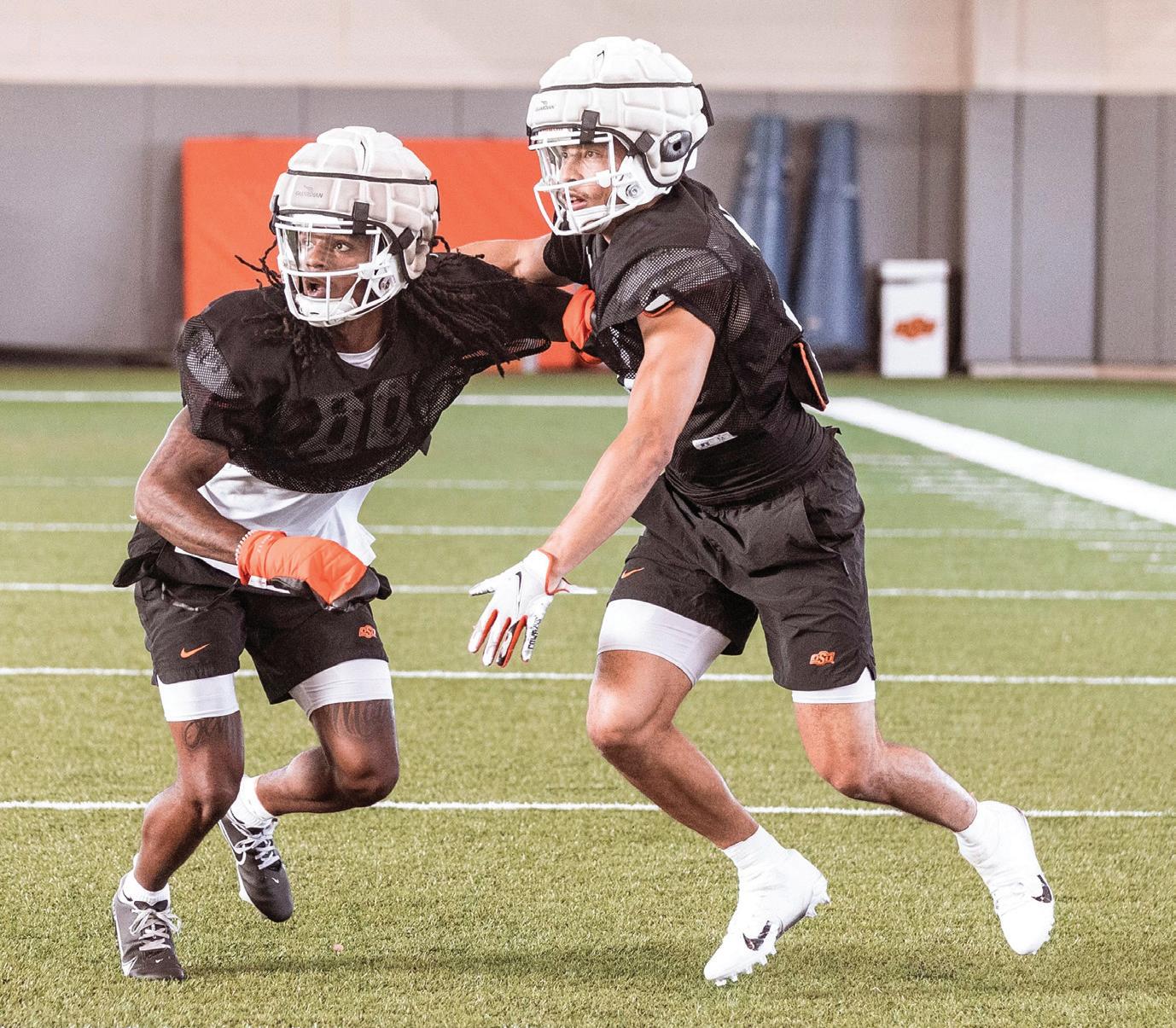
As a Cowboy football alumnus, Howell took his invention to the coaches of his alma mater first.
“They loved the idea and gave me the opportunity to bring Mittz to try out,” Howell said. “After a few weeks, the coaches wanted to purchase more gloves for the team and, as a result, OSU was one of the least penalized teams on the defensive back side in the country in 2022.”
Since proving success through product demonstrations, Mittz is now being used by many other universities across the nation including the University of Tulsa, Clemson University, Kansas State University and the University of Mississippi, as well as high school teams and NFL players.
“Mittz was important to me because I wanted to develop a product for the sport that I am most passionate about,” Howell said. “I am very proud to have received my design patent and to have had the chance to develop the product at my alma mater and to share that success with OSU and the team at NPDC.”
THE FUTURE
Mittz is already gaining a lot of traction on the national level with the goal to expand to new markets within the next year including more high schools and universities.
“To see Mittz being used by OSU and other top Power Five conference teams is just an honor and a blessing,” Howell said. “The support from the IAS program, Coach [Mike] Gundy, Coach [Tim] Du e and the Cowboy football program has been amazing. I look forward to seeing where we go from here.”

OSU CEAT 55
Members of the Cowboy football team practice with Mittz, a new product created by OSU alumnus Ethan Howell. The gloves are intended to help players like defensive backs keep from holding during a game.
The Problem With Plastic
OSU researcher investigating impacts of microplastics

According to National Geographic, as of 2015, 6.3 billion tons of plastic waste had been generated. Around 9% of that was recycled, 12% was incinerated and 79% accumulated in landfills or the environment.
Dr. Jorge Gonzalez Estrella, an assistant professor in the School of Civil and Environmental Engineering at Oklahoma State University, leads a team of researchers that hopes to learn more about the fate of those plastic materials and the e ect they may have on a variety of areas in the environment, particularly those that may be imperceptible to the naked eye.
“There is still a lot of unknowns concerning the e ects of microplastics on the environment and living organisms in the environment,”
Gonzalez Estrella said. “That’s what we’re trying to help with.”
Microplastics are defined as any plastic material between the sizes of 1 micrometer and 5 millimeters. These tiny bits of plastic are then broken into two categories, primary microplastics, which are designed as small bits of plastic and unchanged by environmental factors, such as beads from a piece of jewelry or small additives in cosmetics like facial scrubs. Secondary microplastics were once a part of a larger piece of material and have been broken or worn o by environmental forces, such as grinding or burning.
Gonzalez Estrella and his team in the College of Engineering, Architecture and Technology have recently been focused on the
introduction, generation reactivity and fate of microplastics in open dumping and open burning waste management sites.
A large portion of the world does not have access to waste management services and must dispose of waste materials using methods that address the problem of waste volume, odor and subsequent pest populations. However, these methods often include open dumping and burning sites which may pose a long-term threat to the surrounding environment.
“These less regulated methods of waste disposal, while providing a temporary solution, also create a new, di erent problem that we are just beginning to understand,” Gonzalez Estrella said. “As these plastic materials are broken down, either
STORY AND PHOTOS JEFF HOPPER
56 IMPACT 2023
Dr. Jorge Gonzalez Estrella examines a microplastic specimen found in a test soil sample. These specimens can provide insight into the impact both humans and these plastics have on the surrounding environment.
by tearing and grinding or burning, they are now introduced into the surrounding environment in an altered state and are harder to detect and extract.”
The team of CEAT researchers are now focused on creating methods for the identification, extraction and investigation of microplastics in terrestrial environments. Methods used to accomplish these actions in aquatic environments cannot typically be used due to added variables and di culties found in soil.

For instance, a simple density extraction method used in marine environments, where the plastic and sand would be separated using their di ering densities, proves almost impossible in a terrestrial application due to varied materials found in soil and their varying densities in comparison to microplastics.
As such, the team has had to devise new methods for extraction, which they’ve been working on for the past two to three years and have found success. However, as extraction is only part of the investigation process, the team is now working on identifying and cataloguing microplastics to expedite future experiments. As for the e ects these materials have, there is still little known concerning the impacts microplastics have on their surrounding environment.
Preliminary reports done by health organizations show levels of microplastic contaminants are not currently at a level that is concerning to the public. However, it is understood that there must be more research conducted to better understand these findings and the true impact of this material that has become ingrained in our culture
As research allows us to uncover and understand more about the e ects that plastics and microplastics have on the environment, their impact is already noticeable.
“There is a lot of research done on the Anthropocene, or period of time during which human activities have impacted the environment enough to constitute a distinct geological change,” Gonzalez Estrella said. “If you were to look at a profile of the Earth, I believe that introduction of plastics could serve as
a clear, identifying mark that humanity has had on its environment.”
Solutions to the growing problem of plastic waste continue to emerge. However, possibly the only true solution — the introduction of less plastic materials into the environment — is one that is not easily obtained nor widely received.
“It’s unfair to ask the consumer to shoulder the burden, because a consumer doesn’t have a choice how a material is made,” Gonzalez Estrella said. “There’s only so much a consumer can do. So, I believe the bigger, more impactful decisions can be made by the manufacturers of these products.”
From the introduction of the plastic era in 1907 by Dr. Leo Baekeland to the plastic boom brought about by World War II, this material has become a vital part of our culture, for better and worse.
“If you think about it from a product point of view, you create a product that is durable, that is flexible, that is resistant, that is cheap; that is great,” Gonzalez Estrella said. “From an environmental engineering perspective, you probably just produced the perfect contaminant; it’s durable, flexible, resistant and cheap.”
“It’s unfair to ask the consumer to shoulder the burden, because a consumer doesn’t have a choice how a material is made. There’s only so much a consumer can do. So, I believe the bigger, more impactful decisions can be made by the manufacturers of these products.”
DR. JORGE GONZALEZ ESTRELLA, ASSISTANT PROFESSOR IN CIVIL AND ENVIRONMENTAL ENGINEERING
Dr. Gonzalez Estrella and his team have been researching di erent extraction techniques and cataloguing new specimens to better understand the activity of microplastics in di ering environments.
OSU CEAT 57
EMPOWERING INDUSTRY ACROSS THE REGION

Oklahoma State University’s Industrial Assessment Center (IAC) has helped manufacturers reimagine their operations for more than four decades, identifying a combined $132 million in potential cost savings and educating hundreds of renowned energy engineers. This spring, an OSU campus visit from U.S. Secretary of Energy Jennifer M. Granholm and Second Gentleman Douglas Emho trumpeted the creation of a new entity that will expand OSU’s footprint across the region, amplifying its land-grant impact — The Great Plains Center of Excellence at OSU.
The new center — which will be housed within OSU’s IAC in the College of Engineering, Architecture and Technology — is one of five competitively selected higher education
institutions to serve as centers of excellence for the Department of Energy’s Industrial Assessment Centers Program.
“[OSU’s IAC] is one of 37 Industrial Assessment Centers that we have through funding with the Department of Energy,” Granholm said as she addressed a crowd during an April 7 news conference at OSU’s ENDEAVOR lab. “And the thing that is so important is that it does give students this hands-on ability to see technology in action to see how to reduce the carbon emissions price of energy, reduce energy use on-site, and that is so critical for what we want to do in both attracting and retaining engineering students, making sure that those students see in themselves a future in reducing Co2 emissions and in reducing energy use and in generating clean energy into the future. … And it’s those innovative
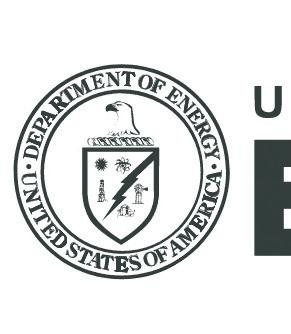
58 IMPACT 2023 STORY JEFF HOPPER AND MACK BURKE | PHOTOS PHIL SHOCKLEY
U.S. SECRETARY OF ENERGY ANNOUNCES CREATION OF GREAT PLAINS CENTER OF EXCELLENCE AT OSU

OSU CEAT 59
U.S. Secretary of Energy Jennifer M. Granholm visits the ENDEAVOR Lab to celebrate the launch of the Great Plains Center of Excellence at OSU.
technologies that are being used right here that caught our eye.
“And so today, I am proud to announce that we are awarding nearly $19 million to five universities who will host new IAC Centers of Excellence, including the Great Plains Center of Excellence right here at OSU.”
Of the combined $18.7 million in funding slated for the five new centers, the GPCoE has received a nearly $7 million funding award. That funding will directly impact the center’s ability to conduct industrial assessments aimed at helping clients reduce energy usage and increase productivity while educating the next generation of energy, waste and productivity professionals using next-generation, integrated tools and technologies, such as smartphone apps, drones and virtual/augmented reality.
The GPCoE also will focus on developing interactive learning environments for teaching, training and workforce development activities through an interactive virtual curriculum for IAC personnel, manufacturers and employees, and university and community college students.
The creation of the GPCoE will allow OSU to further its land-grant mission
to address society’s most pressing challenges through innovative, worldchanging research.
“As the largest university system in the state of Oklahoma, part of our land-grant mission is to be an economic growth engine and to deliver cutting edge research that benefits our state, our region and our nation,” OSU President Kayse Shrum said. “And this award for
the Great Plains Center of Excellence certainly supports our land-grant mission and will further propel our e orts to solve society’s most pressing challenges.”

Oklahoma Gov. Kevin Stitt, Sen. Tom Duggar, Rep. Trish Ranson and Dr. Hitesh Vora — OSU IAC director and principal investigator for the new center of excellence grant — were also on hand to celebrate the momentous announcement, which Stitt praised as another positive milestone for OSU and the state.
“Secretary, we’re so excited that you’re in Oklahoma and you’re investing in the state of Oklahoma,” he said. “We really appreciate your leadership on everything energy, and especially renewables and hydrogen. And congratulations to Oklahoma State University for this award.
“You know, Oklahoma has an all-ofthe-above energy approach. We’re so proud of our oil and gas industry. And what most people don’t realize is we’re also No. 2 in the country in wind energy, and we produce about 65% more energy than we consume. We’re a net exporter of that energy. And we’re one of only four states that over 40% of our energy comes from renewables. And that’s why Google’s largest data center is located
U.S. Secretary of Energy Jennifer M. Granholm speaks to students and faculty during her visit to campus to celebrate the launch of the new Great Plains Center of Excellence at OSU. Granholm was joined by Second Genteleman Doug Emho (center), OSU President Kayse Shrum and Oklahoma Gov. Kevin Stitt.
“... we are awarding nearly $19 million to five universities who will host new IAC Centers of Excellence, including the Great Plains Center of Excellence right here at OSU.”
60 IMPACT 2023
JENNIFER M. GRANHOLM, U.S. SECRETARY OF ENERGY
in the state of Oklahoma and a lot of companies are looking to Oklahoma because of our a ordable, reliable energy grid.”
Granholm followed Stitt’s remarks by highlighting the cooperative push behind the Bipartisan Infrastructure Law, which was enacted in 2021.
“This initiative, which is all about investing in America, is one piece of a grand strategy for us as a country to be able to get back the manufacturing jobs that we have lost over the past couple of decades,” she said. “And this is something that I know Democrats and Republicans can agree on — the importance of bringing back manufacturing in this country.”
The news conference followed a tour of OSU’s state-of-the-art ENDEAVOR lab, where Granholm and Emho got a firsthand look at the unique hands-on learning and research opportunities available to OSU students, even as undergraduates. The second gentleman — a noted college football fan — also enjoyed a brief meeting with OSU football coach Mike Gundy.
“Yes, I got the football from Coach Gundy, but that was a surprise,” Emho
said. “What was really not a surprise was to see the excellence here at Oklahoma State University; to see the passionate colleagues that you have, the students, the grad students, just to see the work that’s being done. You can see it. That’s what I love so much about this tour. … You can literally see the future in front of your eyes.”
One of those students is chemical engineering senior Tionne Fultz. She has worked in OSU’s IAC for the past two years, and the impact the center has had on her personal and professional growth has been immeasurable.
“Since the very first day I started at the IAC, Dr. Vora has always encouraged me to speak up in meetings with clients and has consistently asked for my unique opinion on how the program is run,” she said. “All the experience I’ve gained has helped me get internships and even a full-time position as an environmental engineer after I graduate. I can’t even begin to imagine where I would be had I not joined the IAC.”
After five years as IAC director, Vora couldn’t be more excited about the future. He said the Great Plains
FAST FACTS: INDUSTRIAL ASSESSMENT CENTER
• Since its official founding in 1979, the IAC has been responsible for nearly 1,100 assessments, accounting for $132 million in potential savings for its clients.
• The IAC’s clients are manufacturing companies, water and wastewater treatment plants, and, as of recently, commercial buildings.
• OSU’s Industrial Assessment Center’s current region of impact: Oklahoma, Kansas, Arkansas and part of North Texas.
• Through energy savings, the IAC program at OSU has helped to displace 1.91 million metric tons of carbon dioxide emissions from industrial sources in its four decades of service.

• IAC Alumni are hired almost twice as fast on average as their peers into an energy efficiency position.
• Many of IAC OSU alumni have been hired in companies such as Pepco Energy Services, EMCOR Group, Siemens, GE and more. Others have gone on to work overseas in countries including Russia, China and India. Some alumni have chosen to become educators at schools, such as OSU and University of Illinois Urbana-Champaign to pass on their knowledge.
From left: Dr. Chuck Bunting, Dr. Hitesh D. Vora, Will Gibson, Diwas Subedi, Abinash Kumar Gupta, Snehal Durugkar, John Smegal, Tionne Fultz, Rahul Nomula, Emma Cooley, Hemal Keerthipati Sumanth, Aditya Shete, Rep. Trish Ranson and Dr. Kenneth Sewell pose together following the launch announcement for the new Great Plains Center of Excellence at OSU.
OSU CEAT 61
FAST FACTS: GREAT PLAINS CENTER OF EXCELLENCE
• The IAC will continue its work while the new regional center of excellence expands OSU’s footprint to bolster other IACs across a 13-state region — Minnesota, North Dakota, South Dakota, Iowa, Missouri, Nebraska, Kansas, Oklahoma, Arkansas, Louisiana and areas within New Mexico, Colorado and Texas.
• Great Plains Center of Excellence (GPCoE) will serve as a regional hub for the Department of Energy and 12 Great Plains states, with seven states home to partnering IACs.
• The GPCoE’s main objective is to develop, deploy and test the next generation of integrated tools and technologies in the form of smartphone apps, drones, and virtual/augmented reality (VR/AR) to allow virtual/ remote data collection. It aims to produce competent, motivated energy engineers, provide resources and expertise to complement energy conservation technologies, equitably develop the clean energy workforce and form significant collaborations to improve regional industrial competitiveness.
• The new center — which will be housed within OSU’s Industrial Assessment Center in the College of Engineering, Architecture and Technology — is one of five competitively selected higher education institutions to serve as Centers of Excellence for DOE’s Industrial Assessment Centers Program.

• The new regional ‘Centers of Excellence’ will expand a Department of Energy program that works with employers to train clean energy workers and identify ways to reduce energy and save money.
Center of Excellence will expand OSU’s footprint and allow for rapid advancement of new technologies to be shared across the region in a way that meets the region’s specific needs. The region is predominantly rural in nature and encompasses vast numbers of census tracts designated as “disadvantaged communities.” The project design includes strategies for reaching manufacturers in those communities. Because of its central location in Oklahoma and its reach into northern Great Plains states, this project will have a substantial positive impact on Native American interests in the region.
“The needs on the East Coast and in the West are so much di erent than we have here in the middle of the country,” Vora said. “The Great Plains Center of Excellence will allow us to provide a customized solution to IACs all over the
region, providing new technology development and training so that they can work properly.”
The benefit for these centers and the industries the new Great Plains Center of Excellence will serve is immense. But Vora said the benefit to students is life-changing.
“The student is the ultimate winner of this,” he said. “At OSU, we teach them theory in class, but any manufacturing plant can serve as a lab. These students get hands-on experience working with real data, analyzing that data and communicating it to clients.”
Vora said the opportunity to “turn stone into gold” is what drives him.
“That’s why I’m here,” he said. “These students come here without any experience, and they leave with extremely valuable experience. It’s real life experience, and they’re making a real impact on the world, even as students.”
62 IMPACT 2023
Dr. Hitesh Vora speaks to U.S. Secretary of Energy Jennifer M. Granholm during a tour of the ENDEAVOR Lab. Vora is director of the OSU Industrial Assessment Center and served as principal investigator for the new center of excellence grant.
TOP HONORS
CEAT seniors recognized with awards


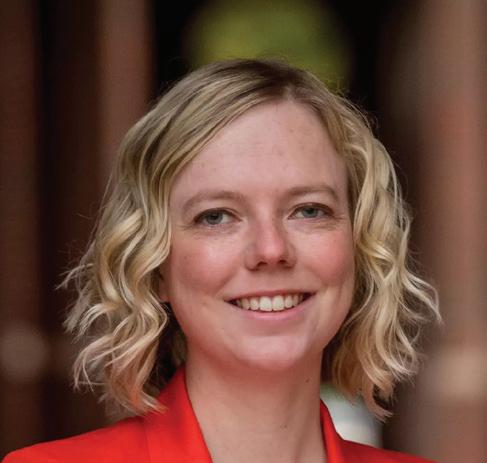


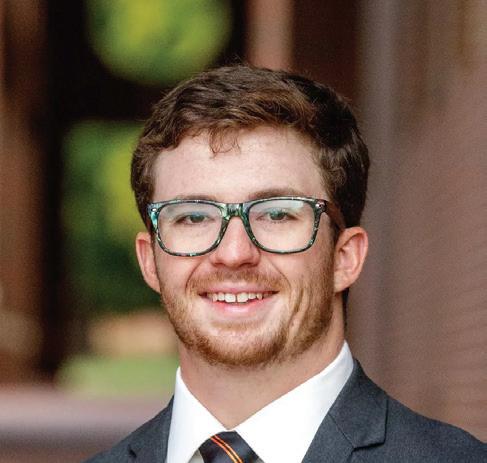
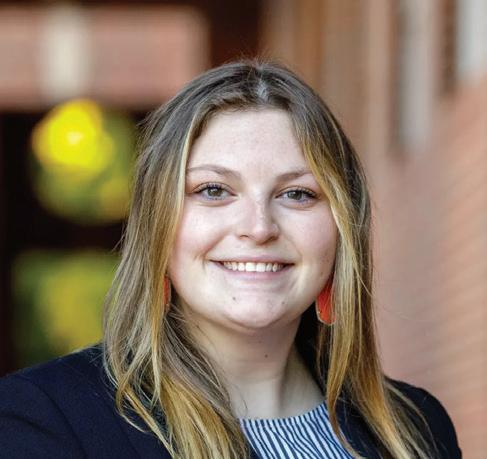



Ten College of Engineering, Architecture and Technology students were selected as Oklahoma State University Seniors of Significance for the 2022-23 academic year by the OSU Alumni Association. The Seniors of Significance Award recognizes students who have excelled in scholarship, leadership and service to campus and community and have brought distinction to OSU.
Six of them — Alexandria Bias, Rio Bonham, Keaton Marie Carter, Sloane Johnston, Emily Tran and Aubrey Wolf — were also named 2022-23 Outstanding Seniors by the OSU Alumni Association. The Outstanding Seniors award recognizes seniors who show excellence through academic achievement; campus and community involvement; academic, athletic or extracurricular honors or awards; scholarships; and work ethic during their time at OSU.
#STUDENT IS A MEMBER OF THE OSU ALUMNI ASSOCIATION
Rio Bonham Biosystems Engineering Madill, Oklahoma#
Emily Tran Architecture Carrollton, Texas
Sloane Johnston Civil Engineering Tulsa
Raegen Daigle Industrial Engineering and Management Owasso, Oklahoma
Emma Wilson Industrial Engineering and Management Houston
Aubrey Wolfe Chemical Engineering Tulsa
Alexandria Bias Chemical Engineering and Political Science Orlando, Florida#
Madison Neighbors Chemical Engineering Kellyville, Oklahoma
Keaton Marie Carter Industrial Engineering Stillwater
OSU CEAT 63
Karley White Chemical Engineering Mannford, Oklahoma#
2022
Hall of Fame
COLLEGE OF ENGINEERING, ARCHITECTURE AND TECHNOLOGY
DAVID BOYER
David Boyer grew up in Flora, Illinois, a small rural community in the southern part of the state.
In 1982, he graduated from the Tabor School of Business and Engineering at Millikin University in Decatur, Illinois. While he had no initial interest in attending graduate school, he reconsidered after his engineering professors arranged a meeting with OSU’s industrial engineering and management (IEM) faculty.
“This introduction occurred at an Institute of Industrial Engineering senior chapter meeting in Decatur, Illinois,” Boyer said. “At the time, I thought the meeting with Dr. [John] Nazemetz was an impromptu encounter; but years later, I learned that it was a planned meeting that professors [Jim] Gross and Nazemetz had secretly prearranged.”
In 1984, Boyer graduated from OSU with a Master of Science in IEM. Throughout his time at OSU, Boyer received guidance from many people around him. During his first semester, he married Sharon E. Boyer, whom he describes as his, “best friend and the love of his life.”
“Sharon has been and continues to be a pivotal influence in my life,” Boyer said. “By her enduring example, Sharon taught me that love is forever. Simply put, she is a very, very special person. And there has never been a better wife, mother or grandmother, aka Babi.”
Boyer has worked with Webco Industries since July of 1984. His 38 years of experience with the company have resulted in diverse and increasing levels of responsibility, and he now serves as the president, vice-chairman of the board and chief operating o cer.

Webco has grown and succeeded in significant ways during his tenure. Today, Webco is more than 20 times larger than it was four decades ago. Boyer is proud to have been a part of this exceptional growth.
Webco is a manufacturer and distributor of specialty metal tubular products, including precision welded tubing. It produces carbon, stainless steel, nickel,
titanium and other alloy tube products for a variety of applications. Webco is considered the most diverse, technologically sophisticated and fastest growing specialty metal tube mill in the United States.
“In some respects, I am not sure that I actually chose my career path; but rather, I think that my career path chose me,” Boyer said. “When I graduated from OSU, what I was looking for was ‘a job,’ but what I found at Webco was ‘a home.’ Webco was then and remains today, a vibrant and forever kind of company that focuses and builds on the strengths of its people. Webco is where people make the di erence, and Webco is a place that makes a di erence in the lives of its teammates — it certainly has made a significant impact in mine.”
Boyer is proud to have worked alongside many exceptional people at Webco; among them are the company’s founder, Bill Weber, and the company’s chief engineer, Bill Obermark.
“Mr. Weber was the most present and prescient person that I have ever known. From his wise counsel and inspiring example, I learned important and timeless things about life and business,” Boyer said. “I also owe a great debt of gratitude to Webco’s chief engineer, Mr. Bill Obermark. From Bill, I have learned what being an engineer is all about. These insights were gained from countless hours visiting Bill, often during our many Saturday lunches together. Bill is not only an exceptional engineer, he is also a magnificent mentor and friend.”
Boyer’s roles outside of work are being a husband, father and grandfather. He and Sharon have been married for nearly 40 years. The two of them have raised three daughters: Sarah, Erynn and Jenna; and have three sons-in-law: Josh, B.J. and Nate. They enjoy being active figures in the lives of their five grandchildren: Emma, Ben, Lane, Madison and Luke. When Boyer is o the clock, he can be found spending time with Sharon, at T-ball games, dance recitals, family dinners and conducting “Ice Monster” reenactments.
64 IMPACT 2023
JACK H. GRAHAM
Jack H. Graham is the owner of Graham and Associates Professional Consulting Engineers in Yukon, Oklahoma.
In 1959, he graduated from Oklahoma State University with a bachelor of science in electrical engineering. Graham entered engineering at a time of major advancement in aerospace technology and worked on numerous groundbreaking projects in the middle of the space race.

Graham was born on March 16, 1937, and raised on a dairy farm just outside of Oklahoma City as the youngest of four brothers. His oldest brother attended Oklahoma A&M and graduated with an electrical engineering degree after serving in World War II. Each of the brothers followed in his footsteps and all achieved at least a master’s degree, with Graham receiving a master’s in business administration.
Graham attended OSU while married with two children. He worked for the university’s physical plant as an electrician’s helper and finished his required 148 hours needed to complete a bachelor’s in electrical engineering in only 3 1/2 years.
After graduating, Graham worked for the Sperry Gyroscope Company in New York City, where he participated in the development of electronic countermeasures designed to render the B52 bomber invisible to Soviet radar systems.
After working for the Sperry Gyroscope Company for four years, the company sent Graham to Salt Lake City to work on a surface-to-surface missile system called Sergeant. The Sergeant was the first operational solid propellent, inertial guided missile system.
“I was involved in the Army acceptance and compliance testing performed at Aberdeen, Maryland and at Camp Hale in Colorado,” Graham said. “We also fired several missiles at White Sands Missile Range in New Mexico.”
After leaving the Sperry Gyroscope Company, Graham worked for Boeing at Red Stone Arsenal in
Huntsville, Alabama. While working with German rocket scientist Wernher von Braun, Graham contributed to the development of the first stage of the Saturn 5 rocket system that would later put a man on the moon.
Once the Saturn 5 system was running, Graham left Boeing to work for Ling-Temco-Vought in Grand Prairie, Texas. The project that company was focused on was creating a satellite system intended to shoot down Soviet intercontinental ballistic missiles. It didn’t work.
Having registered as a professional engineer during his time in Alabama, Graham moved back to Oklahoma City and began working for a mechanical and electrical engineering consulting firm. Graham bought this firm from its founders in 1974 and changed its name to Graham and Associates Professional Consulting Engineers.
Graham is a past president of the Oklahoma Society of Professional Engineers, a Fellow of the National Society of Professional Engineers, a benefactor of the CEAT Dean’s Club, a member of the Proud and Immortal Society, a Maxwellian Member of the School of Electrical and Computer Engineering (ECE), a member of the ECE Industrial Advisory Board and a sponsor of the Jack H. Graham Endowed Fellowship presently held by Professor John O’Hara in the School of Electrical and Computer Engineering.
Graham credits his success in engineering to his education.
“It was essential,” Graham said. “Everything I’ve done as a professional engineer was based on my education in the engineering department at OSU. I received as good, if not better, education than many of the engineers whom I worked with when I first joined Sperry. I’m very proud of the education I received at OSU. An engineering degree is an outstanding degree. It enables you to go out and, through technology, help build your society.”
OSU CEAT 65
CAROLYNE M. GOWDY HART
Carolyne M. Gowdy Hart was born in Memphis, Texas, in 1953. Six years later, her family moved to the farming and oil-producing community of Seminole, Texas, where Hart completed her primary and secondary education.
In 1975, Hart graduated from Howard Payne University in Brownwood, Texas, with her bachelor’s degree in mathematics and a minor in biology. Her HPU biology professor, Dr. Jack Stanford, was an OSU alumnus who encouraged her to apply for OSU’s summer National Science Foundation Undergraduate Research Participation Program, where she participated in the microbiology and electrical engineering (EE) programs.
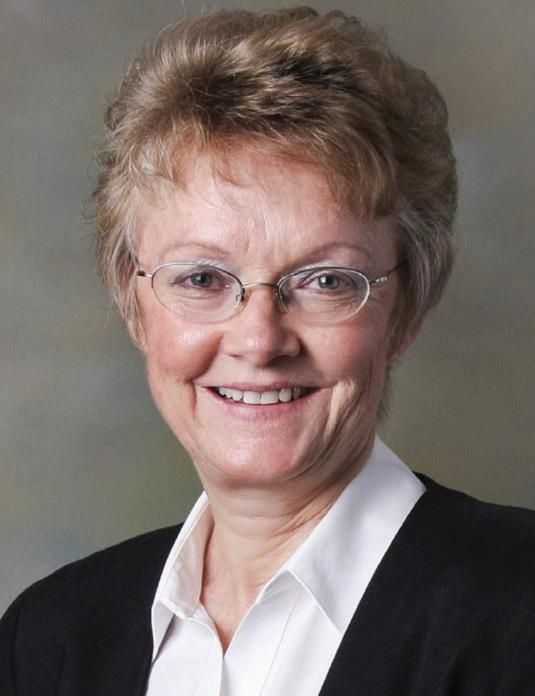
“I was able to attend both the microbiology and engineering summer seminars, but my research that summer was guided by Dr. Bob Mulholland from the OSU School of Electrical and Computer Engineering,” Hart said. “That summer experience was transformative for me.”
Hart graduated from OSU with a master’s degree in EE in 1976 and with her doctoral degree in EE in 1978. Hart’s favorite memory from the university was meeting and spending time with her future husband, Jay Hart.
After receiving her doctoral degree, Hart accepted a position at Sandia National Laboratories (SNL), a government-owned, company-operated federally funded research and development center. She started the position during the 1970s energy crisis, when the U.S. Department of Energy tasked SNL to apply its capabilities to solve urgent energy issues.
A second-level manager that remembered Hart’s academic background from her initial Sandia interview contacted her with an opportunity to lead the navigation, guidance and control team for the Sandia hypersonic testbed. The team developed and demonstrated terrain-following and landmark recognition navigation using real-time data from a small onboard synthetic aperture radar (SAR). Around 20 years later, that foundation of work was resurrected and informs today’s U.S. hypersonic systems.
As her management career progressed, Hart broadened her experiences and led teams to solve other national security problems, including leading Sandia’s innovative, nextgeneration Intelligence, Surveillance and Reconnaissance Synthetic Aperture Radar (ISR SAR) and aided target recognition systems contributions, which she considers to be a career highlight.
However, the final chapter of Hart’s career was what she considers the most challenging and fulfilling. She served as the vice president of weapons engineering and product realization and also as the chief engineer for nuclear weapons at SNL.
Hart has been recognized various times throughout her career. A few of her honors include being an inductee of the U.S. Air Force Order of the Nucleus, receiving a U.S. Joint Improvised Explosive Device Defeat Organization commendation for technical and programmatic leadership of the most successful airborne IED detection asset in Afghanistan, receiving the U.S. National Research Council Applied Research Award for the significant, original contribution to research in rock mechanics, being selected as a Distinguished Member of the Technical Sta , an honor limited to 10% of Sandia Laboratories’ technical sta , and many more.
Out of everyone in Hart’s life, she considers her mother to be the most influential. When her mother was 12, she was diagnosed with rubella, which caused blindness. However, she only took a year o of her education and was allowed to return to the local sighted school. She graduated with her class and as salutatorian. Her mother’s di erences, perseverance and determination taught Hart values that she will carry with her throughout everything she does.
“For me, being inducted into the OSU College of Engineering, Architecture and Technology Hall of Fame and receiving the Lohmann Medal are more about honoring her life, love and dreams than about honoring my own accomplishments,” Hart said.
PREVIOUS HALL OF FAME RECIPIENTS
1954 Laurence L. Dresser
1955 Gerald W. McCullough
1956 Richard K. Lane
1957 Thomas M. Lumly Jr.
1958 Guy H. James
1959 Francis J. Wilson
1960 Morrison B. Cunningham
1961 Lloyd E. Elkins
1962 Don McBride
1963 B. Harris Bateman
1964 William W. Caudill
1965 Myron A. Wright
1966 Edwin G. Malzahn
1967 Eugene L. Miller
1968 David G. Murray
1969 Melvin A. Ellsworth
1970 Veldo H. Brewer
1971 Ralph M. Ball
1972 Richard O. Newman
1973 David B. Benham
1974 Carl G. Herrington
1975 James J. Kelly
1975 Gus L. Maciula
1976 Donald E. Adams
1976 James C. Phelps
1976 Fred H. Ramseur Jr.
1977 John S. Zink
1978 Sidney E. Scisson
1979 John L. Hatheway
1979 Eason H. Leonard
66 IMPACT 2023
1979 Nicholas B. Mavris
1980 John B. Jones Jr.
1981 William J. Collins Jr.
1982 Floyd M. Bartlett
1982 Holmes H. McClure
1983 Bill N. Lacy
1983 George H. Lawrence
1984 Edward C. Joullian III
1984 Glenn E. Penisten
1985 Frank A. McPherson
JIM LANSFORD
Jim Lansford grew up on, what was originally, a homestead farm in Skyline, Alabama. He graduated from Auburn University in 1980 with his bachelor’s degree in electrical engineering and with his master’s degree from Georgia Tech in 1982. Lansford worked as a cooperative education student with the National Security Agency as his first engineering job. He continued working in defense-related jobs after receiving his bachelor’s and master’s degrees. After meeting Oklahoma State University professor Rao Yarlagadda, Lansford decided to leave the industry and pursue his doctorate.
OSU introduced Lansford to his best friend and wife of 35 years, Lynn Milburn Lansford. Not only did she attend OSU, but both of her parents worked as professors in the English department for over three decades.
Lansford considers meeting his wife and her family to be a favorite memory of OSU along with his experience teaching.
“I taught a junior-level class and really enjoyed it; teaching as a graduate student while at OSU made a wonderful experience even more special,” Lansford said. “It’s very gratifying to see students do well in their studies and go on to successful careers. I have continued teaching as an adjunct professor at the University of Colorado Boulder (CU), over the last 12 years, and love seeing what my students achieve after graduation!”
Lansford made his residence in Stillwater from 1985 to 1988. After graduating from OSU in 1988, Lansford worked at the Georgia Tech Research Institute studying advanced radar detection algorithms. In 1990, he left to begin teaching as an assistant professor at the University of Colorado at Colorado Springs. He eventually left the university and helped found a startup as a chief technology o cer (CTO) for Momentum Microsystems, which would start his 25-year journey working in standards and regulations for wireless communications.
In late 1996, Lansford was hired by Intel Corporation to be the technical lead for a new technology called HomeRF. HomeRF combined technology from cordless phones with wireless local area networks in new ways that helped shape aspects of Wi-Fi technology. Four years later, Lansford became the vice president and the CTO of Mobilian Corporation. During his time as CTO at Mobilian, he helped the company raise over $70 million in venture capital before its acquisition.
After the acquisition of Mobilian by Intel in 2003, Lansford was invited to be the CTO and one of the founders of Alereon, which was one of the leading startups developing ultra-wideband wireless technology. During his seven years as CTO of Alereon, he helped raise over $80 million in venture capital. In 2010, Lansford was hired by Cambridge Silicon Radio as the standards lead for their Wi-Fi technology e orts. The company was acquired by Qualcomm in 2015 and he has been with Qualcomm since the acquisition.
“As Bluetooth and Wi-Fi both started ramping up to billions of chips per year, a major problem loomed because they shared the same frequency band but were incompatible,” Lansford said. “I was able to take ideas for coexistence we had developed at Mobilian and get them adopted by the Institute of Electrical and Electronics Engineers (IEEE), and in turn that technology was adopted by the communications industry.”
This innovation was chosen by Microsoft as the most significant technology for computing platforms in 2001 at the Windows hardware engineering conference. Today, there are billions of phones and tablets that have this coexistence technology in them.
Lansford holds eight leadership positions in six di erent wireless standards organizations. He is the chair of the committee in IEEE that is the incubator for all new Wi-Fi technologies, an industry leader in ultra wideband communications and connected vehicle technology as well as the chief editor of the SAE standard that defines how cars communicate with each other to avoid collisions and hazards.

Over the past 12 years, Lansford has been using his career experience as a teaching opportunity for the students at CU. One piece of advice Lansford gives students before graduating is to show gratitude to those who have helped them along the way.
“I am grateful to many people for their influence on my life and career,” Lansford said. “My mother was a teacher and strongly stressed the value of education, as well as integrity and honesty. Beyond that, I have had several teachers that altered the course of my life and career.
“My wife, Lynn, has also been a huge influence; she is a passionate humanitarian and has taken on many projects to make the world a better place, so she invites me to look beyond the bubble of my engineering world to the larger issues of humanity.”
1986 James E. Barnes
1986 Martin E. Fate Jr.
1987 Raymond A. Porter
1987 James D. Cobb
1988 Choong-Shik Cho
1988 Robert M. Penn
1989 Wilfred P. Schmoe
1989 Neal A. McCaleb
1991 Jim E. Shamas
1991 J. Tinsley Oden
1991 David J. Tippeconnic
1992 W. Wayne Allen
1992 Robert M. Lawrence
1992 Wolter J. Fabrycky
1993 Jack P. Holman
1993 Keith E. Bailey
1993 Kenneth J. Richards
1994 Kerry S. Havner
1994 Donald R. Lehman
1995 Ted E. Davis
1995 D. Ray Booker
1995 Charles L. Hardt
1996 R. Gerald Bennett
1996 Marvin M. Johnson
1996 Jerry D. Homes
1997 H. E. Cobb Jr.
1997 J. N. Reddy
1997 Donald L. Wickens
1998 Ronald D. Wickens
1998 John E. Hershey
1999 Ronald L. Calsing
1999 John C. Mihm
1999 Heinz W. Schmitt
2000 Jim W. Bruza
2000 Sherman E. Smith
2000 Thomas W. Wallace
2000 Charles O. Heller
2001 B. N. Murali
2001 Duane Wilson
2001 Robert Braswell
OSU CEAT 67
LIEU R. SMITH
Lieu R. Smith grew up on a wheat farm 10 miles from Okeene, Oklahoma after moving from Michigan City, Indiana, during the Great Depression.
All eight grades were taught in the same classroom with one teacher for much of Smith’s grade school experience. As he entered high school, agriculture was one of the basic classes he was required to take each year.
Growing up in a rural area inspired him to major in agricultural engineering with an emphasis on soil and water conservation. He graduated from Oklahoma State University with his bachelor’s degree in agricultural engineering in 1954 and with his master’s degree in structural engineering in 1957. Smith also spent two years on active duty with the U.S. Army Corps of Engineers.

“My undergraduate time at OSU was a major time of adjustment from a small rural school background to a major university setting,” Smith said. “It permitted me to expand my horizons academically and socially as well as mature in my decision-making processes. My time at OSU, followed by going into the U.S. Army Corps of Engineers as a commissioned o cer, formed a core structure of who I was and the lifestyle principles that I stood for.”
Smith spent the majority of his engineering career working with the Sverdrup Corporation in St. Louis, where he eventually rose to become the rank of corporate vice-president of advanced technology. The corporation is now a part of Jacob’s Solutions Engineering Company. His engineering career started in the early 1960s working with Sverdrup on designing the large rocket test facilities at Stennis Space Center for the Saturn V Program, which ended up sending a man to the moon. This was only one of the well-recognized projects Smith was a part of. He worked on, managed and hosted projects like test facilities for a 300 mph tracked air cushion research vehicle, a 400-mile oil pipeline and marine terminal in the country of Algeria, liquid and solid-rocket engine test stands for the space shuttle, and a $240 million Space Shuttle Launch Pad Complex at Vandenberg, California, Air Force Base.
“The Space Shuttle Launch Pad Complex is the project that I am most proud of,” Smith said. “Because it was Air Force sponsored instead of NASA, with di erent missions, di erent payloads and operational requirements, it also presented new as well as constantly changing design requirements.”
Smith’s work as the project manager for the Space Shuttle Launch Pad Complex received numerous awards. On March 5, 1984, the project was featured in Time magazine and the launch pad complex was described as the “most sophisticated military complex ever built.” Smith’s project earned Sverdrup the 1985 Grand Conceptor Award for excellence in engineering by the American Consulting Engineers Council and the complex was recognized as one of 10 outstanding engineering achievements from the National Society of Professional Engineers.
In 1993, Smith retired to devote his time to working for his church as a self-sustaining ordained minister. He pastored the Berryville, Arkansas, Community of Christ for eight years and was awarded the status of pastor emeritus upon his retirement at the end of 2003. He continued to serve as a hospital chaplain and on a number of committees and boards at Mercy Hospital.
“I have always been mindful that I am in reality an Oklahoma farm boy who grew up on a very marginal farm during the Dust Bowl days,” Smith said. “Through the encouragement and help from a lot of very good people, I became very successful in my profession, thus it is my intent to give back to society by helping others.”
Smith has practiced helping others through many di erent professional and community activities. He has been actively involved in the “Loaves and Fishes Food Bank of the Ozarks” by designing and funding the construction of a new facility for the storage and distribution of food to the needy of Carroll County, Arkansas. He has also endowed a scholarship fund for female Native Americans to become doctors of osteopathic medicine through the OSU Center for Health Sciences.
Continuing to learn about new concepts and figuring out your strengths are two pieces of advice Smith recommends to all students in CEAT.
“Don’t be afraid to venture into new avenues of work that you are not familiar with,” Smith said. “Rockets and spaceships were not even part of our vocabulary when I was in school. Secondly, discover what your best talents are and work to maximize them in your work. I found that mine was being able to organize projects and bring them to a successful conclusion.”
2002 Donald W. Vanlandingham
2002 Frank W. Chitwood
2002 H. Edward Roberts
2003 Jim B. Surjaatmadja
2003 James R. Holland Jr.
2003 Kent E. Patterson
2004 J. D. “Denny” Carreker Jr.
2004 Steven D. Hofener
2004 David Kyle
2004 Eddie M. Jones
2004 Neal E. Jones
2005 James Brooks Cummins
2005 Gordon E. Eubanks Jr.
2005 Behrokh Khoshnevis
2006 Sanjiv Sidhu
2006 James L. Vining
2006 Jack B. ReVelle
2006 Gary A. Pope
2007 Rand Elliott
2007 Michael Damore
2007 Leslie Priebe
2008 Ronald L. Ho man
2008 Donald D. Humphreys
2008 Samir A. Lawrence
2008 Ronnie Morgan
2009 Charles Kridler
2009 Meemong Lee
2009 A. Joe Mitchell Jr.
2009 Sridhar Mitta
2009 Richard Weidner
2010 Ray O. Johnson
2010 Jerry Banks
2010 Juan Carlos Calderon
2011 Je rey Fisher
2011 Lakshmaiah Ponnala
2011 Enos Stover
2011 Paul Liao
2012 Wilson Sho ner
2012 Calvin Vogt
2012 Jerry Winchester
2012 Cassie Mitchell
2013 Kenneth E. Case
2013 Harvey B. Manbeck
2013 Rixio Medina
2013 Robert Schaefer
68 IMPACT 2023
2013 Rick Webb
2014 Debbie Adams
2014 Alan Brunacini
2014 Harold Courson
2014 Decker Dawson
2014 Johann Demmel
2014 Je Hume
2014 David Timberlake
2014 Janet Weiss
ROBERT W. THOMPSON
Robert W. Thompson graduated from Oklahoma State University with his bachelor’s degree in civil engineering in 1962 and his master’s degree in 1965. Before transferring to OSU, Thompson started as a mining engineering student at the Colorado School of Mines. Between his sophomore and junior years, he worked underground and at the surface of the Climax mine in Colorado. This experience influenced his decision to switch his major to civil engineering and transfer to OSU.
While at OSU, Thompson was a member of Pi Kappa Alpha. He met his wife, Lynda J. Fulton, at a fraternity and sorority exchange dinner. She was the president of Alpha Chi Omega, Mortar Board and active on campus as an undergraduate. They were married shortly after graduation.
“My wife certainly had the most influence on my life and career,” Thompson said. “She graduated in 1962 and did some graduate work at OSU while I completed my master’s degree. She helped when I started my own business and was a great partner until she died in 2020.”
Thompson spent his first two years after graduation working as a structural design engineer with Ketchum, Konkel, Ryan and Fleming of Denver before becoming an assistant project engineer on the Chena Hot Springs Highway project in Fairbanks, Alaska.
He worked for Woodward-Clyde-Sherard and Associates for two years following the completion of his master’s program and then Chen and Associates for four years. Thompson founded his own geotechnical engineering firm in March of 1971, marking the beginning of the rest of his career.
“I was fortunate to have excellent, well respected mentors in the years prior to starting my own firm,” Thompson said.
CTL/Thompson Inc. currently has 280 employees, eight o ce locations and over 100,000 projects completed. When Thompson first established the firm, he was supervising a sta of 20-30 engineers and technical support personnel. At the time, the firm was known as Robert W. Thompson, Inc. Commercial Testing Laboratories (CTL) was acquired in early 1977 and the combined firm was named CTL/ Thompson.
From 1977 to 1995, Thompson served as the president and CEO of the firm, making him responsible for overall corporate financial management. The company’s primary technical areas of interest were soil- structure interaction, expansive soils, collapsing soils and evaluation of soil or foundation-related failures.
Some of the major projects the company has been involved in include the 110-mile railway line laid from Gillette
to Douglass in Wyoming for the development of the Power River Basin coal fields.
The firm was retained to do the initial investigation for the foundation of the terminal building and to provide the pavement design for all of the pavements adjacent to the concourses and taxiways of Denver International Airport (DIA). This design was the basis for all runway pavements at DIA. CTL/Thompson was the quality assurance contractor during the construction of DIA.
“My firm has been a leader in bringing the use of soil suction measurements into practice in the front range area of Colorado,” Thompson said. “I became aware of test methods for measurement of soil suction through Dr. Donald Snethen at OSU while I was on the Board of Visitors for Civil Engineering.”
The o ces expanded from Denver to Colorado Springs, Glenwood Springs and Fort Collins, Colorado from 1995 to 2000. Commercial Testing Laboratories were also located in Denver and Patton Burke and Thompson LLC in Dallas. During this expansion, Thompson’s role in the company was chairman of the board and CEO. The combined companies provide geotechnical, materials and geo-environmental engineering services.
Thompson became the senior principal and chairman of CTL Thompson, Inc. in 2000. He continued his interest in developing testing and analytical procedures for expansive soils as well as participating in local and national groups representing geotechnical engineers. In 2003, Thompson started working part time in his service as a senior engineer after 2005 until 2015.
Throughout his career, Thompson has been active in a wide variety of publications for the American Society of Civil Engineers (ASCE), served as the president of the Association of Soils and Foundations Engineers, and received the 2017 Colorado Legacy Award as well as many more accomplishments.

He has two pieces of advice for all current CEAT students before they enter their career paths.
“First, learn skills in public speaking and presentations,” Thompson said. “You will be required to present to planning commissions, building code o cials, clients, professional groups and many others. Second, focus on learning the fundamentals as an undergraduate. There will be considerable new knowledge and change over the course of your career. Good fundamental knowledge will help you evaluate the changes. Lifelong learning must be anticipated.”
2015 Jack Corgan
2015 Shrikant Joshi
2015 Ed Stokes
2015 Rao Surampalli
2016 Mark Brewer
2016 Ann Oglesby
2017 Legand Burge Jr.
2017 Jack Goertz
2017 John Klopp
2017 Gary Ridley
2017 Eric Woodroof
2018 Ali Fazel
2018 Brian C. Price
2018 Edward L. Shreve
2019 Jim Hasenbeck
2019 Rick Muncrief
2019 Charles Reimer
2019 Lyndon Taylor
2020 Mark Sutton
2020 Tom Britton
2020 Huan Nguyen
2020 Steve Searcy
2021 Stan Stephenson
2021 Matt Perry
2021 Christine Altendorf
2021 Carrie Johnson
2021 Leland Blank
2022 Bob Thompson
2022 Carolyne Hart
2022 Dave Boyer
2022 Jack Graham
2022 Jim Lansford
2022 Lieu Smith
OSU CEAT 69
COLLEGE OF ENGINEERING, ARCHITECTURE & TECHOLOGY
LOYAL AND TRUE DONORS OF CEAT
Debbie & Charlie Adams, CHE
Judith Allen
Rebecca & Joe Alvarez, CIVE
Whitney & Caleb Bates, ENGR TECH
Suzanne & Mohd Bilbeisi, ARCH, ARCH
Vickie & Ed Cannon, ECEN
Cecil Culver, CHE
Delores & Jerry Etter
Sue Fender
Amy & Je ery Ferguson, MAE
Christie & Ronald Gantz, CHE
Janet & Brad Gaskins
Carolyn & H. Earl Glimp, ECEN
Kim & Michael Gri n
Charlotte & Gordy Guest
Carolyn Harris
Roger Harrod, ENGR TECH
Dena & Ken Hirshey
Denay & Dwayne
Huddleston, ENGR TECH, IEM
Linda & Larry Kester
Annabelle & Kim Kimball, ECEN
Valda & Randy Kreie, ARCH
Betty Kron
Patti & Bill Lundeen, ARCH
Georgann & Neal McCaleb, CIVE
Charlotte & Keith Montgomery, CHE
John Mudd
Ann & Bill Oglesby, CHE
Jim Penn, CIVE
Gene & Robin Purdie-Smith
Isabella & Charles Reimer, ECEN
Carla Rickerd
Janet & Tony Sam, ENGR TECH
Jane & Michael Sigmon, ECEN
Mindy & Bill Silk, ARCH
Sue Tandy
Nancy & Mike Tate, CIVE
Jane & Bill Travis, MAE
Cherrie & Jim Turner, ARCH
Sharon Voskuhl & Alan Staab, MAE
Janet & Troy Weiss, CHE, CHE
Jan Womack
Wolf & Sandy Yeigh, IEM
Jamie & Darton Zink
Boeing Company
DCP Midstream LP
Google
Gordon and Betty Moore Foundation
Martin Family Foundation
McMahon Foundation
ONEOK
Phillips 66
Pratt & Whitney
Rockwell International
Tides Foundation/Google
United Technologies
Verily Life Sciences LLC
Paige Anderson
Otto Behunin, IEM
Kathy & Larry Blake, CHE
Donna & Shay Braun, IEM
Lora & Neal Buck, IEM
Mallory & Price Buckley, ARCH, MAE
Renee & Jerry Condu , ARCH, ARCH
Mike & Anita Dossey, CHE
Susan & Jack Goertz, IEM
Kelly & Carey Harris, CIVE
Bari & Kent Hatheway, MAE
Kerry Havner, CIVE
Judy Ho man
Dawn & Steve Huckaby, MAE
Francee & Je Hume, ENGR TECH
Joan Hwang
Barbara & Bill Johnson, ENGR TECH
Cheryl & Jim Lefler, ENGR TECH
Sterling Little, ARCH
Fish & Thom Maciula
Toni Melton
Mona & Bob Milam, CIVE
Diana & Ron Orr, IEM
Shirley Pappe
Karen & Joe Plummer, CHE
Sheryl & Kent Powers, IEM
Brenda & Brian price, CHE
Mary & Don Pruitt, MAE
Kamalakar Rao, MAE
Harold Smith, MAE
Kevin Snowden, MAE
Lee Sudan, ECEN
Sarah & Dave Timberlake, ARCH
Marcia Tuttle
Sherri Voelkel
Carol White
Neal Willison
Kerri & Gary Wilson, CHE
Mary & Brent Wooten, CIVE
Stacie & Derek Wrobbel, IEM, ECEN
AISC Education Foundation
Alpha Consulting Engineers Inc
American Institute of Steel Construction
Bell Helicopter
Community Foundation
CEAT Student Council
Charles B Goddard Foundation
Chevron Corporation
Chevron Phillips Chemical Company LP
Chickasaw Nation
ConocoPhillips
CyberGrants LLC
ExxonMobil
Halliburton
Ingevity
Marathon Petroleum Corporation
MEGASLAB
National Council of Examiners for Engineering & Surveying
National Fire Protection Association
National Math & Science Initiative Inc
Shell Oil
Textron Aviation
Textron Inc
The Haskell Company
XTO Energy
XTO Energy Inc
Diann & Greg Adams, ENGR TECH
Judy & Gary Allen, ENGR TECH
Rhona & Walter Allen, MAE
Arvind & Hema Amin, MAE
Dean Anderson
Paige Anderson
Elsa & Syam Antony, IEM
Kevin Bailey
Sherrlyn & David Bardwell
Maureen & Ken Barrett, MAE
Terrence & Julia Beaumariage, IEM
Otto Behunin, IEM
Ken Bell
Frank Berry, ENGR TECH
Melanie & Dan Blakely, ENGR TECH
Lauren & Ed Bond
Brady Born
Johnnie Boyle, MAE
Suzanne & Dallas Branch, ARCH, ARCH
Shirley & Arthur Breipohl
Mark & Beth Brewer, ECEN
Debbie & Tom Britton, MAE
Judy & John Brown, CIVE
Kristi Bumpas, CIVE
Laura & Blaine Bunch, ECEN
Kristie & Tony Buratti, MAE, MAE
Richard Bush, IEM
Anthony Byers, MAE
Mabel & Paul Caldwell, MAE
Billie & Frank Chambers
Sue & Frank Champion
Hong-Ju & Pei Chang, CHE
Cli Clottey, CIVE
Sam & Rita Combs, IEM
Ashley & Ardist Conner, CHE
Linda & Bill Cook, ECEN
Janell & Ken Cooper, MAE
Lerri & Rick Cooper
Terri Cooper
Kathy & Ken Corbin, ARCH
Jack & Carol Corgan
Berlyn Cota
Katherine & Kenneth Cox
Diane & Wiley Cox
Michael Crowley
Cynthia & Matthew Cullum, MAE
Joshua Cunningham, MAE
Sharon & Mike Damore, ARCH
Susan & Joe Davis, CIVE, CIVE
B.J. & Cary DeHart, ENGR TECH
Julie & Weston DeHart, ENGR TECH
Erin & Chris DeMoss, ENGR TECH
Jo Ann Devries
Lee Ann & Mark Dickerson, CHE
Aubree Diebolt, ARCH
Pat & Leo Dooley
Lindi & Blaine Douglas, ENGR TECH
Liz & Brad Dunbar, ENGR TECH
Sharon & Ray Earley, ECEN
Brenda & John Eaton
Karen & Franklin Eckhart, MAE
Kevin Eckhart
Brian Eckhart
Scot Eckhart
Jeanette & Rand Elliott, ARCH
Laura & David Eudey, MAE
Susan & Dan Evans
Ming & Gerard Fehrenbach
Wanda & Howard Flanders, CIVE
Stephen & Jane Ford, ARCH
Laura & Gregory Ford, CHE
Paul & Jane Fortin, ECEN
Jacque Fowler
Sandy & Darrel Fry, MAE
Barney Ghiglieri, CHE
Amy & Jason Gibson, ARCH, ARCH
Briar & Patrick Glenn, ARCH, ARCH
Kristin Gonders
April & Bill Graif, ENGR TECH
Kim & Al Griggs, MAE
JJ & Craig Grilliette
Leticia & Frank Groenteman, IEM
Nancy & John Groh, MAE
Christine & Greg Guckian
Jennifer & Fred Gutierrez, MSE
Tamara & Anthony Haas, CIVE
Cara & Michael Hair, MAE
Vickie & Joe Hall, CIVE
Syed & Zeba Hamid, MAE
Marla & Fred Hampton, CHE
Mike & Patricia Harris, MAE
Virginia & Jim Hart, ARCH
Belinda & Jim Hasenbeck, ARCH
Charlie Heller, CIVE
Paula & Dave Heller, ENGR TECH
Jack Hensley, ENGR TECH
Martin Hepp
Diane & Glen Hicks, MAE
David Hieronymus, CHE
Tammy & Fred Hill, ENGR TECH, ENGR TECH
Katherine & Billy Hinton, ARCH
Sherryl & Steve Hofener, CIVE
Jennifer & Eric Ho man, ARCH
Dennis Hussey, CHE
Janet & Terry Ingle, ENGR TECH
Carrie Johnson, ARCH
Camille & William Johnston
Barbara & Lucien Jones
Teri & Kevin Jones, CHE
Angela Kana-Veydovec, CIVE
Dale & Yvonne Keairns, CHE
Stuart Keeton, IEM
70 IMPACT 2023
Zachary Kelch, IEM
Sharon & Mark Kelley, MAE
Tammy & Matt Ketchum, ENGR TECH
Vicki & Steve Kiester, IEM
Gay & Ed Kirby
Joyce & Roger Kirk, ENGR TECH
Marty Kollmeyer, CHE
Bonnie & Bill Kurtz, MAE
Sharon & John Larson, ECEN
Carolyn & John Lawrence, CHE
Russell & Sherry Lawson, ECEN
Amanda & David Lee, ECEN
Callie Lee-Petricek
Laura & Don Lehman, CHE
Renee & Stan Lingo, ARCH
Yuan Yue & Duoying Liu, ECEN
John & Ruth Lloyd
Logen & Jayanthi Logendran, IEM
Nancy Long
Jill Long, CHE
Dick & Anne Lowery, MAE
Shane Lupi, ENGR TECH
Hui Min & Ko Makabe, ARCH, ARCH
Chris Marquart
Mark Marston, CHE
Gary & Karen Martin, MAE
Linda & Phil McCurdy, ARCH
Connie & Mark McFarland, ARCH
Trish & John Meek, ARCH
Bernadine & Kurt Metzinger, MAE
John Middleton, CHE
Gale & Robin Mills
Charlotte & Keith Montgomery, CHE
Martha & Gregory Mooney, CIVE
Laura & Jose Moreno, MAE
Maria & Alejandro Moronta, IEM
Carol & Frank Morsani
Diane & Jerry Mounts, MAE
Nidamaluri Nagesh, CIVE
Huan Nguyen, ECEN
Gary & Jana Oberlander, CIVE
Janice Oberlander
Colette & Kevin O’Brien, MAE
Diane & John O utt, ENGR TECH
Phyllis & Steven O’Hara, ARCH
Kathleen & Steven Oltmanns, ECEN
Megan & Aaron Owen, ENGR TECH
Jody Parker
Craig Parker
Anna & Randy Parks, ARCH
Gayla & Phu Phan, ECEN
Susie & Bill Phelps, MAE
Jeanne & Joe Phillips, MAE
James Pickel
Gary & Joan Pope, CHE
Kerri & David Powell, ARCH
Brenda & Brian Price, CHE
Margaret Price
Randy Randall, ECEN
Kathleen & Dan Rao, IEM
Bette & Evans Rector
Jean & John Richardson, CIVE
Eula Ridley
John Roads, ENGR TECH
Ryan & Julie Roberts, ARCH
Kathleen & Francis Rooney
Craig Rose, ENGR TECH
Raina & Tom Rose Tagle
Teresa & Warren Ross
Katherine & Neil Ryan, ENGR TECH
Eric Schiess, ENGR TECH
Charles Schwarz
Mandy & Bill Seider, ARCH
Jayne & James Selman, IEM
Brenda & Casey Shumate, IEM
Mark Shutt, ECEN
Susan Carol & Thomas Small, ARCH
Doug Smola, MAE
Barbara Snoddy
James Snyder, CHE
Barry & Christine Steichen
Tangye & Kevin Stephney, ECEN
Claudia & Ed Stokes, CIVE
Trina & Bradley Stover, CHE
Nancy & Al Strecker, ECEN
Je rey Szcinski, ECEN
Walter Taylor
Phil & Ruth Terry, MAE
Bob Thompson, CIVE
Vicki & Robert Thompson
Vinay Thottunkal
Carolyn & Charles Tobin, IEM, IEM
David Tosetto, ENGR TECH
Cal Vogt, ECEN
Leesha & Eric Vogt, ARCH
Steve Waken, ECEN
Susie & Tom Wallace, ARCH
Kai & Dave Wang, MAE
Debbie & Cary Watson, ECEN
Van Weathers, IEM
Mee Mong & Richard Weidner,
ECEN, ECEN
Ronald White, CIVE
Doug & Barbara White, IEM
Yvonne & Charles Williams, ECEN
Ruth Ann Willsey
Rene’ & Ray Witten, ENGR TECH
Nathaniel Woody, MAE
Bill & Sue Wylie, ECEN
Katherine & Keith Yancey, ARCH, ARCH
Donna & Bob Zahl, ARCH
Zoanne & Bob Zapata
Abbott Animal Health
Abbott Fund
Abbott IPCO Inc
Abbott Labs
Access Midstream
Acme Brick Company/Fort Worth
Acme Brick Company/Oklahoma City
Action Safety Supply Company
Ad Astra Foundation
ADG Blatt Architects
Advanced Workzone Services
AGC of Oklahoma Education Foundation
AIA Oklahoma
Allen Contracting Inc
Alston Construction
American Society of Professional
Estimators/Landrun Chapter 80
Andres Construction Services LLC
ANSYS Inc
Apple Inc
ARCO Construction
Austin Commercial LP
Balfour Beatty Construction
Benchmark Construction Engineering & Inspection
Bronco Drilling Company Inc
Burns & McDonnell Engineering Co Inc
C R Crawford Construction
Caddell Construction
CAF America
Canaan Energy Corp
Cantera Concrete Company
Carolyn Watson Rural Oklahoma CEC
Chesapeake Energy
CORD Construction
Credera Enterprises Company LLC
Crimson Steel Supply
Crossland Construction Company Inc
Cummins Construction Company Inc
Dell Inc
Deloitte
Deloitte Partners/Directors/Employees
Dewberry
Dolese Bros Co
DPR Construction
Edison International Company Enterprise Products Operating LLC
EST Inc
Flatiron Corp
Flintco Inc
Foundation for Engineering at OSU
Frankfurt Short Bruza & Associates PC
Frontier Bridge Inc
Garney Holding Company
Garver
Haskell Lemon Construction Co
HollyFrontier Sinclair
Home Depot
Home Depot Foundation
I. A. Naman + Associates Inc
i.e. Smart Systems
International Chemical Company
International Paper
International PaperCo Foundation
Kiewit Corporation
Kiewit Infrastructure South Co.
Kiewit Technology Group
Kiewit Texas Construction LP
Kirby-Smith Machinery Inc
Lemon Family Foundation
Lithko Contracting LLC
Lockheed Martin
MacArthur Associated Consultants LLC
Manhattan Road & Bridge
Mid-Continental Restoration Co Inc
Miratech Corp
National Association of Pipe Fabricators
Nike Inc
NW Central PipelineCorp
OK Natural Gas Company/Oklahoma City
OKC Community Fndn/CEC Corporation Fund
OKC Community Foundation
Oklahoma City Section
Olsson
Origin Materials
Overland Corporation
Ovintiv Cares (USA) Foundation
Ovintiv Inc
Paccar Inc
Patterhn Ives LLC
Peterbilt
PLW Waterworks LLC
Rhodes Hieronymus Jones
Tucker & Gable
RJN Foundation
Roger L & Aileen S Bell Trust
Schlumberger Foundation Inc
Scholarship Foundation/Lockheed
Martin
Smith Roberts Baldischwiler LLC
Society of American Military Engineers/OKC Post
Society of Fire Protection Engineers/ Michigan Chapter
Southern Company Services Inc
SpawGlass Contractors Inc
Studs Unlimited LLC
Texas Instruments
Textron Matching Gift Program
Tra c Engineering Consultants, Inc
University of Tulsa
Valero Energy Foundation
Valero Services Inc
Walsh Construction
White Engineering Associates Inc
Whitetail Properties
Williams Thank
you to all of our generous donors! OSU CEAT 71

































































$35,200 $2,127 $1,000 $15,000 $23,300 $15,500 $33,000 $6,000 $7,000 $13,750 $351,529 $29,240 $796,003 $2,203,319 $4,400 $26,004 $3,000 $41,000 $105,000 72 IMPACT 2023
$2,000 &10,000

$23,734





















Your donations allow us to become a 21st century hub of innovation and impact. As a donor, your gift represents the pinnacle of private annual support to CEAT and demonstrates your passion for higher education, students and OSU While we have accomplished much in the past years, our ambitions continue to grow and we need your continued support.

I would like to invite YOU to become a Dean’s Club member.


















The CEAT Dean’s Club is a distinguished group whose annual gifts of $1,500 or more annually to either the CEAT Designated Endowment Program Fund or the Scholar Program Fund , support our college’s top priorities and ensure a bright future for CEAT students. As a member, you will receive a number of exclusive benefits and privileges.


$1,500 $1,050 000 50 $7,000 $3,220 $1,000 $2,000 $32,500 $15,586 $5,000
It’s because of donors like you, near and far, that our students graduate as leaders, innovators, and as America’s Brightest! OSU CEAT 73
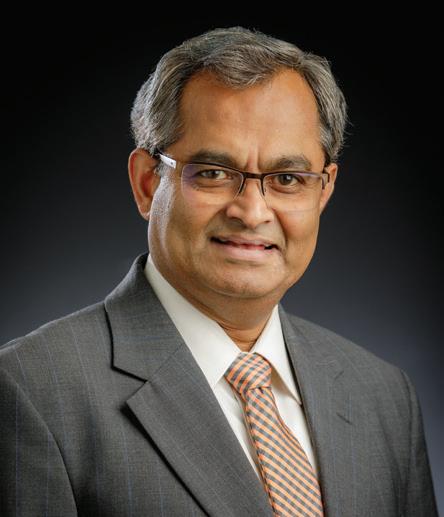
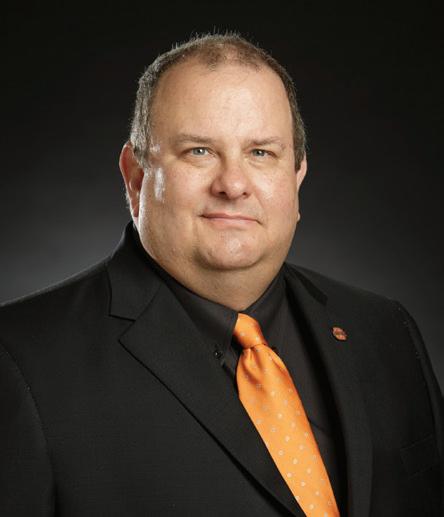

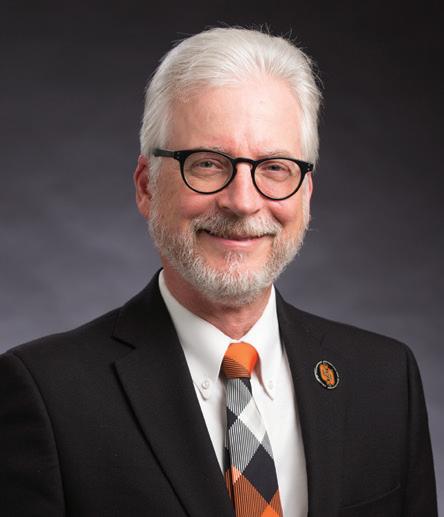







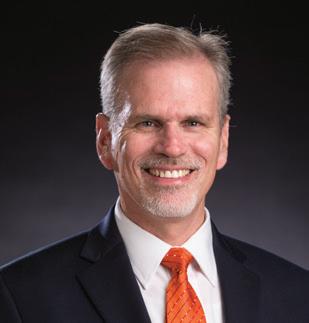
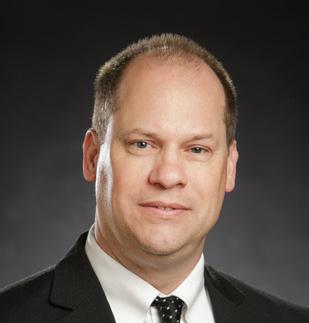

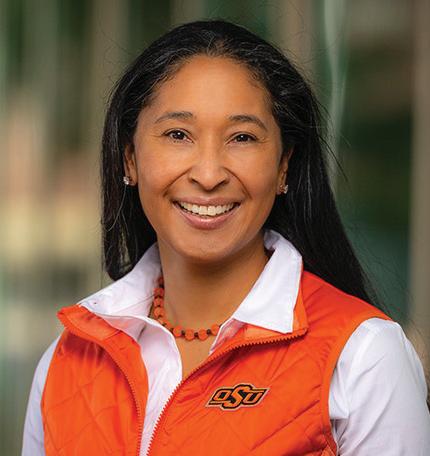 Dr. Ed Kirtley Associate Dean, Engineering Extension
Dr. Norb Delatte, P.E., F.ACI, F.ASCE Professor and Head
M.R. Lohmann Endowed Civil and Environmental Engineering
Dr. Guiping Hu Professor and Head Donald and Cathey Humphreys Chair Industrial Engineering and Management
Dr. Heather Fahlenkamp Professor and Head Anadarko Petroleum Chair Chemical Engineering
Dr. Sandip Harimkar Professor and Head Albert H. Nelson Jr. Chair Mechanical and Aerospace Engineering
Dr. James Smay Professor and Head Materials Science and Engineering
Dr. Je rey L. Young, P.E., F.IEEE Professor and Head OSURF Endowed Chair of Engineering Electrical and Computer Engineering
Dr. John Veenstra College Interim Dean
Dr. Sunderesh Heragu Associate Dean, Academic A airs
Dr. Raman Singh Associate Dean of Engineering, OSU-Tulsa Director, Helmerich Research Center
Dr. Chuck Bunting Associate Dean, Research
Dr. Ed Kirtley Associate Dean, Engineering Extension
Dr. Norb Delatte, P.E., F.ACI, F.ASCE Professor and Head
M.R. Lohmann Endowed Civil and Environmental Engineering
Dr. Guiping Hu Professor and Head Donald and Cathey Humphreys Chair Industrial Engineering and Management
Dr. Heather Fahlenkamp Professor and Head Anadarko Petroleum Chair Chemical Engineering
Dr. Sandip Harimkar Professor and Head Albert H. Nelson Jr. Chair Mechanical and Aerospace Engineering
Dr. James Smay Professor and Head Materials Science and Engineering
Dr. Je rey L. Young, P.E., F.IEEE Professor and Head OSURF Endowed Chair of Engineering Electrical and Computer Engineering
Dr. John Veenstra College Interim Dean
Dr. Sunderesh Heragu Associate Dean, Academic A airs
Dr. Raman Singh Associate Dean of Engineering, OSU-Tulsa Director, Helmerich Research Center
Dr. Chuck Bunting Associate Dean, Research
COLLEGE LEADERSHIP
Carisa Ramming Assistant Dean of Engagement and Inclusion, Academic A airs
John Phillips, PE Professor and Interim Head School of Architecture
Dr. Chulho Yang, Ph.D., PE Professor and Interim Head Engineering Technology
74 IMPACT 2023
Dr. Mari S. Chinn Professor and Head Associate Director, Sun Grant Program-South Central Region Biosystems and Agricultural Engineering
A Message from the Foundation
The OSU Foundation’s mission is to “unite donor passions with university priorities to elevate the impact of Oklahoma State University.”
As a development team who works with the dean and academic leaders, we strive to identify CEAT priorities and unite them with your passions to achieve excellence. Excellence can be defined in a variety of ways and take on a variety of forms.
Sometimes excellence is the firstgeneration CEAT student earning their degree, a faculty member making groundbreaking research in the lab, or students gaining hands-on experience while learning to work as a team through their senior design projects. With the current economic challenges facing higher education, private support plays a significant role in allowing the college to truly achieve excellence.
Whatever your passion is for helping us achieve excellence, it is our hope that you, our alumni, and friends of this great college, realize the role we play in bridging the aspirations of both parties.
Bryce Killingsworth
Senior Director of Development/Team Lead, CEAT
405.385.5623
bkillingsworth@osugiving.com
Jill Johnson
Senior Director of Development
405.385.0733
jjohnson@osugiving.com
Rachel Faruque
Director of Development
405-385-0747
rfaruque@osugiving.com
LaRonna Wilbourn
Constituent Relations Associate
405.385.5618
lwilbourn@osugiving.com
Kaid Kinzie Development Coordinator
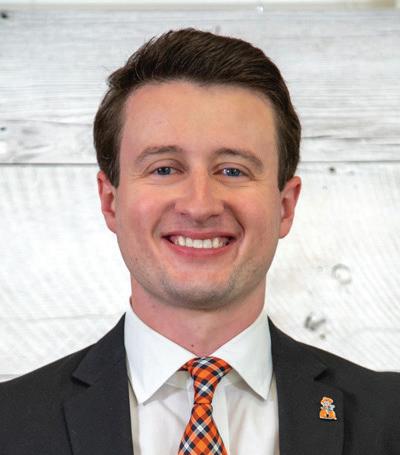
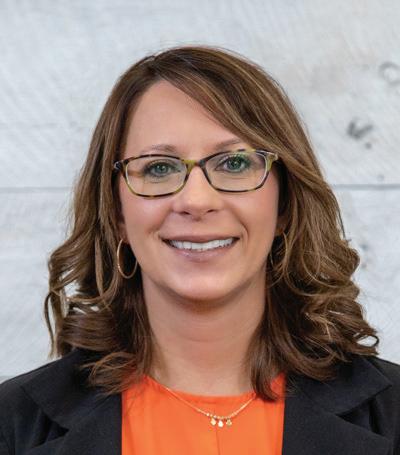
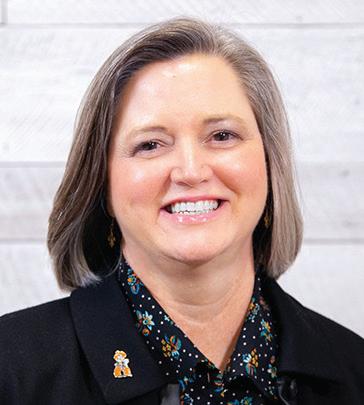
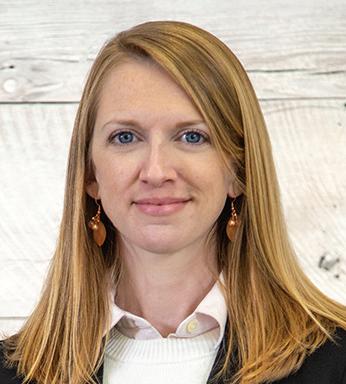

405-385-0972
kkinzie@osugiving.com
SUPPORTING CEAT
OSU CEAT 75
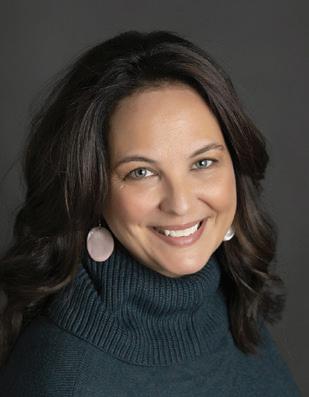
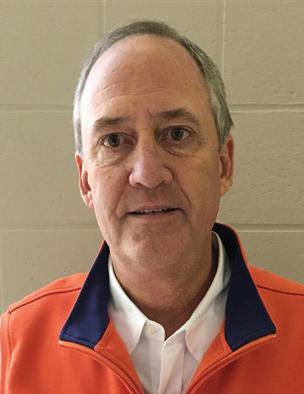
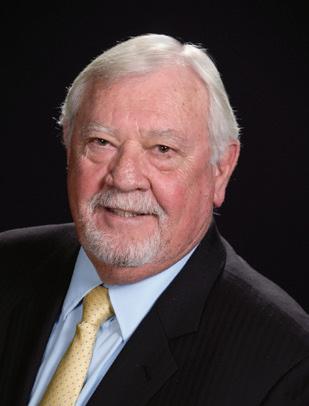








 Gregg Bradshaw Construction Manager
Joe D. Hall General Contractors LLC
Cara Cowan Watts Chief Executive O cer Tulsa Drilling
Garen Ewbank President Ewbank Geo Testing
Steve Huckaby Chairman and Chief Executive O cer Meritage Midstream
Je Hume Vice Chairman of Strategic Growth Initiatives Continental Resources Inc.
Shay Braun President Select Milk Producers
Heath DePriest Vice President of Emerging Energy Phillips 66
Jim Hasenbeck Principal Architect Studio Architecture
Denay Huddleston Director, Batteries and Solar Phillips 66
Chris Humes Sr. Vice President, Operations and Engineering TC Energy
Je Fisher Chief Executive O cer Ascent Resources
Gregg Bradshaw Construction Manager
Joe D. Hall General Contractors LLC
Cara Cowan Watts Chief Executive O cer Tulsa Drilling
Garen Ewbank President Ewbank Geo Testing
Steve Huckaby Chairman and Chief Executive O cer Meritage Midstream
Je Hume Vice Chairman of Strategic Growth Initiatives Continental Resources Inc.
Shay Braun President Select Milk Producers
Heath DePriest Vice President of Emerging Energy Phillips 66
Jim Hasenbeck Principal Architect Studio Architecture
Denay Huddleston Director, Batteries and Solar Phillips 66
Chris Humes Sr. Vice President, Operations and Engineering TC Energy
Je Fisher Chief Executive O cer Ascent Resources
CEAT
COUNCIL 76 IMPACT 2023
Cherie Humphries Vice President Chief of Supply Chain and Digital Transformation Williams Companies
STRATEGIC ADVISORY
Bryce Killingsworth Sr. Director of Development OSU Foundation
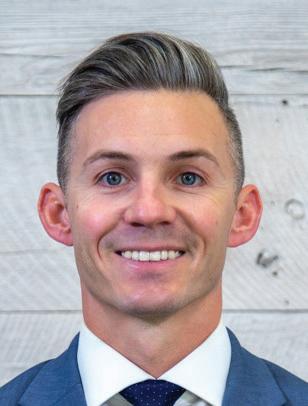
Jaime McAlpine President Chermac Energy Corporation

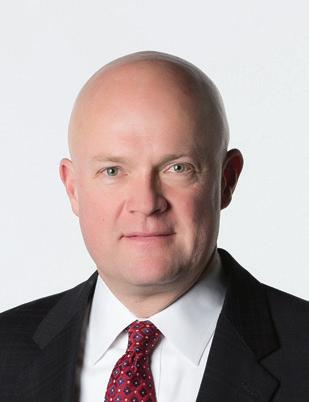
Mary ShaferMalicki Board of Directors: McDermott; QEP Resource; Ausenco

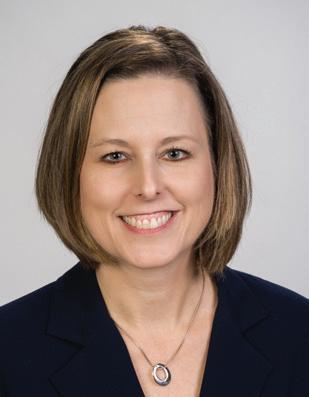

Wood PLC
Ed Stokes President Stokes International Consultancy LLC
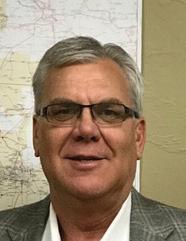


Paul Tikalsky Dean Oklahoma State University


Quantium New Energy
 Carrie Johnson Chair of the Board & Principal Wallace Architecture
Neal Jones President Jones Studio Architects
Mitch Johnson Vice President AI Technologies
Mike Rogers President PACCAR Winch Inc
Patricia Vega CEO and Founding Partner
Stacie Wrobbel Senior Executive Associate Pathfinder LLC
Rick Tompkins Partner LateraLift LLC
Carrie Johnson Chair of the Board & Principal Wallace Architecture
Neal Jones President Jones Studio Architects
Mitch Johnson Vice President AI Technologies
Mike Rogers President PACCAR Winch Inc
Patricia Vega CEO and Founding Partner
Stacie Wrobbel Senior Executive Associate Pathfinder LLC
Rick Tompkins Partner LateraLift LLC
Join our Dean’s Club!
Dean Paul Tikalsky invites you to become a member of the Dean’s Club!
You can join at either the College Club level, the Patron level, or the Benefactor level. These are distinguished groups whose gifts benefit the Designated Endowment Program Fund or the CEAT Scholars Program Fund, supporting our college’s top priorities and ensuring a bright future for our CEAT students.
Please consider making your gift today by returning the enclosed pledge form or visiting ceat.okstate.edu/giving/ceat-deans-club.html.
On behalf of our OSU community, you have our deepest appreciation for all you do for OSU and CEAT!
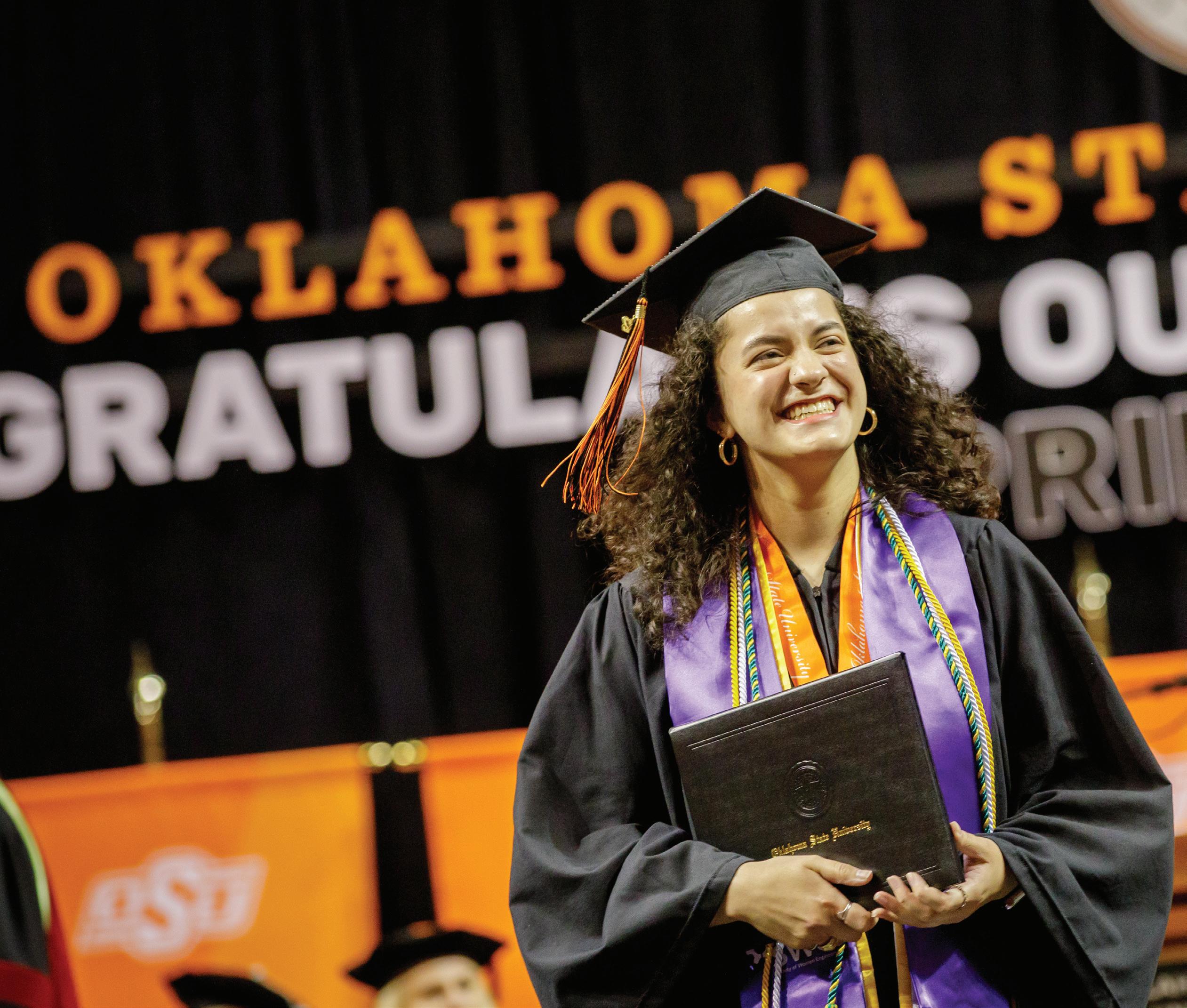
College of Engineering, Architecture and Technology 201 Advanced Technology Research Center Stillwater, OK 74078-5013 CEAT.OKSTATE.EDU GO POKES!

























































 STORY BAILEY SISK | PHOTO KRISTI WHEELER
STORY BAILEY SISK | PHOTO KRISTI WHEELER










































































































































 Dr. Ed Kirtley Associate Dean, Engineering Extension
Dr. Norb Delatte, P.E., F.ACI, F.ASCE Professor and Head
M.R. Lohmann Endowed Civil and Environmental Engineering
Dr. Guiping Hu Professor and Head Donald and Cathey Humphreys Chair Industrial Engineering and Management
Dr. Heather Fahlenkamp Professor and Head Anadarko Petroleum Chair Chemical Engineering
Dr. Sandip Harimkar Professor and Head Albert H. Nelson Jr. Chair Mechanical and Aerospace Engineering
Dr. James Smay Professor and Head Materials Science and Engineering
Dr. Je rey L. Young, P.E., F.IEEE Professor and Head OSURF Endowed Chair of Engineering Electrical and Computer Engineering
Dr. John Veenstra College Interim Dean
Dr. Sunderesh Heragu Associate Dean, Academic A airs
Dr. Raman Singh Associate Dean of Engineering, OSU-Tulsa Director, Helmerich Research Center
Dr. Chuck Bunting Associate Dean, Research
Dr. Ed Kirtley Associate Dean, Engineering Extension
Dr. Norb Delatte, P.E., F.ACI, F.ASCE Professor and Head
M.R. Lohmann Endowed Civil and Environmental Engineering
Dr. Guiping Hu Professor and Head Donald and Cathey Humphreys Chair Industrial Engineering and Management
Dr. Heather Fahlenkamp Professor and Head Anadarko Petroleum Chair Chemical Engineering
Dr. Sandip Harimkar Professor and Head Albert H. Nelson Jr. Chair Mechanical and Aerospace Engineering
Dr. James Smay Professor and Head Materials Science and Engineering
Dr. Je rey L. Young, P.E., F.IEEE Professor and Head OSURF Endowed Chair of Engineering Electrical and Computer Engineering
Dr. John Veenstra College Interim Dean
Dr. Sunderesh Heragu Associate Dean, Academic A airs
Dr. Raman Singh Associate Dean of Engineering, OSU-Tulsa Director, Helmerich Research Center
Dr. Chuck Bunting Associate Dean, Research
















 Gregg Bradshaw Construction Manager
Joe D. Hall General Contractors LLC
Cara Cowan Watts Chief Executive O cer Tulsa Drilling
Garen Ewbank President Ewbank Geo Testing
Steve Huckaby Chairman and Chief Executive O cer Meritage Midstream
Je Hume Vice Chairman of Strategic Growth Initiatives Continental Resources Inc.
Shay Braun President Select Milk Producers
Heath DePriest Vice President of Emerging Energy Phillips 66
Jim Hasenbeck Principal Architect Studio Architecture
Denay Huddleston Director, Batteries and Solar Phillips 66
Chris Humes Sr. Vice President, Operations and Engineering TC Energy
Je Fisher Chief Executive O cer Ascent Resources
Gregg Bradshaw Construction Manager
Joe D. Hall General Contractors LLC
Cara Cowan Watts Chief Executive O cer Tulsa Drilling
Garen Ewbank President Ewbank Geo Testing
Steve Huckaby Chairman and Chief Executive O cer Meritage Midstream
Je Hume Vice Chairman of Strategic Growth Initiatives Continental Resources Inc.
Shay Braun President Select Milk Producers
Heath DePriest Vice President of Emerging Energy Phillips 66
Jim Hasenbeck Principal Architect Studio Architecture
Denay Huddleston Director, Batteries and Solar Phillips 66
Chris Humes Sr. Vice President, Operations and Engineering TC Energy
Je Fisher Chief Executive O cer Ascent Resources











 Carrie Johnson Chair of the Board & Principal Wallace Architecture
Neal Jones President Jones Studio Architects
Mitch Johnson Vice President AI Technologies
Mike Rogers President PACCAR Winch Inc
Patricia Vega CEO and Founding Partner
Stacie Wrobbel Senior Executive Associate Pathfinder LLC
Rick Tompkins Partner LateraLift LLC
Carrie Johnson Chair of the Board & Principal Wallace Architecture
Neal Jones President Jones Studio Architects
Mitch Johnson Vice President AI Technologies
Mike Rogers President PACCAR Winch Inc
Patricia Vega CEO and Founding Partner
Stacie Wrobbel Senior Executive Associate Pathfinder LLC
Rick Tompkins Partner LateraLift LLC
